A Comprehensive Review of Group-III Nitride Light-Emitting Diodes: From Millimeter to Micro-Nanometer Scales
Abstract
:1. Introduction
2. Group-III Nitride Materials and Substrates
2.1. Properties of Group-III Nitride Materials
2.1.1. Crystal Structure of Group-III Nitride Materials
2.1.2. The Polarity of Group-III Nitride Materials
2.1.3. Group-III Nitride Alloy Materials and Luminescence
2.2. Substrates
2.2.1. Sapphire
2.2.2. Silicon
2.2.3. Silicon Carbide
2.2.4. Other Substrates
2.3. Material Growth Methods
2.4. The Source of Challenges
3. Ever-Improving Structures and Technologies
3.1. Substrate Treatment
3.1.1. Beveled Substrate
3.1.2. Patterned Sapphire Substrate
3.1.3. AlN Template
3.2. Planar Layer Structure
3.2.1. Semiconductor Superlattice
3.2.2. From Visible Light LEDs to Ultraviolet LEDs with MQWs Structure
Visible LEDs with InGaN/GaN MQWs
Ultraviolet LEDs with AlGaN/GaN MQWs
3.2.3. Epitaxial Lateral Overgrowth Technology
3.3. Nanowire and QD Structures
3.3.1. Nanowire Structure
Growth Method
The Conditions of Nanowire Growth in a Selective Area
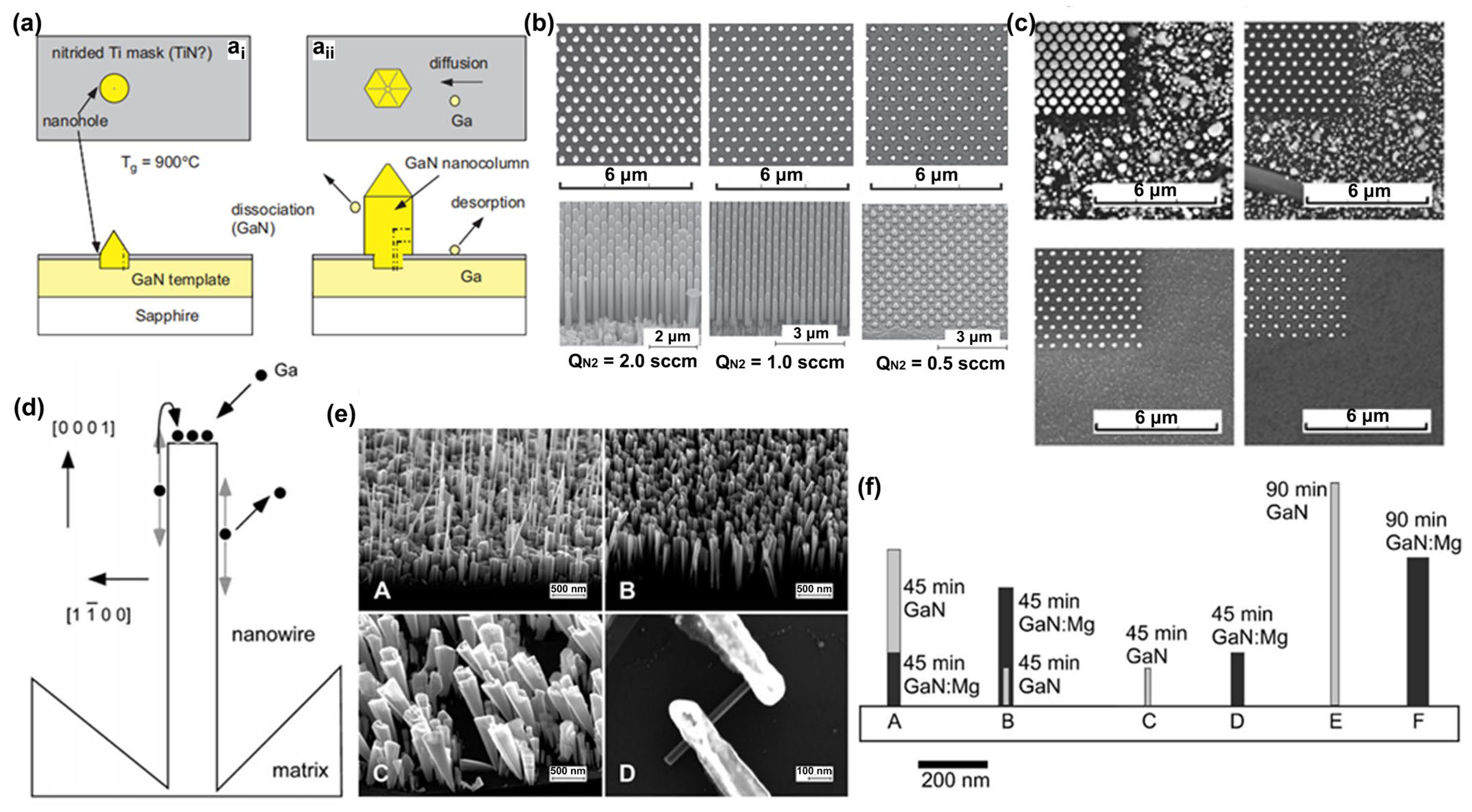
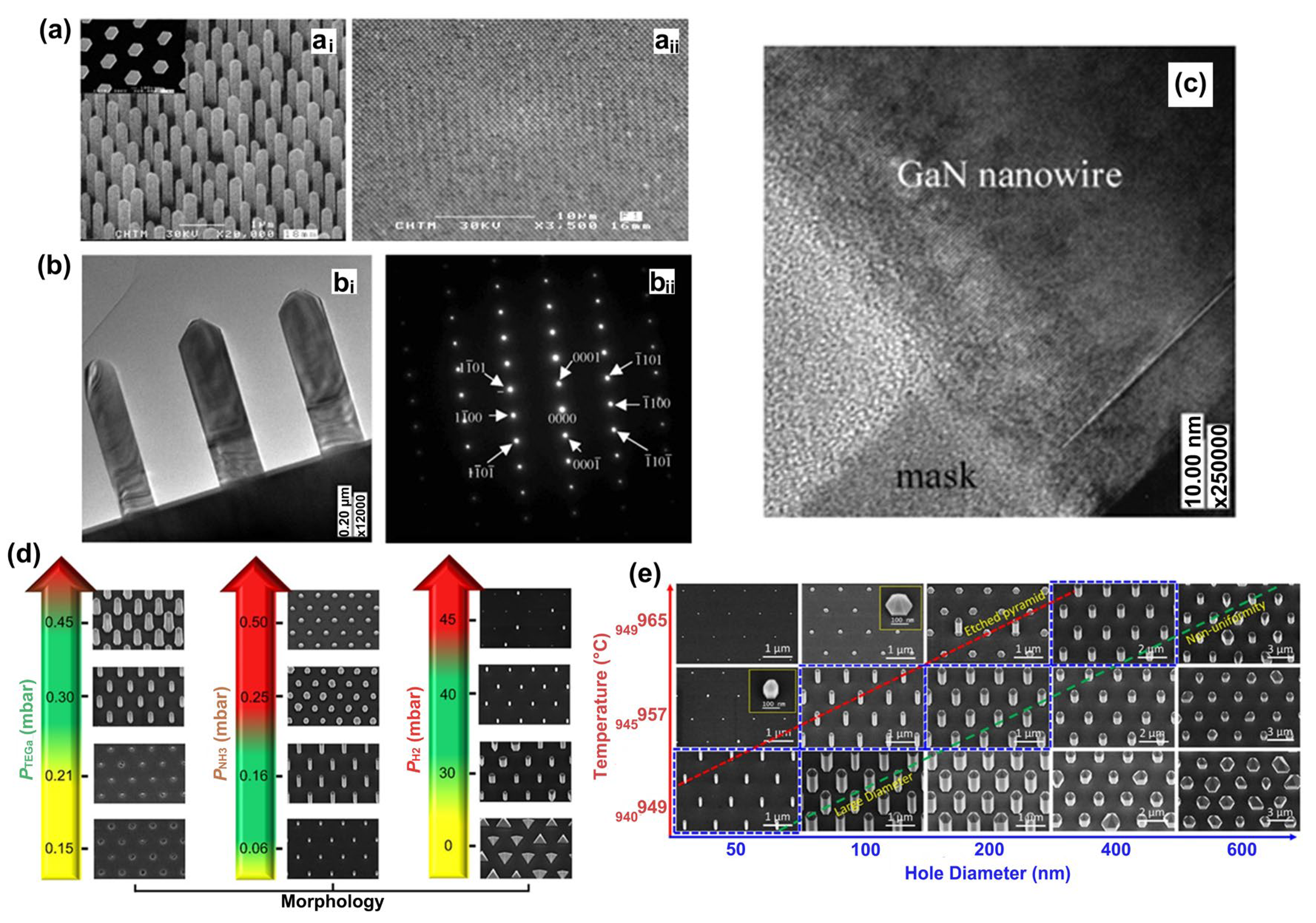
Advantages and Challenges of Nanowire LEDs
3.3.2. QDs
QDs for Ultraviolet and Infrared Luminescence
QDs for Visible Luminescence
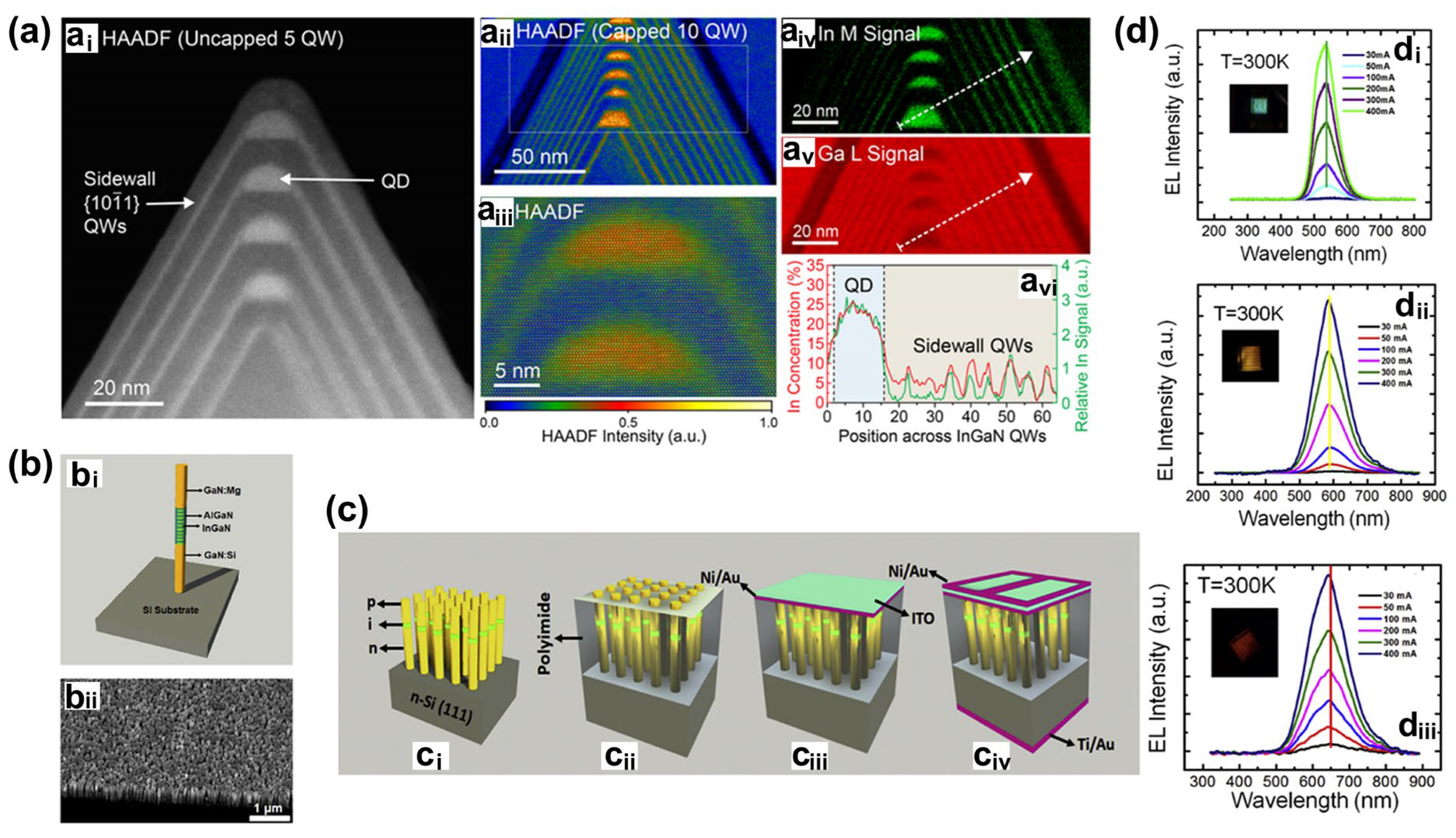
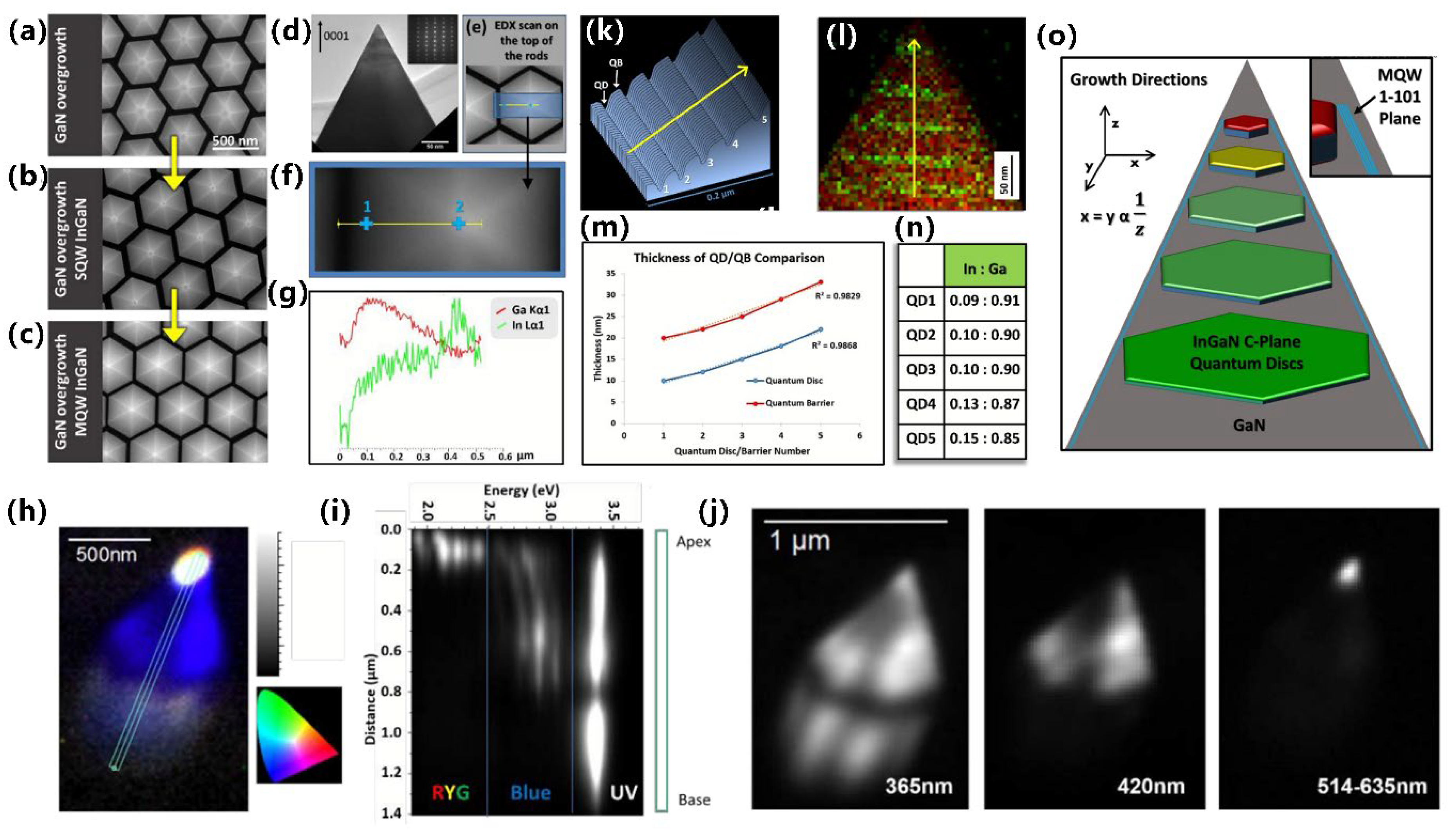
Properties-Based: Why We Chose QDs
3.4. P-Type Doping Technology
3.4.1. Semiconductor Superlattice Doping
3.4.2. Delta Doping
3.4.3. Polarization-Induced Doping
3.4.4. Future-Oriented Doping
4. Micro-LED
4.1. The Size Effect of Micro-LED
4.2. Quantum Efficiency
4.2.1. Efficiency Droop
4.2.2. Light Extraction Efficiency (LEE)
4.2.3. The Effect of Temperature on Quantum Efficiency
4.3. Spectral Characteristics
4.4. The Application of Micro-LED
4.4.1. Full-Color Display Technologies Based on Group-III Nitride Micro-LEDs
Color Conversion Technology Based on Group-III Nitride Materials
Mass Transfer and RGB Integration Technologies
4.4.2. Light Communication
| Wavelength [nm] | Modulation Bandwidth [MHz] | Highest Transmission Rate [Gpbs] | Type | Single Pixel Size [µm] | Distance [m] | BER [10−3] | Modulation Format | Application | Reference |
|---|---|---|---|---|---|---|---|---|---|
| 480 | 1000 | 4 | Single pixel µLED | 75 | 3 | 3.2 | QPSK-OFDM | Free space | [397] |
| 277 | 497.58 | 1.6 | Single pixel µLED | 40 | 1 | 3.4 | 16-QAM- OFDM | Free space | [398] |
| 475 | 1530 | 5.27 | Single pixel µLED | 60 | 1 | 3.1 | OFDM | Free space | [399] |
| 400 | 1200 | 5.71 | 3 × 3 µLED array | 20 | 13 | 3.7 | DCO-OFDM | Free space | [400] |
| 451 | 1200 | 4.86 | 3 × 3 µLED array | 20 | 13 | 3.3 | DCO-OFDM | Free space | [400] |
| 509 | 1050 | 4.39 | 3 × 3 µLED array | 20 | 13 | 3.7 | DCO-OFDM | Free space | [400] |
| 556 | 500 | 0.82 | 3 × 3 µLED array | 20 | 13 | 3.3 | DCO-OFDM | Free space | [400] |
| 276 | 439.5 | 2.28 | Single pixel µLED | 100 | 0.25 | 3.0 | OFDM | Free space | [401] |
| 276.8 | 452.53 | 2 | Single pixel µLED | 100 | 0.5 | 2.86 | 16-QAM-OFDM | Free space | [402] |
| 276.8 | 452.53 | 0.82 | Single pixel µLED | 100 | 3 | 16-QAM-OFDM | Free space | [402] | |
| 279 | 380 | 0.667 | 16 × 16 µLED array | 25 | 0.7 | 20 | OOK | Free space | [403] |
| 279 | 380 | 0.557 | 16 × 16 µLED array | 25 | 0.7 | 2 | OOK | Free space | [403] |
| 279 | 380 | 1.087 | 16 × 16 µLED array | 25 | 0.7 | 13 | 16-QAM-OFDM | Free space | [403] |
| 279 | 380 | 0.97 | 16 × 16 pixel array | 25 | 0.7 | 2 | 16-QAM-OFDM | Free space | [403] |
| 450 | 251.3 | 0.66 | Single pixel µLED with LD | 80 | 2.3 | 3.3 | NRZ-OOK | Underwater | [404] |
| Green light emission | 131 | 1.11 | Single pixel µLED | 80 | 3.4 | <3.8 | 16-QAM-OFDM | Underwater | [405] |
| 623/521/457/562/486 | 535/537.5/525/525/525 | 14.81 | Five-primary-color LED | 600 | 1.2 | <3.8 | 64-QAM-DMT | Underwater | [406] |
| 623/521/457/562/486 | 600/600/575/600/602.5 | 15.17 | Five-primary-color LED | 600 | 1.2 | <3.8 | Bit-loading-DMT | Underwater | [406] |

4.4.3. Charge Management Applications for Gravitational Wave Detection
4.4.4. Biomedicine
Public Health
Optogenetics
Optoelectronic Tweezers
Time-Resolved Fluorescence Measurement
4.4.5. White Light LEDs Illumination
5. Will Nano-LED Be the Future after Micro-LED?
5.1. Device Structure
5.2. Integration
5.3. Applications
6. Conclusions and Prospect
Funding
Conflicts of Interest
References
- Cai, Q.; You, H.; Guo, H.; Wang, J.; Liu, B.; Chen, D.; Lu, H.; Zheng, Y.; Zhang, R. Progress on AlGaN-based solar-blind ultraviolet photodetectors and focal plane arrays. Light Sci. Appl. 2021, 10, 94. [Google Scholar] [CrossRef] [PubMed]
- Nakamura, S.; Mukai, T.; Senoh, M. High-power GaN P-N junction blue-light-emitting diodes. Jpn. J. Appl. Phys. 1991, 30, L1998–L2001. [Google Scholar] [CrossRef]
- Nakamura, S.; Senoh, M.; Mukai, T. P-GaN/N-InGaN/N-GaN double-heterostructure blue-light-emitting diodes. Jpn. J. Appl. Phys. 1993, 32, L8–L11. [Google Scholar] [CrossRef]
- Jiang, H.X.; Lin, J.Y. Advances in III-nitride micro-size light emitters. III-Vs Rev. 2001, 14, 35–37. [Google Scholar] [CrossRef]
- Memon, M.H.; Yu, H.; Luo, Y.; Kang, Y.; Chen, W.; Li, D.; Luo, D.; Xiao, S.; Zuo, C.; Gong, C.; et al. A three-terminal light emitting and detecting diode. Nat. Electron. 2024, 7, 279–287. [Google Scholar] [CrossRef]
- Chang, W.; Kim, J.; Kim, M.; Lee, M.W.; Lim, C.H.; Kim, G.; Hwang, S.; Chang, J.; Min, Y.H.; Jeon, K.; et al. Concurrent self-assembly of RGB microLEDs for next-generation displays. Nature 2023, 617, 287–291. [Google Scholar] [CrossRef]
- Pandey, A.; Min, J.; Reddeppa, M.; Malhotra, Y.; Xiao, Y.; Wu, Y.; Sun, K.; Mi, Z. An ultrahigh efficiency excitonic micro-LED. Nano Lett. 2023, 23, 1680–1687. [Google Scholar] [CrossRef] [PubMed]
- Day, J.; Li, J.; Lie, D.Y.C.; Bradford, C.; Lin, J.Y.; Jiang, H.X. III-Nitride full-scale high-resolution microdisplays. Appl. Phys. Lett. 2011, 99, 031116. [Google Scholar] [CrossRef]
- Bonar, J.R.; Valentine, G.J.; Gong, Z.; Small, J.; Gorton, S. High-brightness low-power consumption microLED arrays. Int. Soc. Opt. Photonics 2016, 9768, 97680Y. [Google Scholar]
- Xiong, J.H.; Hsiang, E.L.; He, Z.Q.; Zhan, T.; Wu, S.T. Augmented reality and virtual reality displays: Emerging technologies and future perspectives. Light Sci. Appl. 2021, 10, 216. [Google Scholar] [CrossRef]
- Poher, V.; Grossman, N.; Kennedy, G.T.; Nikolic, K.; Zhang, H.X.; Gong, Z.; Drakakis, E.M.; Gu, E.; Dawson, M.D.; French, P.M.W.; et al. Micro-LED arrays: A tool for two-dimensional neuron stimulation. J. Phys. D Appl. Phys. 2008, 41, 094014. [Google Scholar] [CrossRef]
- Lin, J.Y.; Jiang, H.X. Development of microLED. Appl. Phys. Lett. 2020, 116, 100502. [Google Scholar] [CrossRef]
- Shin, J.; Sundaram, H.K.S.; Jeong, J.; Park, B.; Chang, C.S.; Choi, J.; Kim, T.; Saravanapavanantham, M.; Lu, K.; Kim, S.; et al. Vertical full-colour micro-LEDs via 2D materials-based layer transfer. Nature 2023, 614, 81–87. [Google Scholar] [CrossRef]
- Tietjen, J.J.; Clough, R.; Enstrom, R.E.; Ettenberg, M. Vapor Phase Growth Technique and System for Several III-V Compound Semiconductors; RCA Laboratories: Princeton, NJ, USA, 1969. [Google Scholar]
- Mohammad, S.N.; Morkoç, H. Progress and prospects of group-III nitride semiconductors. Prog. Quant. Electron. 1996, 20, 361–525. [Google Scholar] [CrossRef]
- Ambacher, O. Growth and applications of Group III-nitrides. J. Phys. D Appl. Phys. 1998, 31, 2653. [Google Scholar] [CrossRef]
- Chen, Y.; Zhang, Z.; Miao, G.; Jiang, H.; Li, Z.; Song, H. Epitaxial growth of polarization-graded AlGaN-based solar-blind ultraviolet photodetectors on pre-grown AlN templates. Mater. Lett. 2020, 281, 128638. [Google Scholar] [CrossRef]
- Yim, W.M.; Stofko, E.J.; Zanzucchi, P.J.; Pankove, J.I.; Ettenberg, M.; Gilbert, S.L. Epitaxially grown AlN and its optical band gap. J. Appl. Phys. 1973, 44, 292–296. [Google Scholar] [CrossRef]
- Kawashima, T.; Yoshikawa, H.; Adachi, S. Optical properties of hexagonal GaN. J. Appl. Phys. 1997, 82, 3528–3535. [Google Scholar] [CrossRef]
- Butcher, K.S.A.; Tansley, T.L. InN, latest development and a review of the band-gap controversy. Superlattices Microstruct. 2005, 38, 1–37. [Google Scholar] [CrossRef]
- Filatova, E.O.; Konashuk, A.S. Interpretation of the changing the band gap of Al2O3 depending on its crystalline form: Connection with different local symmetries. J. Phys. Chem. C 2015, 119, 20755–20761. [Google Scholar] [CrossRef]
- Liu, L.; Edgar, J.H. Substrates for gallium nitride epitaxy. Mater. Sci. Eng. R Rep. 2002, 37, 61–127. [Google Scholar] [CrossRef]
- Park, C.H.; Cheong, B.; Lee, K.; Chang, K.J. Structural and electronic properties of cubic, 2H, 4H, and 6H SiC. Phys. Rev. B 1994, 49, 4485. [Google Scholar] [CrossRef] [PubMed]
- Li, G.; Wan, W.; Yang, W.; Lin, Y.; Wang, H.; Lin, Z.; Zhou, S. GaN-based light-emitting diodes on various substrates: A critical review. Rep. Prog. Phys. 2016, 79, 056501. [Google Scholar] [CrossRef]
- Wang, W.; Yang, W.; Wang, H.; Li, G. Epitaxial growth of GaN films on unconventional oxide substrates. J. Mater. Chem. C 2014, 2, 9342–9358. [Google Scholar] [CrossRef]
- Chung, K.; Lee, C.; Yi, G. Transferable GaN Layers Grown on ZnO-Coated Graphene Layers for Optoelectronic Devices. Science 2010, 330, 655. [Google Scholar] [CrossRef] [PubMed]
- Shon, J.W.; Ohta, J.; Ueno, K.; Kobayashi, A.; Fujioka, H. Fabrication of full-color InGaN-based light-emitting diodes on amorphous substrates by pulsed sputterin. Sci. Rep. 2014, 4, 5325. [Google Scholar] [CrossRef] [PubMed]
- Yu, J.; Hao, Z.; Deng, J.; Wang, L.; Luo, Y.; Wang, J.; Sun, C.; Han, Y.; Xiong, B.; Li, H. Transferable InGaN quantum well grown at low temperature on amorphous substrates by plasma-assisted molecular beam epitaxy. Cryst. Growth Des. 2021, 21, 3831–3837. [Google Scholar] [CrossRef]
- Choi, J.H.; Zoulkarneev, A.; Kim, S.I.; Baik, C.W.; Yang, M.H.; Park, S.S.; Suh, H.; Kim, U.J.; Son, H.B.; Lee, J.S.; et al. Nearly single-crystalline GaN light-emitting diodes on amorphous glass substrates. Nat. Photonics 2011, 5, 763–769. [Google Scholar] [CrossRef]
- Maruska, H.P.; Tietjen, J.J. The preparation and properties of vapor-deposited single-crystalline GaN. Appl. Phys. Lett. 1969, 15, 327–329. [Google Scholar] [CrossRef]
- Yoshida, S.; Misawa, S.; Gonda, S. Improvements on the electrical and luminescent properties of reactive molecular beam epitaxially grown GaN films by using AlN-coated sapphire substrates. Appl. Phys. Lett. 1983, 42, 427–429. [Google Scholar] [CrossRef]
- Amano, H.; Sawaki, N.; Akasaki, I. Metalorganic vapor phase epitaxial growth of a high quality GaN film using an AlN buffer layer. Appl. Phys. Lett. 1986, 48, 353–355. [Google Scholar] [CrossRef]
- Nakamura, S.; Harada, Y.; Seno, M. Novel metalorganic chemical vapor deposition system for GaN growth. Appl. Phys. Lett. 1991, 58, 2021–2023. [Google Scholar] [CrossRef]
- Hu, H.; Zhang, B.; Wu, Y.; Shao, Y.; Liu, L.; Hao, X. High-quality GaN crystal grown on laser decomposed GaN-sapphire substrate and its application in photodetector. Phys. Status Solidi A 2020, 217, 2000380. [Google Scholar] [CrossRef]
- Yin, X.; Zhang, Q.; Zhao, S. Molecular beam epitaxial growth of AlN thin films on Si through exploiting low Al adatom migration and the nitrogen-rich environment on a nanowire template. Cryst. Growth Des. 2021, 21, 3645–3649. [Google Scholar] [CrossRef]
- Lee, M.; Mikulik, D.; Yang, M.; Park, S. The investigation of stress in freestanding GaN crystals grown from Si substrates by HVPE. Sci. Rep. 2017, 7, 8587. [Google Scholar] [CrossRef]
- Tian, Y.; Shao, Y.; Wu, Y.; Hao, X.; Zhang, L.; Dai, Y.; Huo, Q. Direct growth of freestanding GaN on C-face SiC by HVPE. Sci. Rep. 2015, 5, 10748. [Google Scholar] [CrossRef]
- Li, Y.; Hu, X.; Song, Y.; Su, Z.; Wang, W.; Jia, H.; Wang, W.; Jiang, Y.; Chen, H. Epitaxy N-polar GaN on vicinal Sapphire substrate by MOCVD. Vacuum 2021, 189, 110173. [Google Scholar] [CrossRef]
- Su, Z.; Kong, R.; Hu, X.; Song, Y.; Deng, Z.; Jiang, Y.; Li, Y.; Chen, H. Effect of initial condition on the quality of GaN film and AlGaN/GaN heterojunction grown on flat sapphire substrate with ex-situ sputtered AlN by MOCVD. Vacuum 2022, 201, 111063. [Google Scholar] [CrossRef]
- Li, Y.; Wang, W.; Li, X.; Huang, L.; Lin, Z.; Zheng, Y.; Chen, X.; Li, G. Stress and dislocation control of GaN epitaxial films grown on Si substrates and their application in high-performance light-emitting diodes. J. Alloys Compd. 2019, 771, 1000–1008. [Google Scholar] [CrossRef]
- Khan, R.; Bag, R.K.; Narang, K.; Pandey, A.; Dalal, S.; Singh, V.K.; Saini, S.K.; Padmavati, M.V.G.; Tyagi, R.; Riaz, U. Effect of fully strained AlN nucleation layer on the AlN/SiC interface and subsequent GaN growth on 4H–SiC by MOVPE. J. Mater. Sci. Mater. Electron. 2019, 30, 18910–18918. [Google Scholar] [CrossRef]
- Liu, F.; Zhang, Z.; Rong, X.; Yu, Y.; Wang, T.; Sheng, B.; Wei, J.; Zhou, S.; Yang, X.; Xu, F.; et al. Graphene-assisted epitaxy of nitrogen lattice polarity GaN films on non-polar sapphire substrates for green light emitting diodes. Adv. Funct. Mater. 2020, 30, 2001283. [Google Scholar] [CrossRef]
- Wu, Y.; Wang, Y.; Sun, K.; Aiello, A.; Bhattacharya, P.; Mi, Z. Molecular beam epitaxy and characterization of Mg-doped GaN epilayers grown on Si (001) substrate through controlled nanowire coalescence. J. Cryst. Growth 2018, 498, 109–114. [Google Scholar] [CrossRef]
- Susanto, I.; Kan, K.; Yu, I. Temperature effects for GaN films grown on 4H-SiC substrate with 4° miscutting orientation by plasma-assisted molecular beam epitaxy. J. Alloys Compd. 2017, 723, 21–29. [Google Scholar] [CrossRef]
- Xiao, S.; Jiang, N.; Shojiki, K.; Uesugi, K.; Miyake, H. Preparation of high-quality thick AlN layer on nanopatterned sapphire substrates with sputter-deposited annealed AlN film by hydride vapor-phase epitaxy. Jpn. J. Appl. Phys. 2019, 58, SC1003. [Google Scholar] [CrossRef]
- Zhang, Q.; Xu, L.; Zhao, J.; Sun, Z.; Lu, Y.; Liu, T.; Zhang, J. Effect of high-temperature nitridation and buffer layer on semi-polar (10-13) AlN grown on sapphire by HVPE. Micromachines 2021, 12, 1153. [Google Scholar] [CrossRef]
- Chen, J.J.; Su, X.J.; Huang, J.; Niu, M.T.; Xu, K. Effects of 6H-SiC substrate polarity on the morphology and microstructure of AlN films by HVPE with varied V/III ratio. J. Cryst. Growth 2019, 507, 196–199. [Google Scholar] [CrossRef]
- Kuboya, S.; Uesugi, K.; Shojiki, K.; Tezen, Y.; Norimatsu, K.; Miyake, H. Crystalline quality improvement of face-to-face annealed MOVPE-grown AlN on vicinal sapphire substrate with sputtered nucleation layer. J. Cryst. Growth 2020, 545, 125722. [Google Scholar] [CrossRef]
- Fujikura, H.; Konno, T.; Kimura, T. Hydride vapor phase epitaxial growth of AlGaN. Appl. Phys. Express 2022, 15, 085504. [Google Scholar] [CrossRef]
- Shen, J.; Yang, X.; Liu, D.; Cai, Z.; Wei, L.; Xie, N.; Xu, F.; Tang, N.; Wang, X.; Ge, W.; et al. High quality AlN film grown on a nano-concave-circle patterned Si substrate with an AlN seed layer. Appl. Phys. Lett. 2020, 117, 022103. [Google Scholar] [CrossRef]
- Uesugi, K.; Hayashi, Y.; Shojiki, K.; Xiao, S.; Nagamatsu, K.; Yoshida, H.; Miyake, H. Fabrication of AlN templates on SiC substrates by sputtering-deposition and high-temperature annealing. J. Cryst. Growth 2019, 510, 13–17. [Google Scholar] [CrossRef]
- Narang, K.; Pandey, A.; Khan, R.; Singh, V.K.; Bag, R.K.; Padmavati, M.V.G.; Tyagi, R.; Singh, R. High-quality AlN nucleation layer on SiC substrate grown by MOVPE: Growth, structural and optical characteristics. Mater. Sci. Eng. B 2022, 278, 115635. [Google Scholar] [CrossRef]
- Zhao, L.; Yang, K.; Ai, Y.; Zhang, L.; Niu, X.; Lv, H.; Zhang, Y. Crystal quality improvement of sputtered AlN film on sapphire substrate by high-temperature annealing. J. Mater. Sci. Mater. Electron. 2018, 29, 13766–13773. [Google Scholar] [CrossRef]
- Zhang, Z.; Hayashi, Y.; Tohei, T.; Sakai, A.; Protasenko, V.; Singhal, J.; Miyake, H.; Xin, H.G.; Jena, D.; Cho, Y. Molecular beam homoepitaxy of N-polar AlN: Enabling role of aluminum-assisted surface cleaning. Sci. Adv. 2022, 8, eabo6408. [Google Scholar] [CrossRef] [PubMed]
- Zhao, Y.; Xu, S.; Feng, L.; Peng, R.; Fan, X.; Du, J.; Su, H.; Zhang, J.; Hao, Y. The performance improvement of AlGaN/GaN heterojunction by using nano-patterned sapphire substrate. Mater. Sci. Semicond. Process. 2022, 143, 106535. [Google Scholar] [CrossRef]
- Uesugi, K.; Shojiki, K.; Tezen, Y.; Hayashi, Y.; Miyake, H. Suppression of dislocation-induced spiral hillocks in MOVPE-grown AlGaN on face-to-face annealed sputter-deposited AlN template. Appl. Phys. Lett. 2020, 116, 062101. [Google Scholar] [CrossRef]
- Demir, I.; Koçak, Y.; Kasapoğlu, A.E.; Razeghi, M.; Gür, E.; Elagoz, S. AlGaN/AlN MOVPE heteroepitaxy: Pulsed co-doping SiH4 and TMIn. Semicond. Sci. Technol. 2019, 34, 075028. [Google Scholar] [CrossRef]
- Tao, P.; Liang, H.; Xia, X.; Chen, Y.; Yang, C.; Liu, J.; Zhu, Z.; Shen, R.; Luo, Y.; Zhang, Y.; et al. Crack-free Al0.5Ga0.5N epilayer grown on SiC substrate by in situ SiNx interlayer. Mater. Sci. Semicond. Process. 2016, 41, 291–296. [Google Scholar] [CrossRef]
- Nasir, A.; Zhang, X.; Lu, L.; Zhang, J.; Lyu, J.; Cui, Y. Enhanced crystalline quality of non-polar a-plane AlGaN epitaxial film grown with Al-composition-graded AlGaN intermediate layer. Mater. Res. Express 2021, 8, 055901. [Google Scholar] [CrossRef]
- Laleyan, D.A.; Liu, X.; Pandey, A.; Shin, W.J.; Reid, E.T.; Mashooq, K.; Soltani, M.; Mi, Z. Molecular beam epitaxy and characterization of Al0.6Ga0.4N epilayers. J. Cryst. Growth 2019, 507, 87–92. [Google Scholar] [CrossRef]
- Hao, Y.; Zhang, J.F.; Zhang, J.C. Nitride Wide Bandgap Semiconductor Materials and Electronic Devices; Science Press: Beijing, China, 2013. [Google Scholar]
- Xu, M.; Xu, H.; Shen, Y.; Hu, X.; Xu, X. Effect of beveled SiC substrate on light extraction of flip-chip light-emitting diodes. IEEE Photonics Technol. Lett. 2014, 26, 1053–1056. [Google Scholar]
- Horng, R.; Hu, H.; Ou, S.; Lin, R.; Hsu, C. Enhancement of light extraction for InGaN LEDs by means of beveled sapphire and cup-shaped copper sheeting. IEEE Photonics Technol. Lett. 2012, 24, 1421–1423. [Google Scholar] [CrossRef]
- Wuu, D.S.; Wang, W.K.; Shin, W.C.; Horng, R.H.; Lee, C.E.; Lin, W.Y.; Fang, J.S. Enhanced output power of near-ultraviolet InGaN-GaN LEDs grown on patterned sapphire substrates. IEEE Photonics Technol. Lett. 2005, 17, 288–290. [Google Scholar] [CrossRef]
- Cheng, J.H.; Wu, Y.S.; Liao, W.C.; Lin, B.W. Improved crystal quality and performance of GaN-based light-emitting diodes by decreasing the slanted angle of patterned sapphire. Appl. Phys. Lett. 2010, 96, 051109. [Google Scholar] [CrossRef]
- Lee, J.; Oh, J.T.; Kim, Y.C.; Lee, J. Stress reduction and enhanced extraction efficiency of GaN-based LED grown on cone-shape-patterned sapphire. IEEE Photonics Technol. Lett. 2008, 20, 1563–1565. [Google Scholar] [CrossRef]
- Su, Y.K.; Chen, J.J.; Lin, C.L.; Chen, S.M.; Li, W.L.; Kao, C.C. Pattern-size dependence of characteristics of nitride-based LEDs grown on patterned sapphire substrates. J. Cryst. Growth 2009, 311, 2973–2976. [Google Scholar] [CrossRef]
- Su, Y.K.; Chen, J.J.; Lin, C.L.; Kao, C.C. Structural analysis of nitride-based LEDs grown on micro- and nano-scale patterned sapphire substrates. Phys. Status Solidi C 2010, 7, 1784–1786. [Google Scholar] [CrossRef]
- Zhou, S.; Zhao, X.; Du, P.; Zhang, Z.; Liu, X.; Liu, S.; Guo, L.J. Application of patterned sapphire substrate for III-nitride light-emitting diodes. Nanoscale 2022, 14, 4887–4907. [Google Scholar] [CrossRef] [PubMed]
- Chiu, C.; Lin, C.; Deng, D.; Lin, D.; Li, J.; Li, Z.; Shu, G.; Lu, T.; Shen, J.; Kuo, H.; et al. Optical and Electrical Properties of GaN-Based Light Emitting Diodes Grown on Micro- and Nano-Scale Patterned Si Substrate. IEEE J. Quantum Electron. 2011, 47, 899–906. [Google Scholar] [CrossRef]
- Zhang, B.; Liang, H.; Wang, Y.; Feng, Z.; Ng, K.W.; Lau, K.M. High-performance III-nitride blue LEDs grown and fabricated on patterned Si substrates. J. Cryst. Growth 2007, 298, 725–730. [Google Scholar] [CrossRef]
- Chen, Y.; Zhang, Z.; Jiang, H.; Li, Z.; Miao, G.; Song, H. The optimized growth of AlN templates for back-illuminated AlGaN-based solar-blind ultraviolet photodetectors by MOCVD. J. Mater. Chem. C 2018, 6, 4936–4942. [Google Scholar] [CrossRef]
- Yoshikawa, A.; Nagatomi, T.; Morishita, T.; Iwaya, M.; Takeuchi, T.; Kamiyama, S.; Akasaki, I. High-quality AlN film grown on a nanosized concave–convex surface sapphire substrate by metalorganic vapor phase epitaxy. Appl. Phys. Lett. 2017, 111, 162102. [Google Scholar] [CrossRef]
- Esaki, L.; Tsu, R. Superlattice and negative differential conductivity in semiconductors. IMB J. Res. Dev. 1970, 14, 61–65. [Google Scholar] [CrossRef]
- Blakeslee, A.E.; Aliotta, C.F. Man-made superlattice crystals. IMB J. Res. Dev. 1970, 14, 686–688. [Google Scholar] [CrossRef]
- Kubota, K.; Kobayashi, Y.; Fujimoto, K. Preparation and properties of III-V nitride thin films. J. Appl. Phys. 1989, 66, 2984–2988. [Google Scholar] [CrossRef]
- Bykhovski, A.; Gelmont, B.; Shur, M. The influence of the strain-induced electric field on the charge distribution in GaN-AlN-GaN structure. J. Appl. Phys. 1993, 74, 6734–6739. [Google Scholar] [CrossRef]
- Bykhovski, A.D.; Gelmont, B.L.; Shur, M.S. Elastic strain relaxation in GaN-AlN-GaN semiconductor-insulator-semiconductor structures. J. Appl. Phys. 1995, 78, 3691–3696. [Google Scholar] [CrossRef]
- Bykhovski, A.D.; Gelmont, B.L.; Shur, M.S. Elastic strain relaxation and piezoeffect in GaN-AlN, GaN-AlGaN and GaN-InGaN superlattices. J. Appl. Phys. 1997, 81, 6332–6338. [Google Scholar] [CrossRef]
- Kandaswamy, P.K.; Guillot, F.; Bellet-Amalric, E.; Monroy, E.; Nevou, L.; Tchernycheva, M.; Michon, A.; Julien, F.H.; Baumann, E.; Giorgetta, F.R.; et al. GaN/AlN short-period superlattices for intersubband optoelectronics: A systematic study of their epitaxial growth, design, and performance. J. Appl. Phys. 2008, 104, 093501. [Google Scholar] [CrossRef]
- Nakamura, T.; Mochizuki, S.; Terao, S.; Sano, T.; Iwaya, M.; Kamiyama, S.; Amano, H.; Akasaki, I. Structural analysis of Si-doped AlGaN/GaN multi-quantum wells. J. Cryst. Growth 2002, 237–239, 1129–1132. [Google Scholar] [CrossRef]
- Hermann, M.; Monroy, E.; Helman, A.; Baur, B.; Albrecht, M.; Daudin, B.; Ambacher, O.; Stutzmann, M.; Eickhoff, M. Vertical transport in group III-nitride heterostructures and application in AlN/GaN resonant tunneling diodes. Phys. Status Solidi C 2004, 1, 2210–2227. [Google Scholar] [CrossRef]
- Northrup, J.E.; Neugebauer, J. Indium-induced changes in GaN (0001) surface morphology. Phys. Rev. B 1999, 60, R8473. [Google Scholar] [CrossRef]
- Song, T.L. Strain relaxation due to V-pit formation in InxGa1-xN∕GaN epilayers grown on sapphire. J. Appl. Phys. 2005, 98, 084906. [Google Scholar] [CrossRef]
- Kandaswamy, P.K.; Bougero, C.; Jalabert, D.; Ruterana, P.; Monroy, E. Strain relaxation in short-period polar GaN/AlN superlattices. J. Appl. Phys. 2009, 106, 013526. [Google Scholar] [CrossRef]
- Kotsar, Y.; Doisneau, B.; Bellet-Amalric, E.; Das, A.; Sarigiannidou, E.; Monroy, E. Strain relaxation in GaN/AlxGa1-xN superlattices grown by plasma-assisted molecular-beam epitaxy. J. Appl. Phys. 2011, 110, 033501. [Google Scholar] [CrossRef]
- Kotsar, Y.; Kandaswam, P.K.; Das, A.; Sarigiannidou, E.; Bellet-Amalric, E.; Monroy, E. Strain relaxation in GaN/Al0.1Ga0.9N superlattices for mid-infrared intersubband absorption. J. Cryst. Growth 2011, 323, 64–67. [Google Scholar] [CrossRef]
- Leem, S.J.; Shin, Y.C.; Kim, K.C.; Kim, E.H.; Sung, Y.M.; Moon, Y.; Hwang, S.M.; Kim, T.G. The effect of the low-mole InGaN structure and InGaN/GaN strained layer superlattices on optical performance of multiple quantum well active layers. J. Cryst. Growth 2008, 311, 103–106. [Google Scholar] [CrossRef]
- Matsumoto, T.; Khan, M.A.; Maeda, N.; Fujikaw, S.; Kamata, N.; Hirayama, H. Milliwatt power UV-A LEDs developed by using n-AlGaN superlattice buffer layers grown on AlN templates. J. Phys. D Appl. Phys. 2019, 52, 115102. [Google Scholar] [CrossRef]
- Jia, C.; Yu, T.; Feng, X.; Wang, K.; Zhang, G. Performance improvement of GaN-based near-UV LEDs with InGaN/AlGaN superlattices strain relief layer and AlGaN barrier. Superlattices Microstruct. 2016, 97, 417–423. [Google Scholar] [CrossRef]
- Park, J.H.; Kim, D.Y.; Hwang, S.; Meyaard, D.; Schubert, E.F.; Han, Y.D.; Choi, J.W.; Cho, J.; Kim, J.K. Enhanced overall efficiency of GaInN-based light-emitting diodes with reduced efficiency droop by Al-composition-graded AlGaN/GaN superlattice electron blocking layer. Appl. Phys. Lett. 2013, 103, 061104. [Google Scholar] [CrossRef]
- Yao, Y.; Zollner, C.J.; Wang, M.; Iza, M.; Speck, J.S.; DenBaars, S.P.; Nakamura, S. Polarization-enhanced p-AlGaN superlattice optimization for GUV LED. IEEE J. Quantum Elect. 2022, 58, 3300409. [Google Scholar] [CrossRef]
- Huang, Y.; Li, P.; Yang, Z.; Hao, Y.; Wang, X. High efficiency and enhanced ESD properties of UV LEDs by inserting p-GaN/p-AlGaN superlattice. Sci. China Phys. Mech. 2014, 57, 887–891. [Google Scholar] [CrossRef]
- Wen, T.C.; Chang, S.J.; Lee, C.T.; Lai, W.C.; Sheu, J.K. Nitride-based LEDs with modulation-doped Al/sub 0.12/Ga/sub 0.88/N-GaN superlattice structures. IEEE Trans. Electron Devices 2004, 51, 1743–1746. [Google Scholar] [CrossRef]
- Kang, J.; Li, H.; Li, Z.; Liu, Z.; Ma, P.; Yi, X.; Wang, G. Enhancing the performance of green GaN-based light-emitting diodes with graded superlattice AlGaN/GaN inserting layer. Appl. Phys. Lett. 2013, 103, 102104. [Google Scholar] [CrossRef]
- Waltereit, P.; Brandt, O.; Trampert, A.; Grahn, H.T.; Menniger, J.; Ramsteiner, M.; Reiche, M.; Ploog, K.H. Nitride semiconductors free of electrostatic fields for efficient white light-emitting diodes. Nature 2000, 406, 865–868. [Google Scholar] [CrossRef] [PubMed]
- Badcock, T.J.; Ali, M.; Zhu, T.; Pristovsek, M.; Oliver, R.A.; Shields, A.J. Radiative recombination mechanisms in polar and non-polar InGaN/GaN quantum well LED structures. Appl. Phys. Lett. 2016, 109, 151110. [Google Scholar] [CrossRef]
- Hammersley, S.; Kappers, M.J.; Massabuau, F.C.-P.; Sahonta, S.-L.; Dawson, P.; Oliver, R.A.; Humphreys, C.J. Effects of quantum well growth temperature on the recombination efficiency of InGaN/GaN multiple quantum wells that emit in the green and blue spectral regions. Appl. Phys. Lett. 2015, 107, 132106. [Google Scholar] [CrossRef]
- Deng, Z.; Jiang, Y.; Wang, W.; Cheng, L.; Li, W.; Lu, W.; Jia, H.; Liu, W.; Zhou, J.; Chen, H. Indium segregation measured in InGaN quantum well layer. Sci. Rep. 2014, 4, 6734. [Google Scholar] [CrossRef]
- Uedono, A.; Ishibashi, S.; Oshima, N.; Suzuki, R.; Sumiya, M. Point defect characterization of group-III nitrides by using monoenergetic positron beams. ECS Trans. 2014, 61, 19. [Google Scholar] [CrossRef]
- Nag, D.; Bhunia, S.; Sarkar, R.; Chatterjee, S.; Laha, A. Investigating defects in InGaN based optoelectronics: From material and device perspective. Mater. Res. Express 2023, 10, 024004. [Google Scholar] [CrossRef]
- Mishra, T.P.; Syaranamual, G.J.; Deng, Z.; Chung, J.Y.; Zhang, L.; Goodman, S.A.; Jones, L.; Bosman, M.; Gradečak, S.; Pennycook, S.J.; et al. Unlocking the origin of compositional fluctuations in InGaN light emitting diodes. Phys. Rev. Mater. 2021, 5, 024605. [Google Scholar] [CrossRef]
- Tanner, D.S.P.; Dawson, P.; Kappers, M.J.; Oliver, R.A.; Schulz, S. Polar (In,Ga)N/GaN quantum well: Revisiting the impact of carrier localization on the “Green gap” problem. Phys. Rev. Appl. 2020, 13, 044068. [Google Scholar] [CrossRef]
- Karpov, S.Y. Carrier localization in InGaN by composition fluctuations: Implication to the “green gap”. Photonics Res. 2017, 5, A7–A12. [Google Scholar] [CrossRef]
- Jones, C.M.; Teng, C.; Yan, Q.; Ku, P.; Kioupakis, E. Impact of carrier localization on recombination in InGaN quantum wells and the efficiency of nitride light-emitting diodes: Insights from theory and numerical simulations. Appl. Phys. Lett. 2017, 111, 113501. [Google Scholar] [CrossRef]
- Lin, T.; Kuo, H.C.; Jiang, X.D.; Feng, Z.C. Recombination pathways in green InGaN/GaN multiple quantum wells. Nanoscale Res. Lett. 2017, 12, 137. [Google Scholar] [CrossRef] [PubMed]
- Tan, A.K.; Hamzah, N.A.; Ahmad, M.A.; Ng, S.S.; Hassan, Z. Recent advances and challenges in the MOCVD growth of indium gallium nitride: A brief review. Mater. Sci. Semicond. Proc. 2022, 143, 106545. [Google Scholar] [CrossRef]
- Liu, Z.Y.; Lu, Y.; Cao, H.C.; Maciel Garcia, G.I.; Liu, T.G.; Tang, X.; Xiao, N.; Aguileta, R.A.; Nong, M.T.; Li, X.H. Etching-free pixel definition in InGaN green micro-LEDs. Light Sci. Appl. 2024, 13, 117. [Google Scholar] [CrossRef]
- Wang, Y.; Zhang, X.; Luan, H.; Yang, H.; Wang, S.; Dai, Q.; Wu, Z.; Cui, Y. Effects of Si-doping on structural and electrical characteristics of polar, semi-polar, and non-polar AlGaN epi-layers. Mater. Sci. Semicond. Proc. 2016, 42, 344–348. [Google Scholar] [CrossRef]
- Zhao, Y.; Fu, H.; Wang, G.T.; Nakamura, S. Toward ultimate efficiency: Progress and prospects on planar and 3D nanostructured nonpolar and semipolar InGaN light-emitting diodes. Adv. Opt. Photonics 2018, 10, 246–308. [Google Scholar] [CrossRef]
- Kako, S.; Holme, M.; Sergent, S.; Bürger, M.; As, D.J.; Arakawa, Y. Single-photon emission from cubic GaN quantum dots. Appl. Phys. Lett. 2014, 104, 011101. [Google Scholar] [CrossRef]
- Kemper, R.M.; Schupp, T.; Häberlen, M.; Niendorf, T.; Maier, H.; Dempewolf, A.; Bertram, F.; Christen, J.; Kirste, R.; Hoffmann, A.; et al. Anti-phase domains in cubic GaN. J. Appl. Phys. 2011, 110, 123512. [Google Scholar] [CrossRef]
- Farrell, R.M.; Young, E.C.; Wu, F.; DenBaars, S.P.; Speck, J.S. Materials and growth issues for high-performance nonpolar and semipolar light-emitting devices. Semicond. Sci. Technol. 2012, 27, 024001. [Google Scholar] [CrossRef]
- Paisley, M.J.; Sitar, Z.; Posthill, J.B.; Davis, R.F. Growth of cubic phase gallium nitride by modified molecular-beam epitaxy. J. Vac. Sci. Technol. A 1989, 7, 701–705. [Google Scholar] [CrossRef]
- Su, V.; Chen, P.; Lin, R.; Lee, M.; You, Y.; Ho, C.; Chen, Y.; Chen, W.; Kuan, C. Suppressed quantum-confined Stark effect in InGaN-based LEDs with nano-sized patterned sapphire substrates. Opt. Express 2013, 21, 30065–30073. [Google Scholar] [CrossRef]
- Sirkeli, V.P.; Yilmazoglu, O.; Al-Daffaie, S.; Ong, I.O.D.S.; Küppers, F.; Hartnagel, H.L. Efficiency enhancement of InGaN/GaN light-emitting diodes with pin-doped GaN quantum barrier. J. Phys. D Appl. Phys. 2017, 50, 035108. [Google Scholar] [CrossRef]
- Zhang, Z.; Liu, W.; Ju, Z.; Tan, S.T.; Ji, Y.; Kyaw, Z.; Zhang, X.; Wang, L.; Sun, X.W.; Demir, H.V. Polarization self-screening in [0001] oriented InGaN/GaN light-emitting diodes for improving the electron injection efficiency. Appl. Phys. Lett. 2014, 104, 243501. [Google Scholar] [CrossRef]
- Zhang, F.; Can, N.; Hafiz, S.; Monavarian, M.; Das, S.; Avrutin, V.; Özgür, Ü. Improvement of carrier injection symmetry and quantum efficiency in InGaN light-emitting diodes with Mg delta-doped barriers. Appl. Phys. Lett. 2015, 106, 181105. [Google Scholar] [CrossRef]
- Hönig, G.M.O.; Westerkamp, S.; Hoffmann, A.; Callsen, G. Shielding Electrostatic Fields in Polar Semiconductor Nanostructures. Phys. Rev. Appl. 2017, 7, 024004. [Google Scholar] [CrossRef]
- Hille, P.; Müßener, J.; Becker, P.; de la Mata, M.; Rosemann, N.; Magén, C.; Arbiol, J.; Teubert, J.; Chatterjee, S.; Schörmann, J.; et al. Screening of the quantum-confined Stark effect in AlN/GaN nanowire superlattices by germanium doping. Appl. Phys. Lett. 2014, 104, 10210. [Google Scholar] [CrossRef]
- Schlichting, S.; Hönig, G.M.O.; Müßener, J.; Hille, P.; Grieb, T.; Westerkamp, S.; Teubert, J.; Schörmann, J.; Wagner, M.R.; Rosenauer, A.; et al. Suppression of the quantum-confined Stark effect in polar nitride heterostructures. Commun. Phys. 2018, 1, 48. [Google Scholar] [CrossRef]
- Lin, F.; Xiang, N.; Chen, P.; Chow, S.Y.; Chua, S.J. Investigation of the V-pit related morphological and optical properties of InGaN/GaN multiple quantum wells. J. Appl. Phys. 2008, 103, 043508. [Google Scholar] [CrossRef]
- Hangleiter, A.; Hitzel, F.; Netzel, C.; Fuhrmann, D.; Rossow, U.; Ade, G.; Hinze, P. Suppression of nonradiative recombination by V-Shaped pits in GaInN/GaN quantum wells produces a large increase in the light emission efficiency. Phys. Rev. Lett. 2005, 95, 127402. [Google Scholar] [CrossRef] [PubMed]
- Tomiya, S.; Kanitani, Y.; Tanaka, S.; Ohkubo, T.; Hono, K. Atomic scale characterization of GaInN/GaN multiple quantum wells in V-shaped pits. Appl. Phys. Lett. 2011, 98, 181904. [Google Scholar] [CrossRef]
- Mahanty, S.; Hao, M.; Sugahara, T.; Fareed, R.S.Q.; Morishima, Y.; Naoi, Y.; Wang, T.; Sakai, S. V-shaped defects in InGaN/GaN multiquantum wells. Mater. Lett. 1999, 41, 67–71. [Google Scholar] [CrossRef]
- Lin, Y.; Ma, K.; Hsu, C. Dependence of composition fluctuation on indium content in InGaN/GaN multiple quantum wells. Appl. Phys. Lett. 2000, 77, 2988–2990. [Google Scholar] [CrossRef]
- Sharma, N.; Thomas, P.; Tricker, D.; Humphreys, C. Chemical mapping and formation of V-defects in InGaN multiple quantum wells. Appl. Phys. Lett. 2000, 77, 1274–1276. [Google Scholar] [CrossRef]
- Kim, I.; Park, H.; Park, Y.; Kim, T. Formation of V-shaped pits in InGaN/GaN multiquantum wells and bulk InGaN films. Appl. Phys. Lett. 1998, 73, 1634–1636. [Google Scholar] [CrossRef]
- Alreshidi, F.; Chen, L.; Najmi, M.; Xin, B.; Alamoudi, H.; Melinte, G.; Wehbe, N.; Lida, D.; Ohkawa, K.; Lu, T.; et al. Enhanced efficiency InGaN/GaN multiple quantum well structures via strain engineering and ultrathin subwells formed by V-pit sidewalls. ACS Appl. Opt. Mater. 2024, 2, 220–229. [Google Scholar] [CrossRef]
- Wu, X.; Liu, J.; Quan, Z.; Xiong, C.; Zheng, C.; Zhang, J.; Mao, Q.; Jiang, F. Electroluminescence from the sidewall quantum wells in the V-shaped pits of InGaN light emitting diodes. Appl. Phys. Lett. 2014, 104, 221101. [Google Scholar] [CrossRef]
- Han, D.; Ma, S.; Jia, Z.; Jia, W.; Liu, P.; Dong, H.; Shang, L.; Zhai, G.; Li, X.; Liu, X.; et al. Photoluminescence close to V-shaped pits in the quantum wells and enhanced output power for InGaN light emitting diode. J. Phys. D Appl. Phys. 2017, 50, 475103. [Google Scholar] [CrossRef]
- Kim, M.; Choi, S.; Lee, J.; Park, C.; Chung, T.; Baek, J.H.; Cho, Y. Investigating carrier localization and transfer in InGaN/GaN quantum wells with V-pits using near-field scanning optical microscopy and correlation analysis. Sci. Rep. 2017, 7, 42221. [Google Scholar] [CrossRef]
- Chen, S.; Li, H.; Chang, C.; Lu, T. Effects of nanoscale V-shaped pits on GaN-based light emitting diodes. Materials 2017, 10, 113. [Google Scholar] [CrossRef] [PubMed]
- Kurai, S.; Okawa, K.; Makio, R.; Nobata, G.; Gao, J.; Sugimoto, K.; Okada, N.; Tadatomo, K.; Yamada, Y. Nanoscopic spectroscopy of potential barriers formed around V-pits in InGaN/GaN multiple quantum wells on moderate temperature GaN pit expansion layers. J. Appl. Phys. 2018, 124, 083107. [Google Scholar] [CrossRef]
- Liu, H.Y.; Zhang, D.H.; Zhang, Z.Y.; Lai, C.H.; Lin, Z.M.; Lee, C.E.; Bao, L.J.; Chang, S.P.; Chang, S.J. Fabrication of high efficiency green InGaN/GaN microLEDs by modulating potential barrier height of the sidewall MQWs in V-pits. IEEE Photonics J. 2024, 16, 8200409. [Google Scholar] [CrossRef]
- Quan, Z.; Wang, L.; Zheng, C.; Liu, J.; Jiang, F. Roles of V-shaped pits on the improvement of quantum efficiency in InGaN/GaN multiple quantum well light-emitting diodes. J. Appl. Phys. 2014, 116, 183107. [Google Scholar] [CrossRef]
- Deng, F.; Quan, Z.; Xu, Y.; Gao, J.; Zheng, C.; Wu, X.; Zhang, J.; Wang, X.; Mo, C.; Liu, J. Effect of hole blocking layer on V-pit hole injection and internal quantum efficiency in GaN-based yellow LED. J. Appl. Phys. 2020, 127, 185704. [Google Scholar] [CrossRef]
- Kim, J.; Kim, J.; Tak, Y.; Chae, S.; Kim, J.; Park, Y. Effect of V-shaped pit size on the reverse leakage current of InGaN/GaN light-emitting diodes. IEEE Electron Device Lett. 2013, 34, 1409–1411. [Google Scholar] [CrossRef]
- Li, Y.; Yun, F.; Su, X.; Liu, S.; Ding, W.; Hou, X. Deep hole injection assisted by large V-shape pits in InGaN/GaN multiple-quantum-wells blue light-emitting diodes. J. Appl. Phys. 2014, 116, 123101. [Google Scholar] [CrossRef]
- Quan, Z.; Liu, J.; Fang, F.; Wang, G.; Jiang, F. A new interpretation for performance improvement of high-efficiency vertical blue light-emitting diodes by InGaN/GaN superlattices. J. Appl. Phys. 2005, 118, 193102. [Google Scholar] [CrossRef]
- Zhu, T.; Cheng, L.; Zeng, X. Effect of V-pits size on the reliability of InGaN/GaN light emitting diodes. Superlattices Microstruct. 2021, 157, 106990. [Google Scholar] [CrossRef]
- Okada, N.; Kashihara, H.; Sugimoto, K.; Yamada, Y.; Tadatomo, K. Controlling potential barrier height by changing V-shaped pit size and the effect on optical and electrical properties for InGaN/GaN based light-emitting diodes. J. Appl. Phys. 2015, 117, 025708. [Google Scholar] [CrossRef]
- Tsai, C.M.; Sheu, J.K.; Wang, P.T.; Lai, W.C.; Shei, S.C.; Chang, S.J.; Kuo, C.H.; Kuo, C.W.; Su, Y.K. High efficiency and improved ESD characteristics of GaN-based LEDs with naturally textured surface grown by MOCVD. IEEE Photonics Technol. Lett. 2006, 18, 1213–1215. [Google Scholar] [CrossRef]
- Sauty, M.; Lopes, N.M.S.; Banon, J.; Lassailly, Y.; Martinelli, L.; Alhassan, A.; Chow, Y.C.; Nakamura, S.; Speck, J.S.; Weisbuch, C.; et al. Localization effect in photoelectron transport induced by alloy disorder in nitride semiconductor compounds. Phys. Rev. Lett. 2022, 129, 216602. [Google Scholar] [CrossRef] [PubMed]
- Kazazis, S.A.; Papadomanolaki, E.; Iliopoulos, E. Tuning carrier localization in In-rich InGaN alloys: Correlations between growth kinetics and optical properties. J. Appl. Phys. 2020, 127, 225701. [Google Scholar] [CrossRef]
- Jeong, H.; Cho, G.H.; Jeong, M.S. Redistribution of carrier localization in InGaN-based light-emitting diodes for alleviating efficiency droop. J. Lumin. 2022, 252, 119277. [Google Scholar] [CrossRef]
- Lachowski, A.; Grzanka, E.; Grzanka, S.; Czernecki, R.; Grabowskia, M.; Hrytsak, R.; Nowak, G.; Leszczyński, M.; Smalc-Koziorowska, J. Improving thermal stability of InGaN quantum wells by doping of GaN barrier layers. J. Alloys Compd. 2022, 900, 163519. [Google Scholar] [CrossRef]
- Lv, Z.; Fang, Y.; Liao, Z.; Wang, H.; Ding, C.; Jiang, H. Controlling metal adatoms on InGaN growing front for defect suppression and high-stability visible-light photodetection. J. Alloys Compd. 2023, 942, 168911. [Google Scholar] [CrossRef]
- Hou, X.; Fan, S.; Xu, H.; Iida, D.; Liu, Y.; Mei, Y.; Weng, G.; Chen, S.; Zhang, B.; Ohkawa, K. Optical properties of InGaN-based red multiple quantum wells. Appl. Phys. Lett. 2022, 120, 261102. [Google Scholar] [CrossRef]
- Wu, F.; Sun, H.; Ajia, I.A.; Roqan, I.S.; Zhang, D.; Dai, J.; Chen, C.; Feng, Z.C.; Li, X. Significant internal quantum efficiency enhancement of GaN/AlGaN multiple quantum wells emitting at ~350 nm via step quantum well structure design. J. Phys. D Appl. Phys. 2017, 50, 245101. [Google Scholar] [CrossRef]
- Wang, Y.; Yuan, Y.; Tao, R.; Liu, S.; Wang, T.; Sheng, S.; Quach, P.; CM, M.K.; Chen, Z.; Liu, F.; et al. High-efficiency E-beam pumped deep-ultraviolet surface emitter based on AlGaN ultra-thin staggered quantum wells. Adv. Opt. Mater. 2022, 10, 2200011. [Google Scholar] [CrossRef]
- Wang, Y.; Rong, X.; Ivanov, S.; Jmerik, V.; Chen, Z.; Wang, H.; Wang, T.; Wang, P.; Jin, P.; Chen, Y.; et al. Deep ultraviolet light source from ultrathin GaN/AlN MQW structures with output power over 2 watt. Adv. Opt. Mater. 2019, 7, 1801763. [Google Scholar] [CrossRef]
- Li, Y.; Xing, Z.; Zheng, Y.; Tang, X.; Xie, W.; Chen, X.; Wang, W.; Li, G. High-efficiency near-UV light-emitting diodes on Si substrates with InGaN/GaN/AlGaN/GaN multiple quantum wells. J. Mater. Chem. C 2020, 8, 883–888. [Google Scholar] [CrossRef]
- Li, D.; Jiang, K.; Sun, X.; Guo, C. AlGaN photonics: Recent advances in materials and ultraviolet devices. Adv. Opt. Photonics 2018, 10, 43–110. [Google Scholar] [CrossRef]
- Mondal, R.K.; Adhikari, S.; Chatterjee, V.; Pal, S. Recent advances and challenges in AlGaN-based ultra-violet light emitting diode technologies. Mater. Res. Bull. 2021, 140, 111258. [Google Scholar] [CrossRef]
- Zhao, C.; Ng, T.K.; ElAfandy, R.T.; Prabaswara, A.; Consiglio, G.B.; Ajia, I.A.; Roqan, I.S.; Janjua, B.; Shen, C.; Eid, J.; et al. Droop-free, reliable, and high-power InGaN/GaN nanowire light-emitting diodes for monolithic metal-optoelectronics. Nano Lett. 2016, 16, 4616–4623. [Google Scholar] [CrossRef] [PubMed]
- Ploch, N.L.; Rodriguez, H.; Stölmacker, C.; Hoppe, M.; Lapeyrade, M.; Stellmach, J.; Mehnke, F.; Wernicke, T.; Knauer, A.; Kueller, V.; et al. Effective thermal management in ultraviolet light-emitting diodes with micro-LED arrays. IEEE Trans. Electron Devices 2013, 60, 782–786. [Google Scholar] [CrossRef]
- Yu, H.; Chen, Q.; Ren, Z.; Tian, M.; Long, S.; Dai, J.; Chen, C.; Sun, H. Enhanced performance of an AlGaN-Based deep-ultraviolet LED having graded quantum well structure. IEEE Photonics J. 2019, 11, 8201006. [Google Scholar] [CrossRef]
- Zhang, M.; Li, Y.; Chen, S.; Tian, W.; Xu, J.; Li, X.; Wu, Z.; Fang, Y.; Dai, J.; Chen, C. Performance improvement of AlGaN-based deep ultraviolet light-emitting diodes by using staggered quantum wells. Superlattices Microstruct. 2014, 75, 63–71. [Google Scholar] [CrossRef]
- Kojima, K.; Furusawa, K.; Yamazaki, Y.; Miyake, H.; Hiramatsu, K.; Chichibu, S.F. A design strategy for achieving more than 90% of the overlap integral of electron and hole wavefunctions in high-AlN-mole-fraction AlxGa1-xN multiple quantum wells. Appl. Phys. Express 2017, 10, 015802. [Google Scholar] [CrossRef]
- Wang, W.; Lu, H.; Fu, L.; He, C.; Wang, M.; Tang, N.; Xu, F.; Yu, T.; Ge, W.; Shen, B. Enhancement of optical polarization degree of AlGaN quantum wells by using staggered structure. Opt. Express 2016, 24, 18176. [Google Scholar] [CrossRef]
- Lu, Y.H.; Fu, Y.K.; Huang, S.J.; Su, Y.K.; Chen, Y.C.; Xuan, R.; Pilkuhn, M.H. Suppression of nonradiation recombination by selected Si doping in AlGaN barriers for ultraviolet light-emitting diodes. J. Appl. Phys. 2013, 52, 08JL15. [Google Scholar] [CrossRef]
- Lu, L.; Wan, Z.; Xu, F.; Wang, X.; Lv, C.; Jiang, M.; Chen, Q. Performance improvement of AlGaN-based deep-ultraviolet light-emitting diodes via Si-doping design of quantum barriers. Superlattices Microstruct. 2017, 109, 687–692. [Google Scholar] [CrossRef]
- Tsai, C.; Liu, H.; Chen, J.; Lu, C.; Tabuchi, K.I.T.; Matsumoto, K.; Fu, Y. Improving the light output power of DUV-LED by introducing an intrinsic last quantum barrier interlayer on the high-quality AlN template. Solid State Electron. 2017, 138, 84–88. [Google Scholar] [CrossRef]
- Wu, J.; Li, P.; Zhou, X.; Wu, J.; Hao, Y. Increasing the carrier injection efficiency of GaN-based ultraviolet light-emitting diodes by double Al composition gradient last quantum barrier and p-type hole supply layer. IEEE Photonics J. 2021, 13, 8200108. [Google Scholar] [CrossRef]
- Li, G.; Song, W.; Wang, H.; Luo, X.; Luo, X.; Li, S. Performance improvement of UV light-emitting diodes with triangular quantum barriers. IEEE Photonics Technol. Lett. 2018, 30, 1071–1074. [Google Scholar] [CrossRef]
- Xing, C.; Yu, H.; Ren, Z.; Zhang, H.; Dai, J.; Chen, C.; Sun, H. Performance improvement of AlGaN-based deep ultraviolet light-emitting diodes with step-like quantum barriers. IEEE J. Quantum Elect. 2020, 56, 3300106. [Google Scholar] [CrossRef]
- Wang, D.; Yin, Y.; Chen, X. Improvement of output power of AlGaN-based ultraviolet light emitting diodes with sawtooth barriers. J. Electron. Mater. 2019, 48, 4330–4334. [Google Scholar] [CrossRef]
- Zheng, H.; Sharma, V.K.; Tsai, P.; Zhang, Y.; Lu, S.; Zhang, X.; Tan, S.T.; Demir, H.V. Engineered ultraviolet InGaN/AlGaN multiple-quantum-well structures for maximizing cathodoluminescence efficiency. AIP Adv. 2022, 12, 015005. [Google Scholar] [CrossRef]
- Guo, Q.; Kirste, R.; Mita, S.; Tweedie, J.; Reddy, P.; Washiyama, S.; Breckenridge, M.H.; Collazo, R.; Sitar, Z. The polarization field in Al-rich AlGaN multiple quantum wells. Jpn. J. Appl. Phys. 2019, 58, SCCC10. [Google Scholar] [CrossRef]
- Tsai, M.; Yen, S.; Kuo, Y. Deep-ultraviolet light-emitting diodes with gradually increased barrier thicknesses from n-layers to p-layers. Appl. Phys. Lett. 2011, 98, 111114. [Google Scholar] [CrossRef]
- Guo, W.; Sun, H.; Torre, B.; Li, J.; Sheikhi, M.; Jiang, J.; Li, H.; Guo, S.; Li, K.; Lin, R.; et al. Lateral-polarity structure of AlGaN quantum wells: A promising approach to enhancing the ultraviolet luminescence. Adv. Funct. Mater. 2018, 28, 1802395. [Google Scholar] [CrossRef]
- Sun, H.; Mitra, S.; Subedi, R.C.; Zhang, Y.; Guo, W.; Ye, J.; Shakfa, M.K.; Ng, T.K.; Ooi, B.S.; Roqan, I.S.; et al. Unambiguously enhanced ultraviolet luminescence of AlGaN wavy quantum well structures grown on large misoriented sapphire substrate. Adv. Funct. Mater. 2019, 29, 1905445. [Google Scholar] [CrossRef]
- Ma, Z.; Almalki, A.; Yang, X.; Wu, X.; Xi, X.; Li, J.; Lin, S.; Li, X.; Alotaibi, S.; Alhuwayz, M.; et al. The influence of point defects on AlGaN-based deep ultraviolet LEDs. J. Alloys Compd. 2020, 845, 156177. [Google Scholar] [CrossRef]
- Sundaram, S.; Li, X.; Alam, S.; Ayaria, T.; Halfaya, Y.; Patriarche, G.; Voss, P.L.; Salvestrini, J.P.; Ougazzaden, A. MOVPE van der Waals epitaxial growth of AlGaN/AlGaN multiple quantum well structures with deep UV emission on large scale 2D h-BN buffered sapphire substrates. J. Cryst. Growth 2019, 507, 352–356. [Google Scholar] [CrossRef]
- Wang, T.; Lai, W.; Xie, Q.; Yang, S.; Chang, S.; Kuo, C.; Sheu, J. The influences of AlGaN barrier epitaxy in multiple quantum wells on the optoelectrical properties of AlGaN-based deep ultra-violet light-emitting diodes. RSC Adv. 2023, 13, 5437–5443. [Google Scholar] [CrossRef] [PubMed]
- Gao, X.; Yang, J.; He, J.; Cui, B.; Zhang, L.; Liu, Z.; Ai, Y.; Lin, D.; Wu, M.; Zhang, Y. N-AlGaN free deep-ultraviolet light-emitting diode with transverse electron injection. ACS Photonics 2023, 10, 601–608. [Google Scholar] [CrossRef]
- Zheleva, T.S.; Nam, O.; Ashmawi, W.M.; Griffin, J.D.; Davis, R.F. Lateral epitaxy and dislocation density reduction in selectively grown GaN structures. J. Cryst. Growth 2001, 222, 706–718. [Google Scholar] [CrossRef]
- Fu, Y.; Moon, Y.T.; Yun, F.; Özgür, Ü.; Xie, J.Q.; Doğan, S.; Morkoç, H.; Inoki, C.K.; Kuan, T.S.; Zhou, L.; et al. Effectiveness of TiN porous templates on the reduction of threading dislocations in GaN overgrowth by organometallic vapor-phase epitaxy. Appl. Phys. Lett. 2005, 86, 043108. [Google Scholar] [CrossRef]
- Ide, T.; Shimizu, M.; Shen, X.Q.; Jeganathan, K.; Okumura, H.; Nemoto, T. Improvement of film quality using Si-doping in AlGaN/GaN heterostructure grown by plasma-assisted molecular beam epitaxy. J. Cryst. Growth 2002, 245, 15–20. [Google Scholar] [CrossRef]
- Bethoux, J.-M.; Vennéguès, P.; Natali, F.; Feltin, E.; Tottereau, O.; Nataf, G.; Mierry, P.D.; Semond, F. Growth of high quality crack-free AlGaN films on GaN templates using plastic relaxation through buried cracks. J. Appl. Phys. 2003, 94, 6449–6507. [Google Scholar] [CrossRef]
- Kueller, V.; Knauer, A.; Brunner, F.; Zeimer, U.; Rodriguez, H.; Kneissl, M.; Weyers, M. Growth of AlGaN and AlN on patterned AlN/sapphire templates. J. Cryst. Growth 2011, 315, 200–203. [Google Scholar] [CrossRef]
- Nie, Q.; Jiang, Z.; Gan, Z.; Liu, S.; Yan, H.; Fang, H. Defect analysis of the LED structure deposited on the sapphire substrate. J. Cryst. Growth 2018, 488, 1–7. [Google Scholar] [CrossRef]
- Chao, S.; Yeh, L.; Wu, R.T.; Kawagishi, K.; Hsu, S. Novel patterned sapphire substrates for enhancing the efficiency of GaN-based light-emitting diodes. RSC Adv. 2020, 10, 16284–16290. [Google Scholar] [CrossRef] [PubMed]
- Wagner, R.S.; Ellis, W.C. Vapor-liquid-solid mechanism of single crystal growth. Appl. Phys. Lett. 1964, 4, 89–90. [Google Scholar] [CrossRef]
- McIntyre, P.C.; Fontcuberta i Morral, A. Semiconductor nanowires: To grow or not to grow. Mater. Today Nano 2020, 9, 100058. [Google Scholar] [CrossRef]
- Kuykendall, T.R.; Schwartzberg, A.M.; Aloni, S. Gallium nitride nanowires and heterostructures: Toward color-tunable and white-light sources. Adv. Mater. 2015, 27, 5805–5812. [Google Scholar] [CrossRef]
- Alloing, B.; Zúñiga-Pérez, J. Metalorganic chemical vapor deposition of GaN nanowires: From catalyst-assisted to catalyst-free growth, and from self-assembled to selective-area growth. Mater. Sci. Semicond. Proc. 2016, 55, 51–58. [Google Scholar] [CrossRef]
- Kuykendall, T.R.; Altoe, M.V.P.; Ogletree, D.F.; Aloni, S. Catalyst-directed crystallographic orientation control of GaN nanowire growth. Nano Lett. 2014, 14, 6767–6773. [Google Scholar] [CrossRef]
- Schuster, F.; Hetzl, M.; Weiszer, S.; Garrido, J.A.; de la Mata, M.; Magen, C.; Arbiol, J.; Stutzmann, M. Position-controlled growth of GaN nanowires and nanotubes on diamond by molecular beam epitaxy. Nano Lett. 2015, 15, 1773–1779. [Google Scholar] [CrossRef]
- Kishino, K.; Sekiguchi, H.; Kikuchi, A. Improved Ti-mask selective-area growth (SAG) by rf-plasma-assisted molecular beam epitaxy demonstrating extremely uniform GaN nanocolumn arrays. J. Cryst. Growth 2009, 311, 2063–2068. [Google Scholar] [CrossRef]
- Ristíc, J.; Calleja, E.; Fernández-Garrido, S.; Cerutti, L.; Trampert, A.; Jahn, U.; Ploog, K.H. On the mechanisms of spontaneous growth of III-nitride nanocolumns by plasma-assisted molecular beam epitaxy. J. Cryst. Growth 2008, 310, 4035–4045. [Google Scholar] [CrossRef]
- Yoo, J.; Hong, Y.J.; An, S.J.; Yi, G.C.; Chon, B.; Joo, T.; Kim, J.W.; Lee, J.S. Photoluminescent characteristics of Ni-catalyzed GaN nanowires. Appl. Phys. Lett. 2006, 89, 043124. [Google Scholar] [CrossRef]
- Debnath, R.K.; Meijers, R.; Richter, T.; Stoica, T.; Calarco, R.; Lüth, H. Mechanism of molecular beam epitaxy growth of GaN nanowires on Si (111). Appl. Phys. Lett. 2007, 90, 123117. [Google Scholar] [CrossRef]
- Bertness, K.A.; Roshko, A.; Mansfield, L.M.; Harvey, T.E.; Sanford, N.A. Mechanism for spontaneous growth of GaN nanowires with molecular beam epitaxy. J. Cryst. Growth 2008, 310, 3154–3158. [Google Scholar] [CrossRef]
- Bengoechea-Encabo, A.; Barbagini, F.; Fernandez-Garrido, S.; Grandal, J.; Ristic, J.; Sanchez-Garcia, M.A.; Calleja, E.; Jahn, U.; Luna, E.; Trampert, A. Understanding the selective area growth of GaN nanocolumns by MBE using Ti nanomasks. J. Cryst. Growth 2011, 325, 89–92. [Google Scholar] [CrossRef]
- Sekiguchi, H.; Kishino, K.; Kikuchi, A. Ti-mask selective-area growth of GaN by RF-plasma-assisted molecular-beam epitaxy for fabricating regularly arranged InGaN/GaN nanocolumns. Appl. Phys. Express 2008, 1, 124002. [Google Scholar] [CrossRef]
- Fernandez-Garrido, S.; Kaganer, V.; Sabelfeld, K.; Gotschke, T.; Grandal, J.; Calleja, E.; Geelhaar, L.; Brandt, O. Self-regulated radius of spontaneously formed GaN nanowires in molecular beam epitaxy. Nano Lett. 2013, 13, 3274–3280. [Google Scholar] [CrossRef] [PubMed]
- Huang, Y.; Hsiang, E.L.; Deng, M.Y.; Wu, S.T. Mini-LED, Micro-LED and OLED displays: Present status and future perspectives. Light Sci. Appl. 2020, 9, 105. [Google Scholar] [CrossRef] [PubMed]
- Richter, T.; Lüth, H.; Meijers, R.; Calarco, R.; Marso, M. Doping concentration of GaN nanowires determined by opto-electrical measurements. Nano Lett. 2008, 8, 3056–3059. [Google Scholar] [CrossRef]
- Furtmayr, F.; Vielemeyer, M.; Stutzmann, M.; Arbiol, J.; Estradé, S.; Peirò, F.; Morante, J.R.; Eickhoff, M. Nucleation and growth of GaN nanorods on Si (111) surfaces by plasma-assisted molecular beam epitaxy-The influence of Si-and Mg-doping. J. Appl. Phys. 2008, 104, 034309. [Google Scholar] [CrossRef]
- Arbiol, J.; Estradé, S.; Prades, J.D.; Cirera, A.; Furtmayr, F.; Stark, C.; Laufer, A.; Stutzmann, M.; Eickhoff, M.; Gass, M.H.; et al. Triple-twin domains in Mg doped GaN wurtzite nanowires: Structural and electronic properties of this zinc-blende-like stacking. Nanotechnology 2009, 20, 145704. [Google Scholar] [CrossRef]
- Hersee, S.D.; Sun, X.; Wang, X. The controlled growth of GaN nanowires. Nano Lett. 2006, 6, 1808–1811. [Google Scholar] [CrossRef] [PubMed]
- Lin, Y.; Yeh, T.; Dapkus, P.D. Mechanism of selective area growth of GaN nanorods by pulsed mode metalorganic chemical vapor deposition. Nanotechnology 2021, 23, 465601. [Google Scholar] [CrossRef] [PubMed]
- Bergbauer, W.; Strassburg, M.; Kölper, C.; Linder, N.; Roder, C.; Lähnemann, J.; Trampert, A.; Fündling, S.; Li, S.F.; Wehmann, H.-H.; et al. Continuous-flux MOVPE growth of position-controlled N-face GaN nanorods and embedded InGaN quantum wells. Nanotechnology 2010, 21, 305201. [Google Scholar] [CrossRef] [PubMed]
- Bergbauer, W.; Strassburg, M.; Kölper, C.; Linder, N.; Roder, C.; Lähnemann, J.; Trampert, A.; Fündling, S.; Li, S.F.; Wehmann, H.-H.; et al. N-face GaN nanorods: Continuous-flux MOVPE growth and morphological properties. J. Cryst. Growth 2010, 315, 164–167. [Google Scholar] [CrossRef]
- Li, S.F.; Fuendling, S.; Wang, X.; Merzsch, S.; Al-Suleiman, M.A.M.; Wei, J.D.; Wehmann, H.-H.; Waag, A.; Bergbauer, W.; Strassburg, M. Polarity and its influence on growth mechanism during MOVPE growth of GaN sub-micrometer rods. Cryst. Growth Des. 2011, 11, 1573–1577. [Google Scholar] [CrossRef]
- Adhikari, S.; Lysevych, M.; Jagadish, C.; Tan, H.H. Selective area growth of GaN nanowire: Partial pressures and temperature as the key growth parameters. Cryst. Growth Des. 2022, 22, 5345–5353. [Google Scholar] [CrossRef]
- Ra, Y.; Navamathavan, R.; Yoo, H.; Lee, C. Single Nanowire light-emitting diodes using uniaxial and coaxial InGaN/GaN multiple quantum wells synthesized by metalorganic chemical vapor deposition. Nano Lett. 2014, 14, 1537–1545. [Google Scholar] [CrossRef]
- Li, S.; Waag, A. GaN based nanorods for solid state lighting. J. Appl. Phys. 2012, 111, 071101. [Google Scholar] [CrossRef]
- Fichtenbaum, N.A.; Neufeld, C.J.; Schaake, C.; Wu, Y.; Wong, M.H.; Grundmann, M.; Keller, S.; DenBaars, S.P.; Speck, J.S.; Mishra, U.K. Metalorganic chemical vapor deposition regrowth of InGaN and GaN on N-polar pillar and stripe nanostructures. Jpn. J. Appl. Phys. 2017, 46, L230. [Google Scholar] [CrossRef]
- Monemar, B.; Jonas Ohlsson, B.; Gardner, N.F.; Samuelson, L. Nanowire-based visible light emitters, present status and outlook. Semiconduct. Semimet. 2016, 94, 227–271. [Google Scholar]
- Jung, B.O.; Bae, S.; Kim, S.Y.; Lee, S.; Lee, J.Y.; Lee, D.; Kato, Y.; Honda, Y.; Amano, H. Highly ordered catalyst-free InGaN/GaN core–shell architecture arrays with expanded active area region. Nano Energy 2015, 11, 294–303. [Google Scholar] [CrossRef]
- Wang, Q.; Bai, J.; Gong, Y.P.; Wang, T. Influence of strain relaxation on the optical properties of InGaN/GaN multiple quantum well nanorods. J. Phys. D Appl. Phys. 2011, 44, 395102. [Google Scholar] [CrossRef]
- Limbach, F.; Gotschke, T.; Stoica, T.; Calarco, R.; Sutter, E.; Ciston, J.; Cusco, R.; Artus, L.; Kremling, S.; Höfling, S.; et al. Structural and optical properties of InGaN-GaN nanowire heterostructures grown by molecular beam epitaxy. J. Appl. Phys. 2011, 109, 014309. [Google Scholar] [CrossRef]
- Tian, P.; McKendry, J.J.D.; Gong, Z.; Guilhabert, B.; Watson, I.M.; Gu, E.; Chen, Z.; Zhang, G.; Dawson, M.D. Size-dependent efficiency and efficiency droop of blue InGaN micro-light emitting diodes. Appl. Phys. Lett. 2012, 101, 231110. [Google Scholar] [CrossRef]
- Calarco, R.; Marso, M.; Richter, T.; Aykanat, A.I.; Meijers, R.; Hart, A.; Stoica, T.; Luth, H. Size-dependent photoconductivity in MBE-grown GaN-nanowires. Nano Lett. 2005, 5, 981–984. [Google Scholar] [CrossRef]
- Peng, Z.B.; Lu, Y.J.; Gao, Y.L.; Chen, G.L.; Zheng, J.F.; Guo, Z.Q.; Lin, Y.; Chen, Z. Effect of carrier localization and Shockley-Read-Hall recombination on the spatial distribution of electroluminescence in InGaN LEDs. IEEE Photonics J. 2018, 10, 8201908. [Google Scholar] [CrossRef]
- Kaganer, V.M.; Fernandez-Garrido, S.; Dogan, P.; Sabelfeld, K.K.; Brand, O. Nucleation, growth, and bundling of GaN nanowires in molecular beam epitaxy: Disentangling the origin of nanowire coalescence. Nano Lett. 2016, 16, 3717–3725. [Google Scholar] [CrossRef]
- Yamada, H.; Iso, K.; Saito, M.; Masui, H.; Fujito, K.; DenBaars, S.P.; Nakamura, S. Compositional dependence of nonpolar m-Plane InxGa1-xN/GaN light emitting diodes. Appl. Phys. Express 2008, 1, 041101. [Google Scholar] [CrossRef]
- Zhao, C.; Ng, T.K.; Prabaswara, A.; Conroy, M.; Jahangir, S.; Frost, T.; O’Connell, J.; Holmes, J.D.; Parbrook, P.; Bhattacharya, P.; et al. An enhanced surface passivation effect in InGaN/GaN disk-in-nanowire light emitting diodes for mitigating Shockley-Read-Hall recombination. Nanoscale 2015, 7, 16658–16665. [Google Scholar] [CrossRef] [PubMed]
- Hartensveld, M.; Ouin, G.; Liu, C.; Zhang, J. Effect of KOH passivation for top-down fabricated InGaN nanowire light emitting diodes. J. Appl. Phys. 2019, 126, 183102. [Google Scholar] [CrossRef]
- Grenier, V.; Finot, S.; Gayral, B.; Bougerol, C.; Jacopin, G.; Eymery, J.; Durand, C. Toward crack-free core-shell GaN/AlGaN quantum wells. Cryst. Growth Des. 2021, 21, 6504–6511. [Google Scholar] [CrossRef]
- Grenier, V.; Finot, S.; Valera, L.; Eymery, J.; Jacopin, G.; Durand, C. UV-A to UV-B electroluminescence of core-shell GaN/AlGaN wire heterostructures. Appl. Phys. Lett. 2022, 121, 131102. [Google Scholar] [CrossRef]
- Lu, W.; Sone, N.; Goto, N.; Iida, K.; Suzuki, A.; Han, D.; Iwaya, M.; Tekeuchi, T.; Kamiyama, S.; Akasaki, I. Effect of AlGaN undershell on the cathodoluminescence properties of coaxial GaInN/GaN multiple-quantum-shells nanowires. Nanoscale 2019, 11, 18746–18757. [Google Scholar] [CrossRef]
- Kapoor, A.; Finot, S.; Grenier, V.; Robin, E.; Bougerol, C.; Bleuse, J.; Jacopin, G.; Eymery, J.; Durand, C. Role of underlayer for efficient core-shell InGaN QWs grown on m-plane GaN wire sidewalls. ACS Appl. Mater. Interfaces 2020, 12, 19092–19101. [Google Scholar] [CrossRef]
- Ra, Y.; Kang, S.; Lee, C. Ultraviolet light-emitting diode using nonpolar AlGaN core-shell nanowire heterostructures. Adv. Opt. Mater. 2018, 6, 1701391. [Google Scholar] [CrossRef]
- Lu, W.; Miyamoto, Y.; Okuda, R.; Ito, K.; Sone, N.; Iwaya, M.; Tekeuchi, T.; Kamiyama, S.; Akasaki, I. Correlation between optical and structural characteristics in coaxial GaInN/GaN multiple quantum shell nanowires with AlGaN spacers. ACS Appl. Mater. Interfaces 2020, 12, 51082–51091. [Google Scholar] [CrossRef] [PubMed]
- Hasan, S.M.N.; Ghosh, A.; Sadaf, S.M.; Arafin, S. Effects of InGaN quantum disk thickness on the optical properties of GaN nanowires. J. Cryst. Growth 2022, 588, 126654. [Google Scholar] [CrossRef]
- Park, S.; Ahn, D. Theoretical studies on electronic and optical properties of non-polar wurtzite InGaN/GaN quantum wires. Physica E Low Dimens. Syst. Nanostruct. 2023, 150, 115706. [Google Scholar] [CrossRef]
- Adhikari, S.; Kremer, F.; Lysevych, M.; Jagadishae, C.; Tan, H.H. Core–shell GaN/AlGaN nanowires grown by selective area epitaxy. Nanoscale Horiz. 2023, 8, 530–542. [Google Scholar] [CrossRef]
- Ries, M.; Nippert, F.; März, B.; Alonso-Orts, M.; Grieb, T.; Hötzel, R.; Hille, P.; Emtenani, P.; Akinoglu, E.M.; Speiser, E.; et al. Origin of the spectral red-shift and polarization patterns of self-assembled InGaN nanostructures on GaN nanowires. Nanoscale 2023, 15, 7077–7085. [Google Scholar] [CrossRef]
- Segura-Ruiz, J.; Salomon, D.; Rogalev, A.; Eymery, J.; Alén, B.; Martínez-Criado, G. Spatially and time-resolved carrier dynamics in core-shell InGaN/GaN multiple-quantum wells on GaN wire. Nano Lett. 2021, 21, 9494–9501. [Google Scholar] [CrossRef] [PubMed]
- Park, B.; Lee, J.K.; Koch, C.T.; Wölz, M.; Geelhaar, L.; Oh, S.H. High-resolution mapping of strain partitioning and relaxation in InGaN/GaN nanowire heterostructures. Adv. Sci. 2022, 9, 2200323. [Google Scholar] [CrossRef] [PubMed]
- Arakawa, Y.; Sakaki, H. Multidimensional quantum well laser and temperature dependence of its threshold current. Appl. Phys. Lett. 1982, 40, 939–941. [Google Scholar] [CrossRef]
- Damilano, B.; Grandjean, N.; Dalmasso, S.; Massies, J. Room-temperature blue-green emission from InGaN/GaN quantum dots made by strain-induced islanding growth. Appl. Phys. Lett. 1999, 75, 3751–3753. [Google Scholar] [CrossRef]
- Ramvall, P.; Riblet, P.; Nomura, S.; Aoyagi, Y.; Tanaka, S. Optical properties of GaN quantum dots. J. Appl. Phys. 2000, 87, 3883–3890. [Google Scholar] [CrossRef]
- Brault, J.; Damilano, B.; Vinter, B.; Vennéguès, P.; Leroux, M.; Kahoul, A.; Massies, J. AlGaN-Based light emitting diodes using self-assembled GaN quantum dots for ultraviolet emission. Jpn. J. Appl. Phys. 2013, 52, 08JG01. [Google Scholar] [CrossRef]
- Verma, J.; Kandaswamy, P.K.; Protasenko, V.; Verma, A.; Xing, H.G.; Jena, D. Tunnel-injection GaN quantum dot ultraviolet light-emitting diodes. Appl. Phys. Lett. 2013, 102, 041103. [Google Scholar] [CrossRef]
- Brault, J.; Damilano, B.; Kahouli, A.; Chenot, S.; Leroux, M.; Vinter, B.; Massies, J. Ultra-violet GaN/Al0.5Ga0.5N quantum dotbased light emitting diodes. J. Cryst. Growth 2013, 363, 282–286. [Google Scholar] [CrossRef]
- Brault, J.; Khalfioui, M.A.; Matta, S.; Damilano, B.; Leroux, M.; Chenot, S.; Korytov, M.; Nkeck, J.E.; Vennéguès, P.; Duboz, J.-Y.; et al. UVA and UVB light emitting diodes with AlyGa1-yN quantum dot active regions covering the 305-335 nm range. Semicond. Sci. Technol. 2018, 33, 075007. [Google Scholar] [CrossRef]
- Stachurski, J.; Tamariz, S.; Callsen, G.; Butté, R.; Grandjean, N. Single photon emission and recombination dynamics in self-assembled GaN/AlN quantum dots. Light Sci. Appl. 2022, 11, 114. [Google Scholar] [CrossRef]
- Braul, J.; Al Khalfioui, M.; Matta, S.; Ngo, T.H.; Chenot, S.; Leroux, M.; Valvin, P.; Gil, B. UVB LEDs grown by molecular beam epitaxy using AlGaN quantum dots. Crystals 2020, 10, 1097. [Google Scholar] [CrossRef]
- Yang, W.; Li, J.; Zhang, Y.; Huang, P.; Lu, T.; Kuo, H.; Li, S.; Yang, X.; Chen, H.; Liu, D.; et al. High density GaN/AlN quantum dots for deep UV LED with high quantum efficiency and temperature stability. Sci. Rep. 2014, 4, 5166. [Google Scholar] [CrossRef] [PubMed]
- Brault, J.; Matta, S.; Ngo, T.-H.; Khalfioui, M.A.; Valvin, P.; Leroux, M.; Damilano, B.; Korytov, M.; Brändli, V.; Vennéguès, P.; et al. Internal quantum efficiencies of AlGaN quantum dots grown by molecular beam epitaxy and emitting in the UVA to UVC ranges. J. Appl. Phys. 2019, 126, 205701. [Google Scholar] [CrossRef]
- Maleyre, B.; Briot, O.; Ruffenach, S. MOVPE growth of InN films and quantum dots. J. Cryst. Growth 2004, 269, 15–21. [Google Scholar] [CrossRef]
- Ruffenach, S.; Maleyre, B.; Briot, O.; Gil, B. Growth of InN quantum dots by MOVPE. Phys. Status Solidi C 2005, 2, 826–832. [Google Scholar] [CrossRef]
- Reilly, C.E.; Keller, S.; Nakamura, S.; DenBaars, S.P. Metalorganic chemical vapor deposition of InN quantum dots and nanostructures. Light Sci. Appl. 2021, 10, 150. [Google Scholar] [CrossRef]
- Reilly, C.E.; Keller, S.; Nakamura, S.; DenBaars, S.P. InN quantum dots by metalorganic chemical vapor deposition for optoelectronic applications. Front. Mater. 2021, 8, 647936. [Google Scholar] [CrossRef]
- Reilly, C.E.; Nakamura, S.; DenBaars, S.P.; Keller, S. MOCVD growth and characterization of InN quantum dots. Phys. Status Solidi B 2020, 257, 1900508. [Google Scholar] [CrossRef]
- Ahmad, U.; Aslam, S.; Mustafa, F.; Jamil, A.; Ahmad, M.A. Synthesis and characterization of InN quantum dots for optoelectronic applications. Optik 2018, 173, 97–100. [Google Scholar] [CrossRef]
- Wang, L.; Wang, L.; Yu, J.; Hao, Z.; Luo, Y.; Sun, C.; Han, Y.; Xiong, B.; Wang, J.; Li, H. Abnormal stranski-krastanov mode growth of green InGaN quantum dots: Morphology, optical properties, and applications in light-emitting devices. ACS Appl. Mater. Interfaces 2019, 11, 1228–1238. [Google Scholar] [CrossRef]
- Chen, Z.; Lu, D.; Yuan, H.; Han, P.; Liu, X.; Li, Y.; Wang, X.; Lu, Y.; Wang, Z. A new method to fabricate InGaN quantum dots by metalorganic chemical vapor deposition. J. Cryst. Growth 2002, 235, 188–194. [Google Scholar] [CrossRef]
- Xiao, X.; Fischer, A.J.; Wang, G.T.; Lu, P.; Koleske, D.D.; Coltrin, M.E.; Wright, J.B.; Liu, S.; Brener, I.; Subramania, G.S.; et al. Quantum-size-controlled photoelectrochemical fabrication of epitaxial InGaN quantum dots. Nano Lett. 2014, 14, 5616–5620. [Google Scholar] [CrossRef] [PubMed]
- Kim, H.J.; Na, H.; Kwon, S.; Seo, H.; Kim, H.J.; Shin, Y.; Lee, K.; Kim, D.H.; Oh, H.J.; Yoon, S.; et al. Growth of In-rich InGaN/GaN quantum dots by metalorganic chemical vapor deposition. J. Cryst. Growth 2004, 269, 95. [Google Scholar] [CrossRef]
- Yang, D.; Wang, L.; Lv, W.; Hao, Z.; Luo, Y. Growth and characterization of phosphor-free white light-emitting diodes based on InGaN blue quantum wells and green–yellow quantum dots. Superlattices Microstruct. 2015, 82, 26–32. [Google Scholar] [CrossRef]
- Chung, J.; Li, Z.; Goodman, S.A.; So, J.; Syaranamual, G.J.; Mishra, T.P.; Fitzgerald, E.A.; Bosman, M.; Lee, K.; Pennycook, S.J.; et al. Light-emitting V-pits: An alternative approach toward luminescent indium-rich InGaN quantum dots. ACS Photonics 2021, 8, 2853–2860. [Google Scholar] [CrossRef]
- Jia, Z.; Hao, X.; Lu, T.; Dong, H.; Jia, Z.; Zhang, A.; Ma, S.; Liang, J.; Jia, W.; Li, T.; et al. The formation of island-shaped morphology on the surface of InGaN/GaN QWs and the enhancement of carrier localization effect caused by high-density V-shaped pits. Mater. Sci. Semicond. Proc. 2021, 131, 105848. [Google Scholar] [CrossRef]
- Zhang, X.; Xing, Z.; Yang, W.; Qiu, H.; Gu, Y.; Suzuki, Y.; Kaneko, S.; Matsuda, Y.; Izumi, S.; Nakamura, Y.; et al. Explorations on growth of blue-green-yellow-red InGaN quantum dots by plasma-assisted molecular beam epitaxy. Nanomaterials 2022, 12, 800. [Google Scholar] [CrossRef]
- Conroy, M.; Lia, H.; Kusch, G.; Zhao, C.; Ooi, B.; Edwards, P.R.; Martin, R.W.; Holmes, J.D.; Parbrook, P.J. Site controlled red-yellow-green light emitting InGaN quantum discs on nano-tipped GaN rods. Nanoscale 2016, 8, 11019. [Google Scholar] [CrossRef]
- Deshpande, S.; Frost, T.; Yan, L.; Jahangir, S.; Hazari, A.; Liu, X.; Mirecki-Millunchick, J.; Mi, Z.; Bhattacharya, P. Formation and nature of InGaN quantum dots in GaN nanowires. Nano Lett. 2015, 15, 1647–1653. [Google Scholar] [CrossRef]
- Puchtler, T.J.; Wang, T.; Ren, C.X.; Tang, F.; Oliver, R.A.; Taylor, R.A.; Zhu, T. Ultrafast, polarized, single-photon emission from m-plane InGaN quantum dots on GaN nanowires. Nano Lett. 2016, 16, 7779–7785. [Google Scholar] [CrossRef]
- Philip, M.R.; Choudhary, D.D.; Djavid, M.; Le, K.Q.; Piao, J.; Nguyen, H.P.T. High efficiency green/yellow and red InGaN/AlGaN nanowire light-emitting diodes grown by molecular beam epitaxy. J. Sci.-Adv. Mater. Devices 2017, 2, 150–155. [Google Scholar] [CrossRef]
- Um, D.; Ra, Y.; Park, J.; Hong, G.; Lee, C. Near-IR emission of InGaN quasi-quantum dots on non-polar GaN nanowire structures. Nanoscale Adv. 2021, 3, 5036–5045. [Google Scholar] [CrossRef] [PubMed]
- Liu, Z.; Lin, C.; Hyun, B.; Sher, C.; Lv, Z.; Luo, B.; Jiang, F.; Wu, T.; Ho, C.; Kuo, H.; et al. Micro-light-emitting diodes with quantum dots in display technology. Light Sci. Appl. 2020, 9, 83. [Google Scholar] [CrossRef] [PubMed]
- Liu, Z.; Hyun, B.; Sheng, Y.; Lin, C.; Changhu, M.; Lin, Y.; Ho, C.; He, J.; Kuo, H. Micro-light-emitting diodes based on InGaN materials with quantum dots. Adv. Mater. Technol. 2022, 7, 2101189. [Google Scholar] [CrossRef]
- Renard, J.; Songmuang, R.; Tourbot, G.; Bougerol, C.; Daudin, B.; Gayral, B. Evidence for quantum-confined Stark effect in GaN/AlN quantum dots in nanowires. Phys. Rev. B 2009, 80, 121305(R). [Google Scholar] [CrossRef]
- Ko, Y.; Kim, J.; Jin, L.; Ko, S.; Kwon, B.; Kim, J.; Kim, T.; Cho, Y. Electrically driven quantum dot/wire/well hybrid light-emitting diodes. Adv. Mater. 2011, 23, 5364. [Google Scholar] [CrossRef] [PubMed]
- Moustakas, T.D.; Xu, T.; Thomidis, C.; Nikiforov, A.Y.; Zhou, L.; Smith, D.J. Growth of III-nitride quantum dots and their applications to blue-green LEDs. Phys. Status Solidi A 2008, 205, 2560–2565. [Google Scholar] [CrossRef]
- Liu, J.; Jia, Z.; Ma, S.; Dong, H.; Zhai, G.; Xu, B. Enhancement of carrier localization effect and internal quantum efficiency through In-rich InGaN quantum dots. Superlattices Microstruct. 2018, 113, 497–501. [Google Scholar] [CrossRef]
- Simeonov, D.; Dussaigne, A.; Butté, R.; Grandjean, N. Complex behavior of biexcitons in GaN quantum dots due to a giant built-in polarization field. Phys. Rev. B 2008, 77, 075306. [Google Scholar] [CrossRef]
- Renard, J.; Songmuang, R.; Bougerol, C.; Daudin, B.; Gayral, B. Exciton and biexciton luminescence from single GaN/AlN quantum dots in nanowires. Nano Lett. 2008, 8, 2092–2096. [Google Scholar] [CrossRef]
- Zhao, C.; Tang, C.W.; Lai, B.; Cheng, G.; Wang, J.; Lau, K.M. Low-efficiency-droop InGaN quantum dot light-emitting diodes operating in the “green gap”. Photonics Res. 2020, 8, 750–754. [Google Scholar] [CrossRef]
- Zhang, M.; Bhattacharya, P.; Guo, W. InGaN/GaN self-organized quantum dot green light emitting diodes with reduced efficiency droop. Appl. Phys. Lett. 2010, 97, 011103. [Google Scholar] [CrossRef]
- Park, I.; Kwon, M.; Cho, C.; Kim, J.; Cho, C.; Park, S. Effect of InGaN quantum dot size on the recombination process in light-emitting diodes. Appl. Phys. Lett. 2008, 92, 253105. [Google Scholar] [CrossRef]
- Hi, J.; Gan, Z. Effects of piezoelectricity and spontaneous polarization on localized excitons in self-formed InGaN quantum dots. J. Appl. Phys. 2003, 94, 407–415. [Google Scholar]
- Pankove, J.I.; Miller, E.A.; Berkeyheiser, J.E. GaN blue light-emitting diodes. J. Lumin. 1972, 5, 84–86. [Google Scholar] [CrossRef]
- Amano, H.; Akasaki, I.; Kozawa, T.; Hiramatsu, K.; Sawaki, N.; Ikeda, K.; Ishii, Y. Electron beam effects on blue luminescence of zinc-doped GaN. J. Lumin. 1988, 40, 121–122. [Google Scholar] [CrossRef]
- Nakamura, S.; Mukai, T.; Senoh, M.; Iwasa, N. Thermal annealing effects on p-type Mg-doped GaN films. Jpn. J. Appl. Phys. 1992, 31, L139. [Google Scholar] [CrossRef]
- Sakurai, H.; Omori, M.; Yamada, S.; Furukawa, Y.; Suzuki, H.; Narita, T.; Kataoka, K.; Horita, M.; Bockowski, M.; Suda, J.; et al. Highly effective activation of Mg-implanted p-type GaN by ultra-high-pressure annealing. Appl. Phys. Lett. 2019, 115, 142104. [Google Scholar] [CrossRef]
- Schubert, E.F.; Grieshaber, W.; Goepfert, I.D. Enhancement of deep acceptor activation in semiconductors by superlattice doping. Appl. Phys. Lett. 1996, 69, 3737–3739. [Google Scholar] [CrossRef]
- Hsu, L.; Walukiewicz, W. Theoretical transport studies of p-type GaN/AlGaN modulation-doped heterostructures. Appl. Phys. Lett. 1999, 74, 2405–2407. [Google Scholar] [CrossRef]
- Nakamura, S.; Senoh, M.I.; Nagahama, S.; Iwasa, N.; Yamada, T.; Matsushita, T.; Kiyoku, H.; Sugimoto, Y.; Kozaki, T.; Umemoto, H.; et al. InGaN/GaN/AlGaN-based laser diodes with modulation-doped strained-layer superlattices grown on an epitaxially laterally overgrown GaN substrate. Appl. Phys. Lett. 1998, 72, 211–213. [Google Scholar] [CrossRef]
- Krishna, A.; Raj, A.; Hatui, N.; Sayed, I.; Keller, S.; Mishra, U.K. Proposed existence of acceptor-like traps at positive polarization interfaces in p-type III-nitride semiconductors. Appl. Phys. Lett. 2020, 117, 042104. [Google Scholar] [CrossRef]
- Krishna, A.; Raj, A.; Hatui, N.; Keller, S.; Denbaars, S.; Mishra, U.K. Acceptor traps as the source of holes in p-type N-polar GaN/(AlN/AlGaN) superlattices. Appl. Phys. Lett. 2022, 120, 132104. [Google Scholar] [CrossRef]
- Ebata, K.; Nishinaka, J.; Taniyasu, Y.; Kumakura, K. High hole concentration in Mg-doped AlN/AlGaN superlattices with high Al content. Jpn. J. Appl. Phys. 2018, 57, 04FH09. [Google Scholar] [CrossRef]
- Wang, J.; Wang, M.; Xu, F.; Liu, B.; Lang, J.; Zhang, N.; Kang, X.; Qin, Z.; Yang, X.; Wang, X.; et al. Sub-nanometer ultrathin epitaxy of AlGaN and its application in efficient doping. Light Sci. Appl. 2022, 11, 71. [Google Scholar] [CrossRef] [PubMed]
- Nakarmi, M.L.; Kim, K.H.; Li, J.; Lin, J.Y.; Jiang, H.X. Enhanced p-type conduction in GaN and AlGaN by Mg-δ-doping. Appl. Phys. Lett. 2003, 82, 3041–3043. [Google Scholar] [CrossRef]
- Kim, K.H.; Li, J.; Jin, S.X.; Lin, J.Y.; Jiang, H.X. III-nitride ultraviolet light-emitting diodes with delta doping. Appl. Phys. Lett. 2003, 83, 566–568. [Google Scholar] [CrossRef]
- Northrup, J.E. Magnesium incorporation at (0001) inversion domain boundaries in GaN. Appl. Phys. Lett. 2003, 82, 2278–2280. [Google Scholar] [CrossRef]
- Ramachandran, V.; Feenstra, R.M.; Sarney, W.L.; Northrup, J.E.; Greve, D.W. Inversion of wurtzite GaN(0001) by exposure to magnesium. Appl. Phys. Lett. 1999, 75, 808–810. [Google Scholar] [CrossRef]
- Tavernier, P.R.; Margalith, T.; Keller, S.; DenBaars, S.P.; Nakamura, S. The growth of N-face GaN by MOCVD: Effect of Mg, Si, and In. J. Cryst. Growth 2004, 264, 150–158. [Google Scholar] [CrossRef]
- Wang, H.; Liu, J.; Niu, N.; Shen, G.; Zhang, S. Enhanced performance of p-GaN by Mg δ doping. J. Cryst. Growth 2007, 304, 7–10. [Google Scholar] [CrossRef]
- Chen, Y.; Wu, H.; Han, E.; Yue, G.; Chen, Z.; Wu, Z.; Wang, G.; Jiang, H. High hole concentration in p-type AlGaN by indium-surfactant-assisted Mg-delta doping. Appl. Phys. Lett. 2015, 106, 162102. [Google Scholar] [CrossRef]
- Qiu, X.; Chen, Y.; Han, E.; Lv, Z.; Song, Z.; Jiang, H. High doping efficiency in p-type Al-rich AlGaN by modifying the Mg doping planes. Mater. Adv. 2020, 1, 77–85. [Google Scholar] [CrossRef]
- Fan, A.; Zhang, X.; Wu, Z.; Zhao, J.; Chen, S.; Chen, H.; Nasir, A.; Cui, Y. Enhanced hole concentration and improved surface morphology for nonpolar a-plane p-type AlGaN/GaN superlattices grown with indium-surfactant. Superlattices Microstruct. 2019, 130, 396–400. [Google Scholar] [CrossRef]
- Zhao, Y.; Xu, S.; Tao, H.; Zhang, Y.; Zhang, C.; Feng, L.; Peng, R.; Fan, X.; Du, J.; Zhang, J.; et al. Enhanced P-Type GaN Conductivity by Mg delta doped AlGaN/GaN superlattice structure. Materials 2021, 14, 144. [Google Scholar] [CrossRef]
- Simon, J.; Protasenko, V.; Lian, C.; Xing, H.; Jena, D. Polarization-induced hole doping in wide-band-gap uniaxial semiconductor heterostructures. Science 2010, 327, 60. [Google Scholar] [CrossRef]
- Yan, L.; Zhang, Y.; Han, X.; Deng, G.; Li, P.; Yu, Y.; Chen, L.; Li, X.; Song, J. Polarization-induced hole doping in N-polar III-nitride LED grown by metalorganic chemical vapor deposition. Appl. Phys. Lett. 2018, 112, 182104. [Google Scholar] [CrossRef]
- Chaudhuri, R.; Bader, S.J.; Chen, Z.; Muller, D.A.; Xing, H.G.; Jena, D. A polarization-induced 2D hole gas in undoped gallium nitride quantum wells. Science 2019, 356, 1454–1457. [Google Scholar] [CrossRef]
- Huang, Z.; Tao, R.; Li, D.; Yuan, Z.; Li, T.; Chen, Z.; Yuan, Y.; Kang, J.; Liang, Z.; Wang, Q.; et al. Modulation bandwidth improvement of GaN-based green micro-LEDs array by polarization-induced p-type doping. Appl. Phys. Lett. 2022, 121, 031101. [Google Scholar] [CrossRef]
- Gu, W.; Lu, Y.; Liu, Z.; Liao, C.; Yan, J.; Wang, J.; Li, J.; Li, X. Enhanced hole concentration in strain-compensated BAlN/AlGaN superlattice for deep ultraviolet light-emitting diodes. Micro Nanostruct. 2022, 163, 107128. [Google Scholar] [CrossRef]
- Nguyen, H.P.T.; Zhang, S.; Cui, K.; Han, X.; Fathololoumi, S.; Couillard, M.; Botton, G.A.; Mi, Z. p-type modulation doped InGaN/GaN dot-in-a-wire white-light-emitting diodes monolithically grown on Si(111). Nano Lett. 2011, 11, 1919–1924. [Google Scholar] [CrossRef] [PubMed]
- Zhao, C.; Ebaid, M.; Zhang, H.; Priante, D.; Janjua, B.; Zhang, D.; Wei, N.; Alhamoud, A.A.; Shakfa, M.K.; Ng, T.K.; et al. Quantified hole concentration in AlGaN nanowires for high-performance ultraviolet emitters. Nanoscale 2018, 10, 15980–15988. [Google Scholar] [CrossRef] [PubMed]
- Gong, Z.; Jin, S.; Chen, Y.; McKendry, J.; Massoubre, D.; Watson, I.M.; Gu, E.; Dawson, M.D. Size-dependent light output, spectral shift, and self-heating of 400 nm InGaN light-emitting diodes. J. Appl. Phys. 2010, 107, 013103. [Google Scholar] [CrossRef]
- Smith, J.M.; Ley, R.; Wong, M.S.; Baek, Y.H.; Kang, J.H.; Kim, C.H.; Gordon, M.J.; Nakamura, S.; Speck, J.S.; DenBaars, S.P. Comparison of size-dependent characteristics of blue and green InGaN microLEDs down to 1 μm in diameter. Appl. Phys. Lett. 2020, 116, 071102. [Google Scholar] [CrossRef]
- Hwang, D.; Mughal, A.; Pynn, C.D.; Nakamura, S.; DenBaars, S.P. Sustained high external quantum efficiency in ultrasmall blue III–nitride micro-LEDs. Appl. Phys. Express 2017, 10, 032101. [Google Scholar] [CrossRef]
- Wong, M.S.; Hwang, D.; Alhassan, A.I.; Lee, C.; Ley, R.; Nakamura, S.; DenBaars, S.P. High efficiency of III-nitride micro-light-emitting diodes by sidewall passivation using atomic layer deposition. Opt. Express 2018, 26, 21324–21331. [Google Scholar] [CrossRef]
- Kirilenko, P.; Iida, D.; Zhuang, Z.; Ohkawa, K. InGaN-based green micro-LED efficiency enhancement by hydrogen passivation of the p-GaN sidewall. Appl. Phys. Express 2022, 15, 084003. [Google Scholar] [CrossRef]
- Yang, F.; Xu, Y.; Li, L.; Cai, X.; Li, J.; Tao, J.; Zheng, S.; Cao, B.; Xu, K. Optical and microstructural characterization of Micro-LED with sidewall treatment. J. Phys. D Appl. Phys. 2022, 55, 435103. [Google Scholar] [CrossRef]
- Dai, Q.; Shan, Q.; Wang, J.; Chhajed, S.; Cho, J.; Schubert, E.F.; Crawford, M.H.; Koleske, D.D.; Kim, M.; Park, Y. Carrier recombination mechanisms and efficiency droop in GaInN/GaN light-emitting diodes. Appl. Phys. Lett. 2010, 97, 133507. [Google Scholar] [CrossRef]
- David, A.; Grundmann, M.J. Droop in InGaN light-emitting diodes: A differential carrier lifetime analysis. Appl. Phys. Lett. 2010, 96, 103504. [Google Scholar] [CrossRef]
- Fu, H.; Lu, Z.; Zhao, X.; Zhang, Y.; DenBaars, S.P.; Nakamura, S.; Zhao, Y. Study of low-efficiency droop in semipolar (20) InGaN light-emitting diodes by time-resolved photoluminescence. J. Display Technol. 2016, 12, 736–741. [Google Scholar] [CrossRef]
- Ryu, H.; Shin, D.; Shim, J. Analysis of efficiency droop in nitride light-emitting diodes by the reduced effective volume of InGaN active material. Appl. Phys. Lett. 2021, 100, 131109. [Google Scholar] [CrossRef]
- Verzellesi, G.; Saguatti, D.; Meneghini, M.; Bertazzi, F.; Goano, M.; Meneghesso, G.; Zanoni, E. Efficiency droop in InGaN/GaN blue light-emitting diodes: Physical mechanisms and remedies. J. Appl. Phys. 2013, 114, 071101. [Google Scholar] [CrossRef]
- Davies, M.J.; Dawson, P.; Hammersley, S.; Zhu, T.; Kappers, M.J.; Humphreys, C.J.; Oliver, R.A. Comparative studies of efficiency droop in polar and non-polar InGaN quantum wells. Appl. Phys. Lett. 2016, 108, 252101. [Google Scholar] [CrossRef]
- Li, L.; Miyachi, Y.; Miyoshi, M.; Egawa, T. Ultrathin inserted AlGaN/InAlN heterojunction for performance improvement in AlGaN-based deep ultraviolet light-emitting diodes. Appl. Phys. Express 2019, 12, 011010. [Google Scholar] [CrossRef]
- Wang, C.H.; Chang, S.P.; Ku, P.H.; Li, J.C.; Lan, Y.P.; Lin, C.C.; Yang, H.C.; Kuo, H.C.; Lu, T.C.; Wang, S.C.; et al. Hole transport improvement in InGaN/GaN light-emitting diodes by graded-composition multiple quantum barriers. Appl. Phys. Lett. 2011, 99, 171106. [Google Scholar] [CrossRef]
- Chow, Y.C.; Lynsky, C.; Wu, F.; Nakamura, S.; DenBaars, S.P.; Weisbuch, C.; Speck, J.S. Reduction of efficiency droop in c-plane InGaN/GaN light-emitting diodes using a thick single quantum well with doped barriers. Appl. Phys. Lett. 2021, 119, 221102. [Google Scholar] [CrossRef]
- Usman, M.; Malik, S.; Khan, M.A.; Hirayama, H. Suppressing the efficiency droop in AlGaN-based UVB LEDs. Nanotechnology 2021, 32, 215703. [Google Scholar] [CrossRef]
- Fujii, T.; Gao, Y.; Sharma, R.; Hu, E.L.; DenBaars, S.P. Increase in the extraction efficiency of GaN-based light-emitting diodes via surface roughening. Appl. Phys. Lett. 2004, 84, 855–857. [Google Scholar] [CrossRef]
- Kim, K.; Lee, S.; Kim, H.; Park, J.; Lee, S.; Park, Y.; Park, S.; Kim, S. Enhanced light extraction efficiency of GaN-based light-emitting diodes with ZnO nanorod arrays grown using aqueous solution. Appl. Phys. Lett. 2009, 94, 071118. [Google Scholar] [CrossRef]
- Koike, K.; Lee, S.; Cho, S.R.; Park, J.; Lee, H.; Ha, J.; Hong, S.; Lee, H.; Cho, M.; Yao, T. Improvement of light extraction efficiency and reduction of leakage current in GaN-based LED via V-pit formation. IEEE Photonics Technol. Lett. 2012, 44, 449–451. [Google Scholar] [CrossRef]
- Song, Y.M.; Choi, E.S.; Park, G.C.; Park, C.Y.; Jang, S.J.; Lee, Y.T. Disordered antireflective nanostructures on GaN-based light-emitting diodes using Ag nanoparticles for improved light extraction efficiency. Appl. Phys. Lett. 2010, 97, 093110. [Google Scholar] [CrossRef]
- Ee, Y.; Kumnorkaew, P.; Arif, R.A.; Tong, H.; Gilchrist, J.F.; Tansu, N. Light extraction efficiency enhancement of InGaN quantum wells light-emitting diodes with polydimethylsiloxane concave microstructures. Opt. Express 2009, 17, 13747–13757. [Google Scholar] [CrossRef] [PubMed]
- Zhao, P.; Zhao, H. Analysis of light extraction efficiency enhancement for thin-film-flip-chip InGaN quantum wells light-emitting diodes with GaN micro-domes. Opt. Express 2012, 20, A765–A776. [Google Scholar] [CrossRef]
- Wierer, J.J., Jr.; David, A.; Megens, M.M. III-nitride photonic-crystal light-emitting diodes with high extraction efficiency. Nat. Photonics 2009, 3, 163–169. [Google Scholar] [CrossRef]
- Tang, B.; Miao, J.; Liu, Y.; Wan, H.; Li, N.; Zhou, S.; Gui, C. Differential cytotoxicity of different sizes of graphene oxide nanoparticles in leydig (TM3) and sertoli (TM4) cells. Nanomaterials 2019, 9, 139. [Google Scholar] [CrossRef]
- Yue, Q.; Li, K.; Kong, F.; Zhao, J.; Li, W. Analysis on the light extraction efficiency of GaN-based nanowires light-emitting diodes. IEEE J. Quantum Electron. 2013, 49, 697–740. [Google Scholar]
- Terazawa, M.; Ohya, M.; Iida, K.; Sone, N.; Suzuki, A.; Nokimura, K.; Takebayashi, M.; Goto, N.; Murakami, H.; Kamiyama, S.; et al. Hybrid simulation of light extraction efficiency in multi-quantum-shell (MQS) NW (nanowire) LED with a current diffusion layer. Jpn. J. Appl. Phys. 2019, 58, SCCC17. [Google Scholar] [CrossRef]
- Ryu, H.; Pyo, J.; Ryu, H.Y. Light extraction efficiency of GaN-based micro-scale light-emitting diodes investigated using finite-difference time-domain simulation. IEEE Photonics J. 2020, 12, 1600110. [Google Scholar] [CrossRef]
- Yang, S.; Wang, P.; Chao, C.; Chu, C.; Yeh, Y.; Chen, Y.; Chang, F.; Fang, Y.; Lin, C.; Wu, C. Angular color variation in micron-scale light-emitting diode arrays. Opt. Express 2019, 27, A1308–A1323. [Google Scholar] [CrossRef]
- Chu, Y.; Wu, M.; Chung, C.; Fang, Y.; Su, Y. Micro-chip shaping for luminance enhancement of GaN micro-light-emitting diodes array. IEEE Electron Device Lett. 2014, 35, 771–773. [Google Scholar] [CrossRef]
- Zhang, Y.; Zheng, Y.; Meng, R.; Sun, C.; Tian, K.; Geng, C.; Zhang, Z.; Liu, G.; Bi, W. Enhancing both TM- and TE-polarized light extraction efficiency of AlGaN-based deep ultraviolet light-emitting diode via air cavity extractor with vertical sidewall. IEEE Photonics J. 2018, 10, 8200809. [Google Scholar] [CrossRef]
- Lee, Y.; Liu, W. Enhanced light extraction of GaN-based light-Emitting diodes with a hybrid structure incorporating microhole arrays and textured sidewalls. IEEE Trans. Electron Devices 2018, 65, 3305–3310. [Google Scholar] [CrossRef]
- Nam, K.B.; Li, J.; Nakarmi, M.L.; Lin, J.Y.; Jiang, H.X. Unique optical properties of AlGaN alloys and related ultraviolet emitters. Appl. Phys. Lett. 2004, 84, 5264–5266. [Google Scholar] [CrossRef]
- Li, X.; Kao, T.; Satter, M.M.; Wei, Y.O.; Wang, S.; Xie, H.; Shen, S.; Yoder, P.D.; Fischer, A.M.; Ponce, F.A.; et al. Demonstration of transverse-magnetic deep-ultraviolet stimulated emission from AlGaN multiple-quantum-well lasers grown on a sapphire substrate. Appl. Phys. Lett. 2015, 106, 041115. [Google Scholar] [CrossRef]
- Hu, H.; Tang, B.; Wan, H.; Sun, H.; Zhou, S.; Dai, J.; Chen, C.; Liu, S.; Guo, L.J. Boosted ultraviolet electroluminescence of InGaN/AlGaN quantum structures grown on high-index contrast patterned sapphire with silica array. Nano Energy 2020, 69, 104427. [Google Scholar] [CrossRef]
- Wan, H.; Zhou, S.; Lan, S.; Gui, C. Light Extraction Efficiency Optimization of AlGaN-Based Deep-Ultraviolet Light-Emitting Diodes. ECS J. Solid State Sci. Technol. 2020, 9, 046002. [Google Scholar] [CrossRef]
- Ryu, H.Y.; Choi, I.G.; Choi, H.S.; Shim, J.I. Investigation of light extraction efficiency in AlGaN deep-ultraviolet light-emitting diodes. Appl. Phys. Express 2013, 6, 062101. [Google Scholar] [CrossRef]
- Khizar, M.; Fan, Z.Y.; Kim, K.H.; Lin, J.Y.; Jiang, H.X. Nitride deep-ultraviolet light-emitting diodes with microlens array. Appl. Phys. Lett. 2005, 86, 173504. [Google Scholar] [CrossRef]
- Kashima, Y.; Maeda, N.; Matsuura, E.; Jo, M.; Iwai, T.; Morita, T.; Kokubo, M.; Tashiro, T.; Kamimura, R.; Osada, Y.; et al. High external quantum efficiency (10%) AlGaN-based deep-ultraviolet light-emitting diodes achieved by using highly reflective photonic crystal on p-AlGaN contact layer. Appl. Phys. Express 2018, 11, 012101. [Google Scholar] [CrossRef]
- Liu, X.; Mashooq, K.; Szkopek, T.; Mi, Z. Improving the efficiency of transverse magnetic polarized emission from AlGaN based LEDs by using nanowire photonic crystal. IEEE Photonics J. 2018, 10, 4501211. [Google Scholar] [CrossRef]
- Fayisa, G.B.; Lee, J.W.; Kim, J.; Kim, Y.; Park, Y.; Kim, J.K. Enhanced light extraction efficiency of micro-ring array AlGaN deep ultraviolet light-emitting diodes. Jpn. J. Appl. Phys. 2017, 56, 092101. [Google Scholar] [CrossRef]
- Djavid, M.; Mi, Z. Enhancing the light extraction efficiency of AlGaN deep ultraviolet light emitting diodes by using nanowire structures. Appl. Phys. Lett. 2016, 108, 051102. [Google Scholar] [CrossRef]
- Inazu, T.; Fukahori, S.; Pernot, C.; Kim, M.H.; Fujita, T.; Nagasawa, Y.; Hirano, A.; Ippommatsu, M.; Iwaya, M.; Takeuchi, T.; et al. Improvement of light extraction efficiency for AlGaN-based deep ultraviolet light-emitting diode. Jpn. J. Appl. Phys. 2011, 50, 122101. [Google Scholar] [CrossRef]
- Sulmoni, L.; Mehnke, F.; Mogilatenko, A.; Guttmann, M.; Wernicke, T.; Kneissl, M. Electrical properties and microstructure formation of V/Al-based n-contacts on high Al mole fraction n-AlGaN layers. Photonics Res. 2020, 8, 1381–1387. [Google Scholar] [CrossRef]
- Gao, Y.; Chen, Q.; Zhang, S.; Long, H.; Dai, J.; Sun, H.; Chen, C. A p-channel GaN heterostructure tunnel FET with high ON/OFF current ratio. IEEE Trans. Electron Devices 2019, 66, 2922. [Google Scholar]
- Xu, J.; Zhang, W.; Peng, M.; Dai, J.; Chen, C. Light-extraction enhancement of GaN-based 395 nm flip-chip light-emitting diodes by an Al-doped ITO transparent conductive electrode. Opt. Lett. 2018, 43, 2684–2687. [Google Scholar] [CrossRef]
- Du, P.; Zhang, Y.; Rao, L.; Liu, Y.; Cheng, Z. Enhancing the light extraction efficiency of AlGaN LED with nanowire photonic crystal and graphene transparent electrode. Superlattices Microstruct. 2019, 133, 106216. [Google Scholar] [CrossRef]
- Yun, J.; Hirayama, H. Investigation of the light-extraction efficiency in 280 nm AlGaN-based light-emitting diodes having a highly transparent p-AlGaN layer. J. Appl. Phys. 2017, 121, 013105. [Google Scholar] [CrossRef]
- Guttmann, M.; Susilo, A.; Sulmoni, L.; Susilo, N.; Ziffer, E.; Wernicke, T.; Kneissl, M. Light extraction efficiency and internal quantum efficiency of fully UVC-transparent AlGaN based LEDs. J. Phys. D Appl. Phys. 2021, 54, 335101. [Google Scholar] [CrossRef]
- Takano, T.; Mino, T.; Sakai, J.; Noguchi, N.; Tsubaki, K.; Hirayama, H. Deep-ultraviolet light-emitting diodes with external quantum efficiency higher than 20% at 275 nm achieved by improving light-extraction efficiency. Appl. Phys. Express 2017, 10, 031002. [Google Scholar] [CrossRef]
- Pandey, A.; Shin, W.J.; Gim, J.; Hovden, R.; Mi, Z. High-efficiency AlGaN/GaN/AlGaN tunnel junction ultraviolet light-emitting diodes. Photonics Res. 2020, 8, 331–337. [Google Scholar] [CrossRef]
- Shin, D.; Han, D.; Oh, J.; Shim, J. Study of droop phenomena in InGaN-based blue and green light-emitting diodes by temperature-dependent electroluminescence. Appl. Phys. Lett. 2012, 100, 153506. [Google Scholar] [CrossRef]
- Galler, B.; Drechsel, P.; Monnard, R.; Rode, P.; Stauss, P.; Froehlich, S.; Bergbauer, W.; Binder, M.; Sabathil, M.; Hahn, B.; et al. Influence of indium content and temperature on Auger-like recombination in InGaN quantum wells grown on (111) silicon substrates. Appl. Phys. Lett. 2012, 101, 131111. [Google Scholar] [CrossRef]
- Tian, P.; Mckendry, J.J.D.; Herrnsdorf, J.; Watson, S.; Ferreira, R.; Watson, I.M.; Gu, E.; Kelly, A.E.; Dawson, M.D. Temperature-dependent efficiency droop of blue InGaN micro-light emitting diodes. Temperature-dependent efficiency droop of blue InGaN micro-light emitting diodes. Appl. Phys. Lett. 2014, 105, 171107. [Google Scholar] [CrossRef]
- Ryu, H.Y.; Ryu, G.H.; Onwukaeme, C.; Ma, B. Temperature dependence of the Auger recombination coefficient in InGaN/GaN multiple-quantum-well light-emitting diodes. Opt. Express 2020, 28, 27459–27472. [Google Scholar] [CrossRef]
- Liu, P.; She, C.; Tan, L.; Xu, P.; Yan, L. Development of LED package heat dissipation research. Micromachines 2022, 13, 229. [Google Scholar] [CrossRef] [PubMed]
- Wang, L.; Lu, C.; Lu, J.; Liu, L.; Liu, N.; Chen, Y.; Zhang, Y.; Gu, E.; Hu, X. Influence of carrier screening and band filling effects on efficiency droop of InGaN light emitting diodes. Opt. Express 2011, 19, 14182–14187. [Google Scholar] [CrossRef]
- Varshni, Y.P. Temperature dependence of the energy gap in semiconductors. Physical 1967, 34, 149–154. [Google Scholar] [CrossRef]
- Royo, P.; Stanley, R.P.; Ilegems, M.; Streubel, K.; Gulden, K.H. Experimental determination of the internal quantum efficiency of AlGaInP microcavity light-emitting diodes. J. Appl. Phys. 2002, 91, 2563–2568. [Google Scholar] [CrossRef]
- Teng, C.; Zhang, L.; Deng, H.; Ku, P. Strain-induced red-green-blue wavelength tuning in InGaN quantum wells. Appl. Phys. Lett. 2016, 108, 071104. [Google Scholar] [CrossRef]
- Meng, Y.; Wang, L.; Zhao, G.; Li, F.; Li, H.; Yang, S.; Wang, Z. Red emission of InGaN/GaN multiple-quantum-well light-emitting diode structures with indium-rich clusters. Phys. Status Solidi A 2018, 215, 1800455. [Google Scholar] [CrossRef]
- Zhang, S.; Zhang, J.; Gao, J.; Wang, X.; Zheng, C.; Zhang, M.; Wu, X.; Xu, L.; Ding, J.; Quan, Z.; et al. Efficient emission of InGaN-based light-emitting diodes: Toward orange and red. Photonics Res. 2020, 8, 1671–1675. [Google Scholar] [CrossRef]
- Wang, Z.; Zhu, S.; Shan, X.; Yuan, Z.; Cui, X.; Tian, P. Full-color micro-LED display based on a single chip with two types of InGaN/GaN MQWs. Opt. Lett. 2021, 46, 4358–4361. [Google Scholar] [CrossRef] [PubMed]
- Jahangir, S.; Mandl, M.; Strassburg, M.; Bhattacharya, P. Molecular beam epitaxial growth and optical properties of red-emitting (λ = 650 nm) InGaN/GaN disks-in-nanowires on silicon. Appl. Phys. Lett. 2013, 102, 071101. [Google Scholar] [CrossRef]
- Li, P.; Li, H.; Zhang, H.; Yang, Y.; Wong, M.S.; Lynsky, C.; Iza, M.; Gordon, M.J.; Speck, J.S.; Nakamura, S.; et al. Red InGaN micro-light-emitting diodes (>620 nm) with a peak external quantum efficiency of 4.5% using an epitaxial tunnel junction contact. Appl. Phys. Lett. 2022, 120, 121102. [Google Scholar] [CrossRef]
- Jahangir, S.; Schimpke, T.; Strassburg, M.; Grossklaus, K.A.; Millunchick, J.M.; Bhattacharya, P. Red-emitting (λ = 610 nm) In0.51Ga0.49N/GaN disk-in-nanowire light emitting diodes on silicon. IEEE J. Quantum Electron. 2014, 50, 530–537. [Google Scholar] [CrossRef]
- Inaba, S.; Lu, W.; Shima, A.; Li, S.; Takahashi, M.; Yamanaka, Y.; Hattori, Y.; Kubota, K.; Huang, K.; Iwaya, M.; et al. Investigation of emission plane control in GaInN/GaN multiple-quantum shells for efficient nanowire-based LEDs. Nanoscale Adv. 2024, 6, 2306–2318. [Google Scholar] [CrossRef]
- Zhao, S.; Kibria, M.G.; Wang, Q.; Nguyen, H.P.T.; Mi, Z. Growth of large-scale vertically aligned GaN nanowires and their heterostructures with high uniformity on SiOx by catalyst-free molecular beam epitaxy. Nanoscale 2013, 5, 5283–5287. [Google Scholar] [CrossRef]
- Pandey, A.; Malhotra, Y.; Wang, P.; Sun, K.; Liu, X.; Mi, Z. N-polar InGaN/GaN nanowires: Overcoming the efficiency cliff of red-emitting micro-LEDs. Photonics Res. 2022, 10, 1107–1116. [Google Scholar] [CrossRef]
- Kulkarni, M.A.; Ryu, H.; Park, S.; Abdullah, A.; Thaalbi, H.; Tariq, F.; Lee, S.H.; Jang, H.W.; Ryu, S. Three-dimensional core shell InGaN/GaN heterostructure for color tunable emitters on the aspect ratio controlled GaN nanorods. Appl. Surf. Sci. 2024, 663, 160144. [Google Scholar] [CrossRef]
- Ito, K.; Lu, W.; Katsuro, S.; Okuda, R.; Nakayama, N.; Sone, N.; Mizutani, K.; Iwaya, M.; Takeuchi, T.; Kamiyama, S.; et al. Identification of multi-color emission from coaxial GaInN/GaN multiple-quantum-shell nanowire LEDs. Nanoscale Adv. 2022, 4, 102–110. [Google Scholar] [CrossRef] [PubMed]
- Cardoso, J.; Jacopin, G.; Faye, D.N.; Siladie, A.M.; Daudin, B.; Alves, E.; Lorenz, K.; Monteiro, T.; Correia, M.R.; Sedrine, N.B. Eu3+ optical activation engineering in AlxGa1-xN nanowires for red solid-state nano-emitters. Appl. Mater. Today 2021, 22, 100893. [Google Scholar] [CrossRef]
- Cardoso, J.P.S.; Correia, M.R.; Vermeersch, R.; Verheij, D.; Jacopin, G.; Pernot, J.; Monteiro, T.; Cardoso, S.; Lorenz, K.; Daudin, B.; et al. Europium-Implanted AlN Nanowires for Red Light-Emitting Diodes. ACS Appl. Nano Mater. 2022, 5, 972. [Google Scholar] [CrossRef]
- Lorenz, K.; Nogales, E.; Miranda, S.M.C.; Franco, N.; Méndez, B.; Alves, E.; Tourbot, G.; Daudin, B. Enhanced red emission from praseodymium-doped GaN nanowires by defect engineering. Acta Mater. 2013, 61, 3278–3284. [Google Scholar] [CrossRef]
- Ryu, J.; Park, S.; Park, Y.; Ryu, S.; Hwang, K.; Jang, H.W. Technological breakthroughs in chip fabrication, transfer, and color conversion for high-performance micro-LED displays. Adv. Mater. 2023, 35, 2204947. [Google Scholar] [CrossRef] [PubMed]
- Anwar, A.R.; Sajjad, M.T.; Johar, M.A.; Hernández-Gutiérrez, C.A.; Usman, M.; Łepkowski, S.P. Recent progress in micro-LED-based display technologies. Laser Photonics Rev. 2022, 16, 2100427. [Google Scholar] [CrossRef]
- Meng, W.; Xu, F.; Yu, Z.; Tao, T.; Shao, L.; Liu, L.; Li, T.; Wen, K.; Wang, J.; He, L.; et al. Three-dimensional monolithic micro-LED display driven by atomically thin transistor matrix. Nat. Nanotechnol. 2021, 16, 1231–1236. [Google Scholar] [CrossRef]
- Lu, X.; Liu, C.; Jiang, H.X.; Zou, X.B.; Lau, K.M. High performance monolithically integrated GaN driving VMOSFET on LED. IEEE Electron Device Lett. 2017, 38, 752–755. [Google Scholar] [CrossRef]
- Chen, Y.; Fan, X.; Zhang, Z.; Miao, G.; Jiang, H.; Song, H. AlGaN-based self-powered solar-blind UV focal plane array imaging photosensors: Material growth, device preparation, and functional verification. IEEE Sens. J. 2023, 23, 20536–20542. [Google Scholar] [CrossRef]
- Qi, L.; Zhang, X.; Chong, W.C.; Lau, K.M. Monolithically integrated high-resolution full-color GaN-on-Si micro-LED microdisplay. Photonics Res. 2023, 11, 109–120. [Google Scholar] [CrossRef]
- Shin, S.; Iijima, K.; Chiba, J.; Okada, H.; Iwayama, S.; Wakahara, A. Integration of micro-light-emitting-diode arrays and silicon driver for heterogeneous optoelectronic integrated circuit device. Jpn. J. Appl. Phys. 2011, 50, 04DG12. [Google Scholar] [CrossRef]
- Zhang, L.; Ou, F.; Chong, W.C.; Chen, Y.J.; Li, Q.M. Wafer-scale monolithic hybrid integration of Si-based IC and III-V epi-layers-A mass manufacturable approach for active matrix micro-LED micro-displays. J. Soc. Inf. Disp. 2018, 26, 137–145. [Google Scholar] [CrossRef]
- Peng, D.; Zhang, K.; Liu, Z.J. Design and fabrication of fine-pitch pixelated-addressed micro-LED arrays on printed circuit board for display and communication applications. IEEE J. Electron Devices Soc. 2017, 5, 90–94. [Google Scholar] [CrossRef]
- Liu, C.; Cai, Y.; Liu, Z.; Ma, J.; Lau, K.M. Metal-interconnection-free integration of InGaN/GaN light emitting diodes with AlGaN/GaN high electron mobility transistors. Appl. Phys. Lett. 2015, 106, 181110. [Google Scholar] [CrossRef]
- Chilukuri, K.; Mori, M.J.; Dohrman, C.L.; Fitzgerald, E.A. Monolithic CMOS-compatible AlGaInP visible LED arrays on silicon on lattice-engineered substrates (SOLES). Semicond. Sci. Technol. 2007, 22, 29. [Google Scholar] [CrossRef]
- Eliseev, P.G.; Osin’ski, M.; Li, H.; Akimova, I.V. Recombination balance in green-light-emitting GaN/InGaN/AlGaN quantum wells. Appl. Phys. Lett. 1999, 75, 3838–3840. [Google Scholar] [CrossRef]
- Rashid, A.; Nami, M.; Monavarian, M.; Aragon, A.; DaVico, K.; Ayoub, F.; Mishkat-Ul-Masabih, S.; Rishinaramangalam, A.; Feezell, D. Differential carrier lifetime and transport effects in electrically injected III-nitride light-emitting diodes. J. Appl. Phys. 2017, 122, 035706. [Google Scholar] [CrossRef]
- Yu, H.; Memon, M.H.; Wang, R.; Xiao, S.; Li, D.; Luo, Y.; Wang, D.; Gao, Z.; Yao, J.; Shen, C.; et al. Miniaturized AlGaN-based deep-ultraviolet light-emitting and detecting diode with superior light-responsive characteristics. Adv. Optical Mater. 2024, 12, 2400499. [Google Scholar] [CrossRef]
- Yu, H.; Xiao, S.; Memon, M.H.; Luo, Y.; Wang, R.; Li, D.; Shen, C.; Sun, H. Dual-functional triangular-shape micro-size light-emitting and detecting diode for on-chip optical communication in the deep ultraviolet band. Laser Photonics Rev. 2024, 18, 2300789. [Google Scholar] [CrossRef]
- Chen, Y.; Jiang, K.; Wang, B.; Liu, K.; Wang, X.; Ben, J.; Zhang, S.; Lu, S.; Chen, Y.; Jia, Y.; et al. Solar-blind ultraviolet emission-detection monolithic integration of AlGaN multiple-quantum-well diodes via concentric ring-circle configuration. Appl. Phys. Lett. 2024, 124, 161113. [Google Scholar] [CrossRef]
- Li, T.; Sheng, B.; Luo, W.; Wang, T.; Wang, Y.; Tao, R.; Yuan, Z.; Lu, T.; Yuan, Y.; Kang, J.; et al. Monolithic dual-wavelength AlGaN-based UV-LEDs with controllable spectral profile. ACS Photonics 2024, 11, 2289–2297. [Google Scholar] [CrossRef]
- Yang, Y.; Hou, Y.; Wu, F.; Zheng, Z.; Tan, S.; Xu, D.; Xu, L.; Shen, C.; Chi, N.; Dai, J.; et al. High wall-plug efficiency AlGaN deep ultraviolet micro-LEDs enabled by an etched reflective array design for high data transmission. IEEE Trans. Electron Devices 2024, 71, 3069–3076. [Google Scholar] [CrossRef]
- Iwata, Y.; Banal, R.G.; Ichikawa, S.; Funato, M.; Kawakami, Y. Emission mechanisms in Al-rich AlGaN/AlN quantum wells assessed by excitation power dependent photoluminescence spectroscopy. J. Appl. Phys. 2015, 117, 075701. [Google Scholar] [CrossRef]
- Wang, L.; Wei, Z.; Chen, C.; Wang, L.; Fu, H.Y.; Zhang, L.; Chen, K.; Wu, M.; Dong, Y.; Hao, Z.; et al. 1.3 GHz E-O bandwidth GaN-based micro-LED for multi-gigabit visible light communication. Photonics Res. 2021, 9, 792–802. [Google Scholar] [CrossRef]
- Shan, X.; Zhu, S.; Qiu, P.; Qian, Z.; Lin, R.; Wang, Z.; Cui, X.; Liu, R.; Tian, P. Multifunctional ultraviolet-C micro-LED with monolithically integrated photodetector for optical wireless communication. J. Lightwave Technol. 2022, 40, 490–498. [Google Scholar] [CrossRef]
- Xu, F.; Jin, Z.; Tao, T.; Tian, P.; Wang, G.; Liu, X.; Zhi, T.; Yan, Q.; Pan, D.; Xie, Z.; et al. C-plane blue micro-LED with 1.53 GHz bandwidth for high-speed visible light communication. IEEE Electron Device Lett. 2022, 43, 910–913. [Google Scholar] [CrossRef]
- Zhu, S.; Qiu, P.; Shan, X.; Lin, R.; Wang, Z.; Jin, Z.; Cui, X.; Zhang, G.; Tian, P. High-speed long-distance visible light communication based on multicolor series connection micro-LEDs and wavelength division multiplexing. Photonics Res. 2022, 10, 1892–1899. [Google Scholar] [CrossRef]
- Qiu, P.; Zhu, S.; Jin, Z.; Zhou, X.; Cui, X.; Tian, P. Beyond 25 Gbps optical wireless communication using wavelength division multiplexed LEDs and micro-LEDs. Opt. Lett. 2022, 47, 317–320. [Google Scholar] [CrossRef]
- Zhu, S.; Qiu, P.; Qian, Z.; Shan, X.; Wang, Z.; Jiang, K.; Sun, X.; Cui, X.; Zhang, G.; Li, D.; et al. 2 Gbps free-space ultraviolet-C communication based on a high-bandwidth micro-LED achieved with pre-equalization. Opt. Lett. 2021, 46, 2147–2150. [Google Scholar] [CrossRef]
- Li, D.; Liu, S.; Qian, Z.; Liu, Q.; Zhou, K.; Liu, D.; Sheng, S.; Sheng, B.; Liu, F.; Chen, Z.; et al. Deep-ultraviolet micro-LEDs exhibiting high output power and high modulation bandwidth simultaneously. Adv. Mater. 2022, 34, 2109765. [Google Scholar] [CrossRef] [PubMed]
- Lin, R.; Liu, X.; Zhou, G.; Qian, Z.; Cui, X.; Tian, P. InGaN micro-LED array enabled advanced underwater wireless optical communication and underwater charging. Adv. Opt. Mater. 2021, 9, 2002211. [Google Scholar] [CrossRef]
- Zhu, S.; Qiu, P.; Shan, X.; Wang, Z.; Lin, R.; Cui, X.; Zhang, G.; Tian, P. Micro-LED based double-sided emission display and cross-medium communication. IEEE Photonics J. 2022, 14, 7326705. [Google Scholar] [CrossRef]
- Zhou, Y.; Zhu, X.; Hu, F.; Shi, J.; Wang, F.; Zou, P.; Liu, J.; Jiang, F.; Chi, N. Common-anode LED on a Si substrate for beyond 15 Gbit/s underwater visible light communication. Photonics Res. 2019, 7, 1019–1029. [Google Scholar] [CrossRef]
- Sun, K.X.; Allard, B.; Buchman, S.; Williams, S.; Byer, R.L. LED deep UV source for charge management of gravitational reference sensors. Quantum Gravity 2006, 23, S141. [Google Scholar] [CrossRef]
- Wu, Y.; Xiao, Y.; Navid, I.; Sun, K.; Malhotra, Y.; Wang, P.; Wang, D.; Xu, Y.; Pandey, A.; Reddeppa, M.; et al. InGaN micro-light-emitting diodes monolithically grown on Si: Achieving ultra-stable operation through polarization and strain engineering. Light Sci. Appl. 2022, 11, 294. [Google Scholar] [CrossRef] [PubMed]
- Tian, P.; Shan, X.; Zhu, S.; Xie, E.; McKendry, J.J.D.; Gu, E.; Dawson, M.D. AlGaN ultraviolet micro-LEDs. IEEE J. Quantum Electron. 2022, 58, 3300214. [Google Scholar] [CrossRef]
- Kenyon, S.P.; Letson, B.; Clark, M.; Olatunde, T.; Ritten, L.; Schindler, J.; Wass, P.J.; Conklin, J.W.; Barke, S.; Mueller, G.; et al. A charge management system for gravitational reference sensors-design and instrument testing. In Proceedings of the 2021 IEEE Aerospace Conference (50100), Big Sky, MT, USA, 6–13 March 2021; pp. 1–9. [Google Scholar]
- Jo, M.; Itokazu, Y.; Hirayama, H. Milliwatt-power far-UVC AlGaN LEDs on sapphire substrates. Appl. Phys. Lett. 2022, 120, 211105. [Google Scholar] [CrossRef]
- Maeda, N.; Kashima, Y.; Matsuura, E.; Iwaisako, Y.; Hirayama, H. 0.57% EQE and 4.2 mW power of 232 nm AlGaN far-DVC LED with modulation Mg doped p-interlayer and polarization doped transparent p-contact layer. In Proceedings of the 28th International Semiconductor Laser Conference (ISLC), Matsue, Japan, 16–19 October 2022; pp. 1–2. [Google Scholar]
- Khan, M.A.; Maeda, N.; Itokazu, Y.; Jo, M.; Iimura, K.; Hirayama, H. Milliwatt-power AlGaN deep-UV light-emitting diodes at 254 nm emission as a clean alternative to mercury deep-UV lamps. Phys. Status Solidi C 2023, 220, 2200621. [Google Scholar] [CrossRef]
- Yu, H.; Memon, M.H.; Wang, D.; Ren, Z.; Zhang, H.; Huang, C.; Tian, M.; Sun, H.; Long, S. AlGaN-based deep ultraviolet micro-LED emitting at 275 nm. Opt. Lett. 2021, 46, 3271–3274. [Google Scholar] [CrossRef]
- SaifAddin, B.K.; Almogbel, A.S.; Zollner, C.J.; Wu, F.; Bonef, B.; Iza, M.; Nakamura, S.; DenBaars, S.P.; Speck, J.S. AlGaN deep-ultraviolet light-emitting diodes grown on SiC substrates. ACS Photonics 2020, 7, 554–561. [Google Scholar] [CrossRef]
- Liu, S.; Luo, W.; Li, D.; Yuan, Y.; Tong, W.; Kang, J.; Wang, Y.; Li, D.; Rong, X.; Wang, T.; et al. Sec-eliminating the SARS-CoV-2 by AlGaN based high power deep ultraviolet light source. Adv. Funct. Mater. 2021, 31, 2008452. [Google Scholar] [CrossRef] [PubMed]
- Gu, Y.; Zhang, T.; Chen, H.; Wang, F.; Pu, Y.; Gao, C.; Li, S. Mini review on flexible and wearable electronics for monitoring human health information. Nanoscale Res. Lett. 2019, 14, 263. [Google Scholar] [CrossRef] [PubMed]
- Li, Y.; Song, J.; Song, Y.M.; Pao, H.A.; Kim, R.; Lu, C.; Lee, S.; Song, I.; Shin, G.; Al-Hasani, R.; et al. Cellular-scale optoelectronics with applications for wireless optogenetics. Science 2013, 340, 211–216. [Google Scholar]
- Park, S.I.; Brenner, D.S.; Shi, G.; Morgan, C.D.; Copits, B.A.; Chung, H.U.; Pullen, M.Y.; Noh, K.N.; Davidson, S.; Oh, S.J.; et al. Soft, stretchable, fully implantable miniaturized optoelectronic systems for wireless optogenetics. Nat. Biotechnol. 2015, 33, 1280–1286. [Google Scholar] [CrossRef]
- Rajalingham, R.; Sorenson, M.; Azadi, R.; Bohn, S.; DiCarlo, J.J.; Afraz, A. Chronically implantable LED arrays for behavioral optogenetics in primates. Nat. Methods 2021, 18, 1112–1116. [Google Scholar] [CrossRef]
- Hwang, H.; Choi, Y.; Choi, W.; Kim, S.; Jang, J.; Park, J. Interactive manipulation of blood cells using a lens-integrated liquid crystal display based optoelectronic tweezers system. Electrophoresis 2008, 29, 1203–1212. [Google Scholar] [CrossRef] [PubMed]
- Zarowna-Dabrowska, A.; Neale, S.L.; Massoubre, D.; McKendry, J.; Rae, B.R.; Henderson, R.K.; Rose, M.J.; Yin, H.; Cooper, J.M.; Gu, E.; et al. Miniaturized optoelectronic tweezers controlled by GaN micro-pixel light emitting diode arrays. Opt. Express 2011, 19, 2720–2728. [Google Scholar] [CrossRef] [PubMed]
- Jeorrett, A.H.; Neale, S.L.; Massoubre, D.; Gu, E.; Henderson, R.K.; Millington, O.; Mathieson, K.; Dawson, M.D. Optoelectronic tweezers system for single cell manipulation and fluorescence imaging of live immune cells. Opt. Express 2014, 22, 1372–1380. [Google Scholar] [CrossRef]
- Zhang, S.; Xu, B.; Elsayed, M.; Nan, F.; Liang, W.; Valley, J.K.; Liu, L.; Huang, Q.; Wuk, M.C.; Wheeler, A.R. Optoelectronic tweezers: A versatile toolbox for nano-/micro-manipulation. Chem. Soc. Rev. 2022, 51, 9203–9242. [Google Scholar] [CrossRef]
- Huang, K.; Su, T.; Ozcanbcd, A.; Chiou, P. Optoelectronic tweezers integrated with lensfree holographic microscopy for wide-field interactive cell and particle manipulation on a chip. Lab Chip 2013, 13, 2278–2284. [Google Scholar] [CrossRef] [PubMed]
- Rae, B.R.; Muir, K.R.; Gong, Z.; McKendry, J.; Girkin, J.M.; Gu, E.; Renshaw, D.; Dawson, M.D.; Henderson, R.K. A CMOS time-resolved fluorescence lifetime analysis micro-system. Sensors 2009, 9, 9255–9274. [Google Scholar] [CrossRef] [PubMed]
- Xiang, H.; Wang, R.; Chen, J.; Li, F.; Zeng, H. Research progress of full electroluminescent white light-emitting diodes based on a single emissive layer. Light Sci. Appl. 2021, 10, 206. [Google Scholar] [CrossRef]
- Cho, J.; Park, J.H.; Kim, J.K.; Schubert, E.F. White light-emitting diodes: History, progress, and future. Laser Photonics Rev. 2017, 11, 1600147. [Google Scholar] [CrossRef]
- Yu, F.; Yao, S.; Römer, F.; Witzigmann, B.; Schimpke, T.; Strassburg, M.; Bakin, A.; Schumacher, H.W.; Peiner, E.; Wasisto, H.S.; et al. GaN nanowire arrays with nonpolar sidewalls for vertically integrated field-effect transistors. Nanotechnology 2007, 28, 95206. [Google Scholar] [CrossRef]
- Im, K.; Won, C.; Vodapally, S.; Caulmilone, R.; Cristoloveanu, S.; Kim, Y.; Lee, J. Fabrication of normally-off GaN nanowire gate-all-around FET with top-down approach. Appl. Phys. Lett. 2016, 109, 143106. [Google Scholar] [CrossRef]
- Li, Q.; Wright, J.B.; Chow, W.W.; Luk, T.S.; Brener, I.; Lester, L.F.; Wang, G.T. Single-mode GaN nanowire lasers. Opt. Express 2012, 20, 17873–17879. [Google Scholar] [CrossRef] [PubMed]
- Bosch, J.; Coulon, P.; Chenot, S.; Portail, M.; Durand, C.; Tchernycheva, M.; Shields, P.A.; Pérez, J.Z.; Alloing, B. Etching of the SiGaxNy passivation layer for full emissive lateral facet coverage in InGaN/GaN core-shell nanowires by MOVPE. Cryst. Growth Des. 2022, 22, 5206–5214. [Google Scholar] [CrossRef]
- Inaba, S.; Lu, W.; Ito, K.; Katsuro, S.; Nakayama, N.; Shima, A.; Jinno, Y.; Yamamura, S.; Sone, N.; Huang, K.; et al. Superlattice-induced variations in morphological and emission properties of GaInN/GaN multiquantum nanowire-based micro-LEDs. ACS Appl. Mater. Interfaces 2022, 14, 50343–50353. [Google Scholar] [CrossRef]
- Guan, N.; Dai, X.; Babichev, A.V.; Julien, F.H.; Tchernycheva, M. Flexible inorganic light emitting diodes based on semiconductor nanowires. Chem. Sci. 2017, 8, 7904–7911. [Google Scholar] [CrossRef]
- Wu, C.; Wang, K.; Zhang, Y.; Zhou, X.; Guo, T. Emerging nanopixel light-emitting displays: Significance, challenges, and prospects. J. Phys. Chem. Lett. 2021, 12, 3522–3527. [Google Scholar] [CrossRef] [PubMed]
- Liang, K.; Kuo, W.; Shen, H.; Yu, P.; Fang, Y.; Lin, C. Advances in color-converted micro-LED arrays. Jpn. J. Appl. Phys. 2021, 60, SA0802. [Google Scholar] [CrossRef]
- Kluczyk-Korch, K.; Moreno, S.; Canals, J.; Diéguez, A.; Gülink, J.; Hartmann, J.; Waag, A.; Carlo, A.D.; der Maur, M.A. Individually switchable InGaN/GaN nano-LED arrays as highly resolved illumination engines. Electronics 2021, 10, 1829. [Google Scholar] [CrossRef]
- Liu, Y.; Wang, K.; Wu, C.; Park, J.H.; Lin, Z.; Zhang, Y.; Zhou, X.; Guo, T.; Kim, T.W. Triboelectric-nanogenerator-inspired light-emitting diode-in-capacitors for flexible operation in high-voltage and wireless drive modes. Nano Energy 2020, 78, 105281. [Google Scholar] [CrossRef]
- Wang, K.; Chen, P.; Chen, J.; Liu, Y.; Wu, C.; Sun, J.; Zhou, X.; Zhang, Y.; Guo, T. Alternating current electroluminescence from GaN-based nanorod light-emitting diodes. Opt. Laser Technol. 2021, 140, 107044. [Google Scholar] [CrossRef]
- Bezshlyak, D.D.; Spende, H.; Weimann, T.; Hinze, P.; Bornemann, S.; Gülink, J.; Canals, J.; Prades, J.D.; Dieguez, A.; Waag, A. Directly addressable GaN-based nano-LED arrays: Fabrication and electro-optical characterization. Microsyst. Nanoeng. 2020, 6, 88. [Google Scholar] [CrossRef]
- Wasisto, H.S.; Prades, J.D.; Gülink, J.; Waag, A. Beyond solid-state lighting: Miniaturization, hybrid integration, and applications of GaN nano- and micro-LEDs. Appl. Phys. Rev. 2019, 6, 041315. [Google Scholar] [CrossRef]
- Kuo, M.; Kim, Y.; Hsieh, M.; Lin, S. Efficient and directed nano-LED emission by a complete elimination of transverse-electric guided modes. Nano Lett. 2011, 11, 476–481. [Google Scholar] [CrossRef] [PubMed]
- Koester, R.; Sager, D.; Quitsch, W.; Pfingsten, O.; Poloczek, A.; Blumenthal, S.; Keller, G.; Prost, W.; Bacher, G.; Tegude, F. High-speed GaN/GaInN nanowire array light-emitting diode on silicon (111). Nano Lett. 2015, 15, 2318–2323. [Google Scholar] [CrossRef]

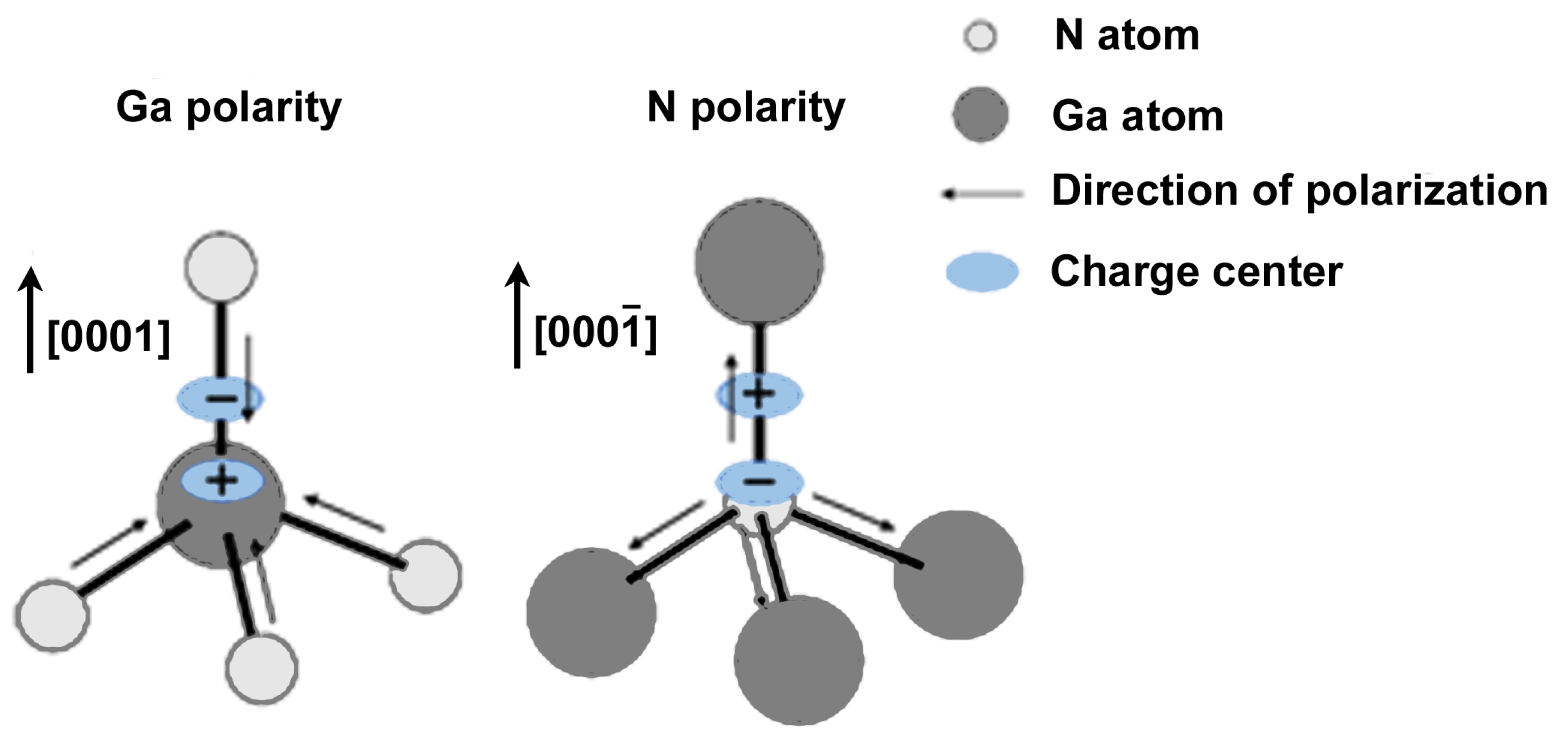
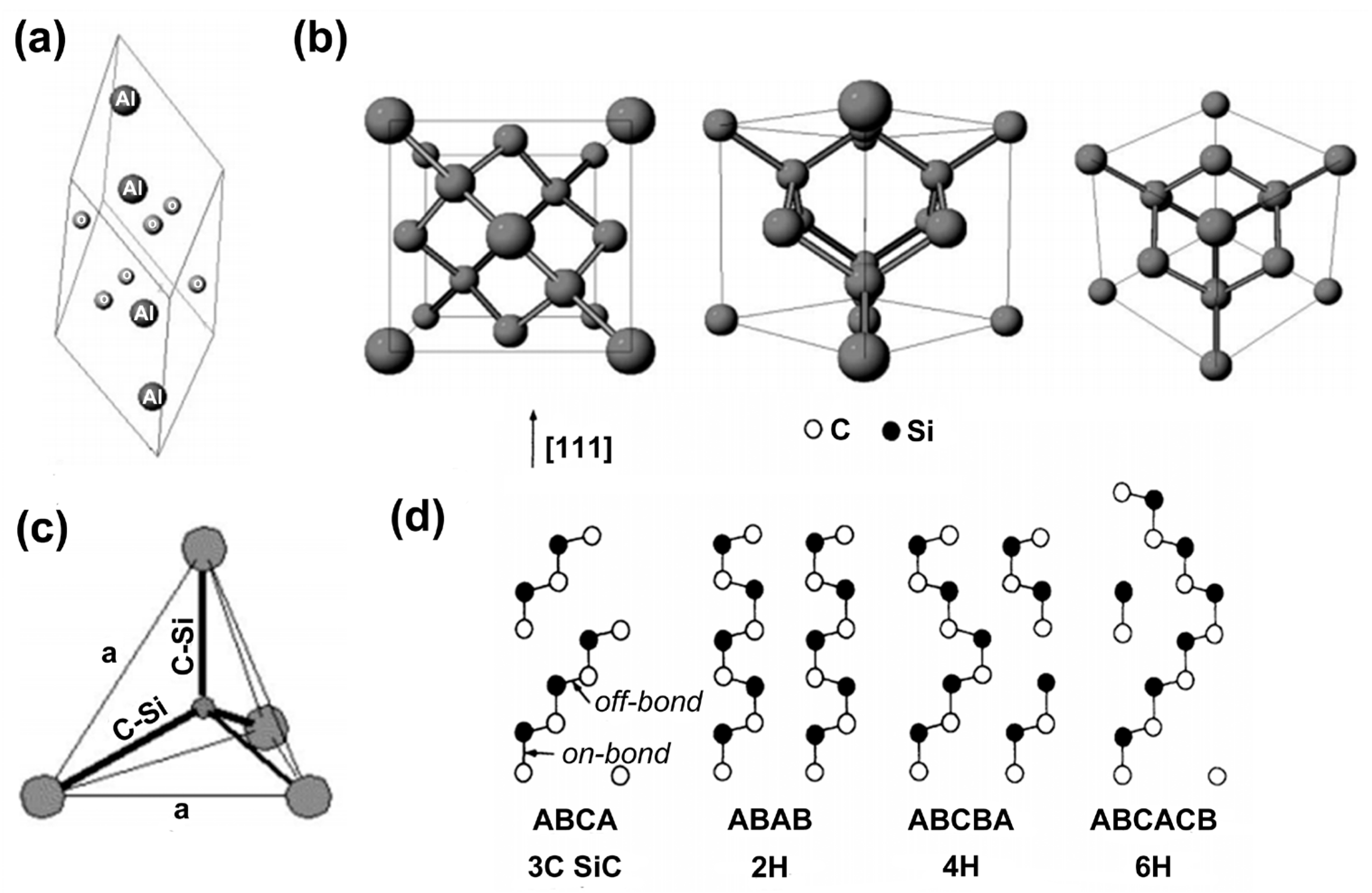

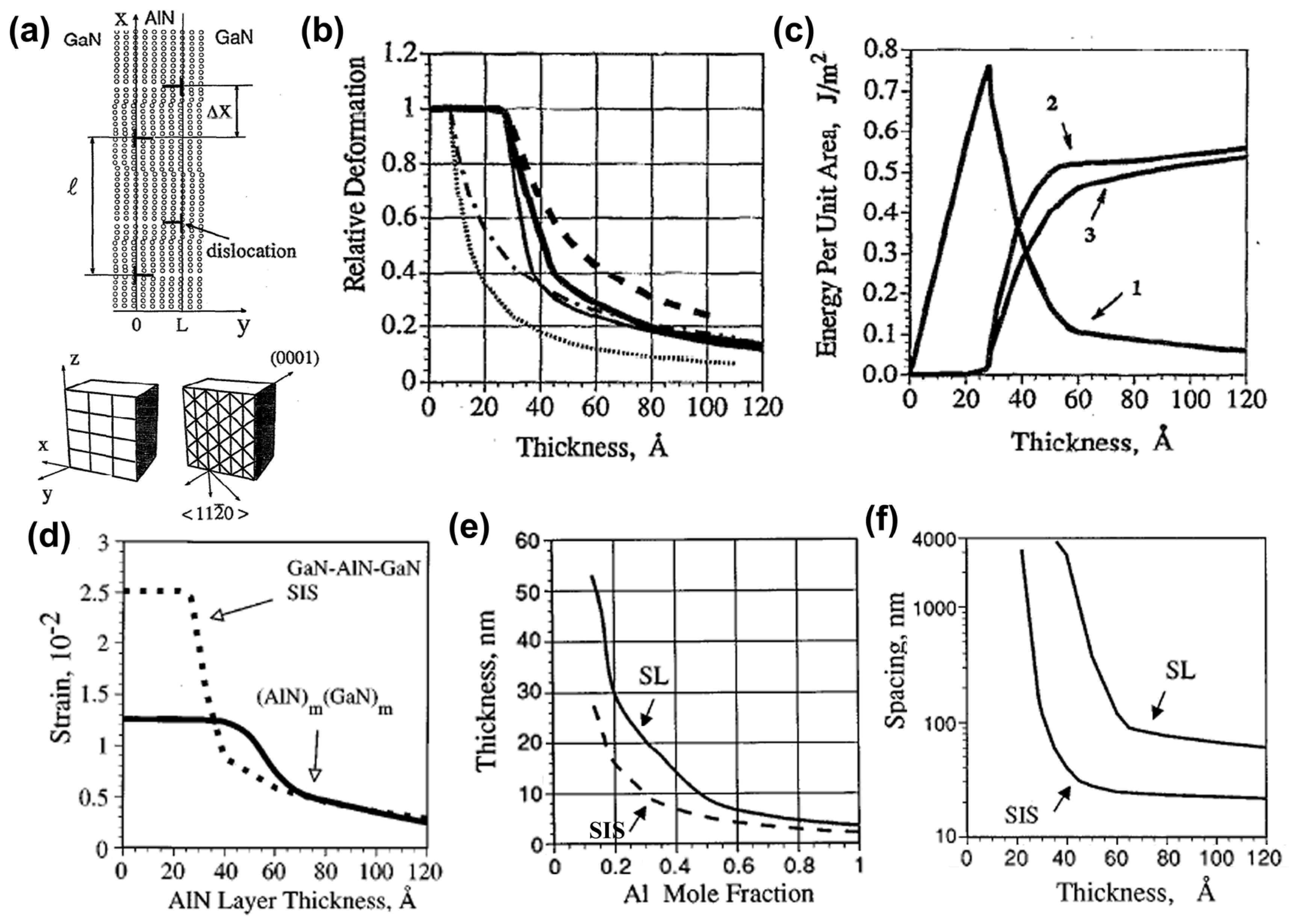
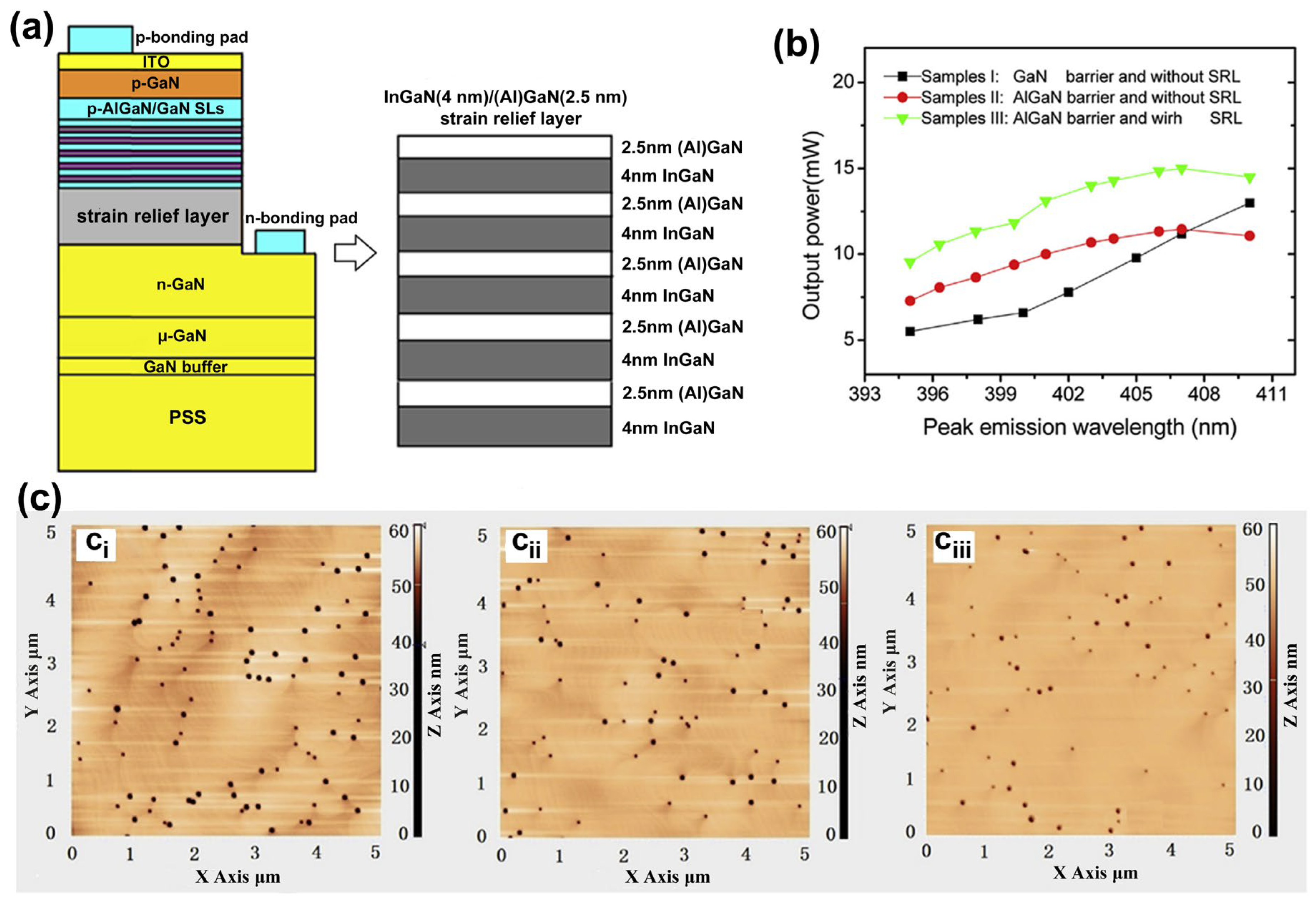

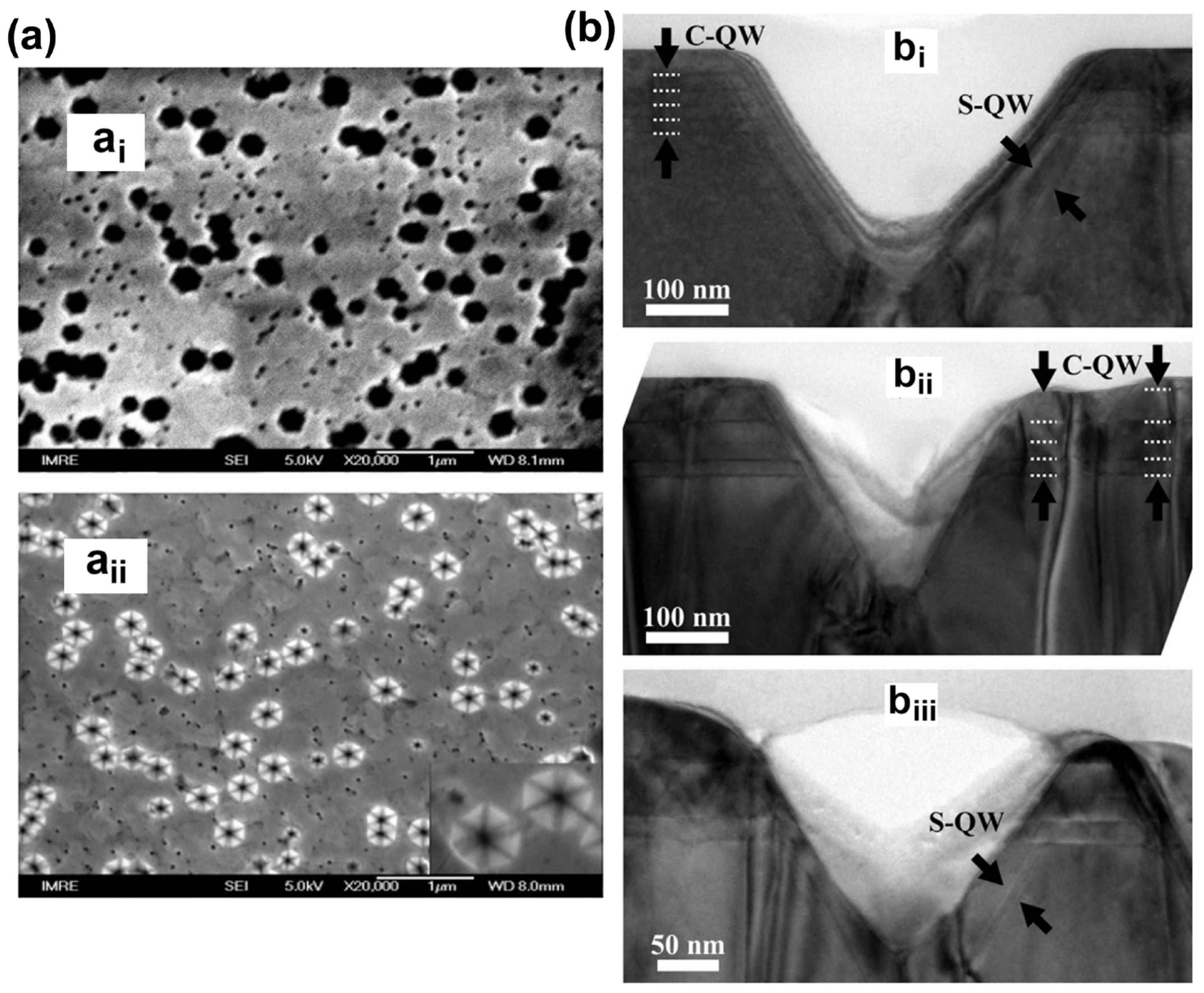
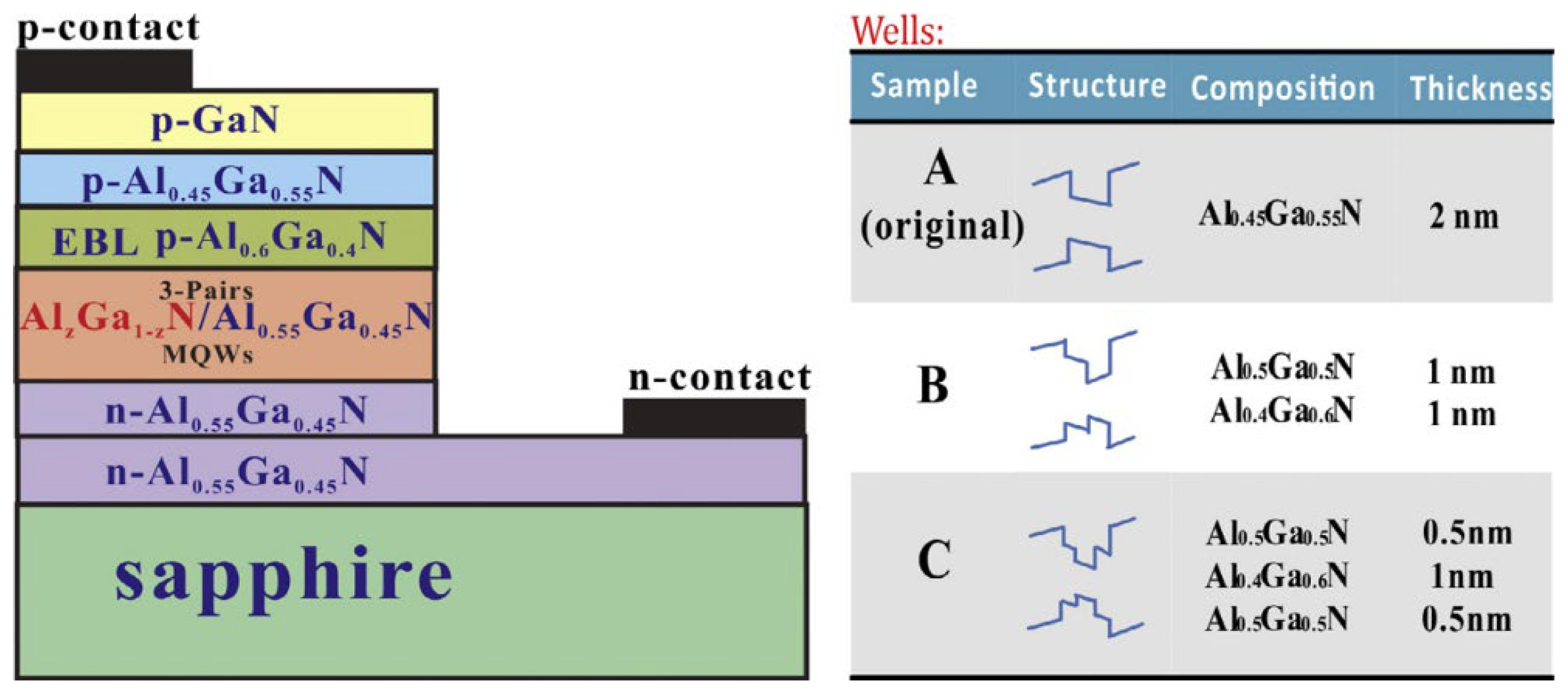
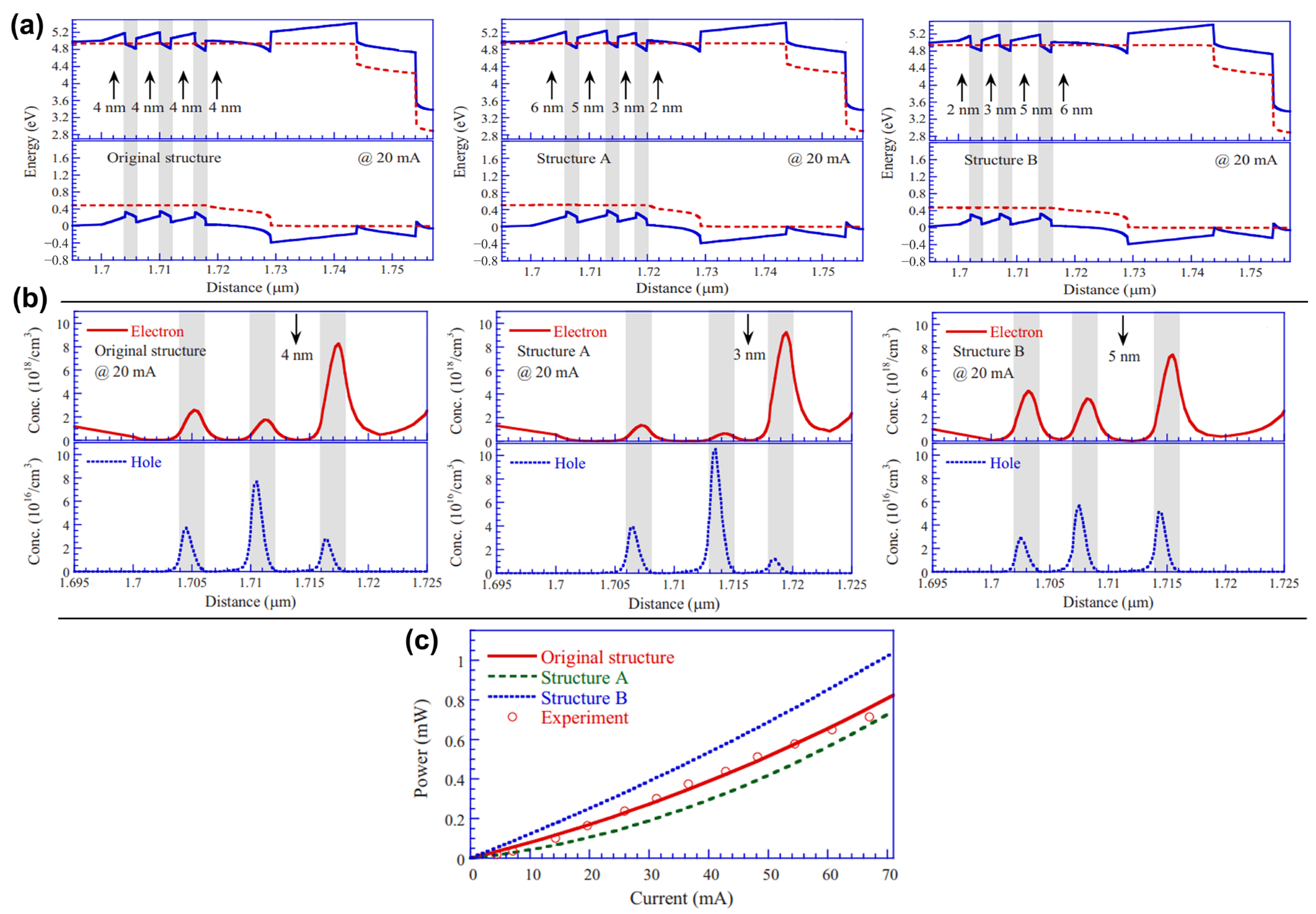


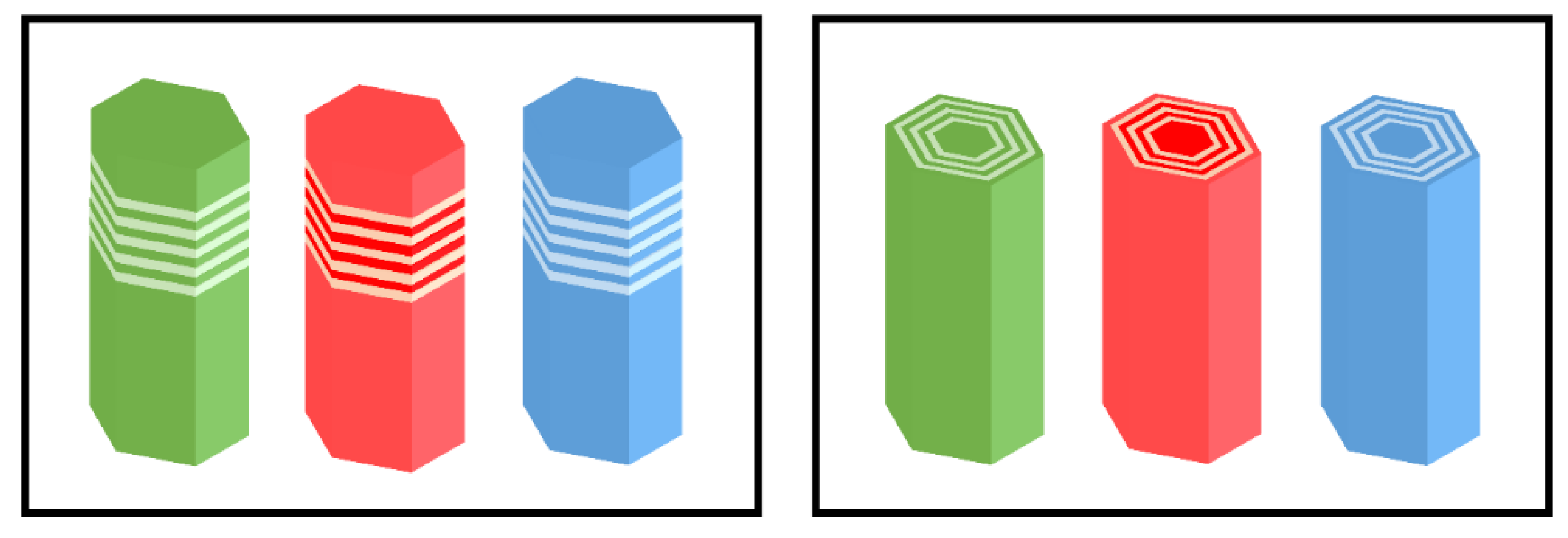
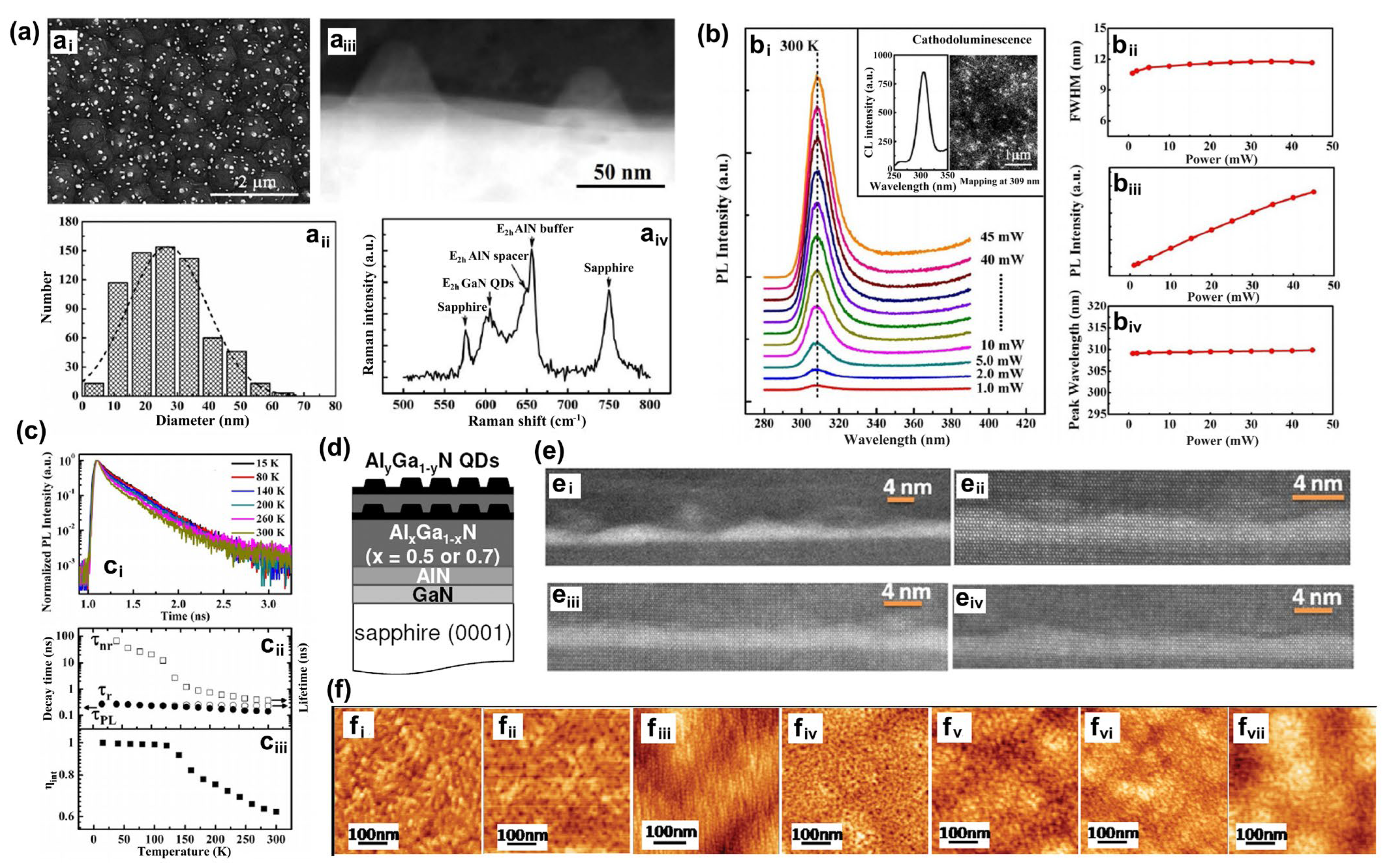
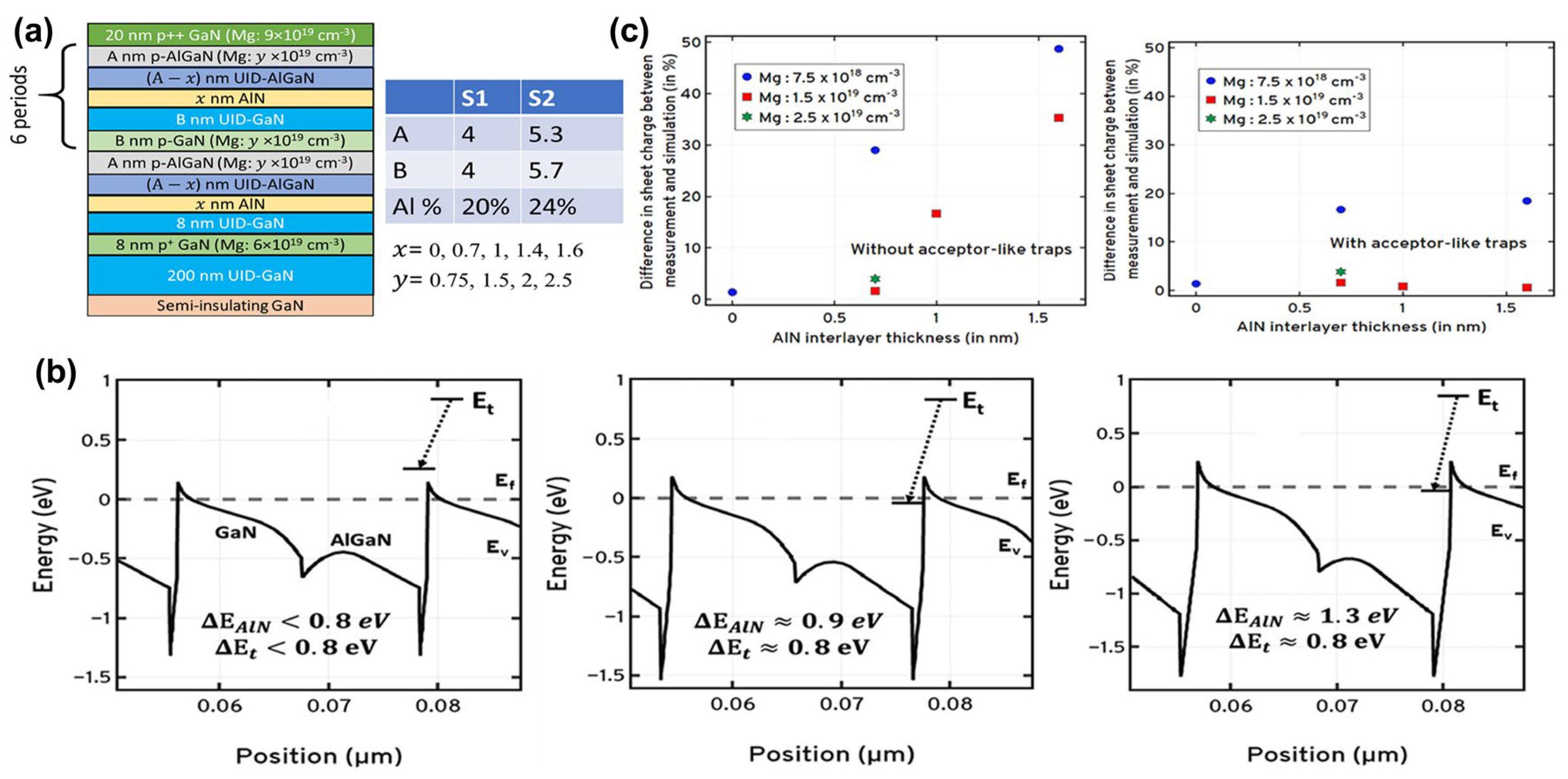
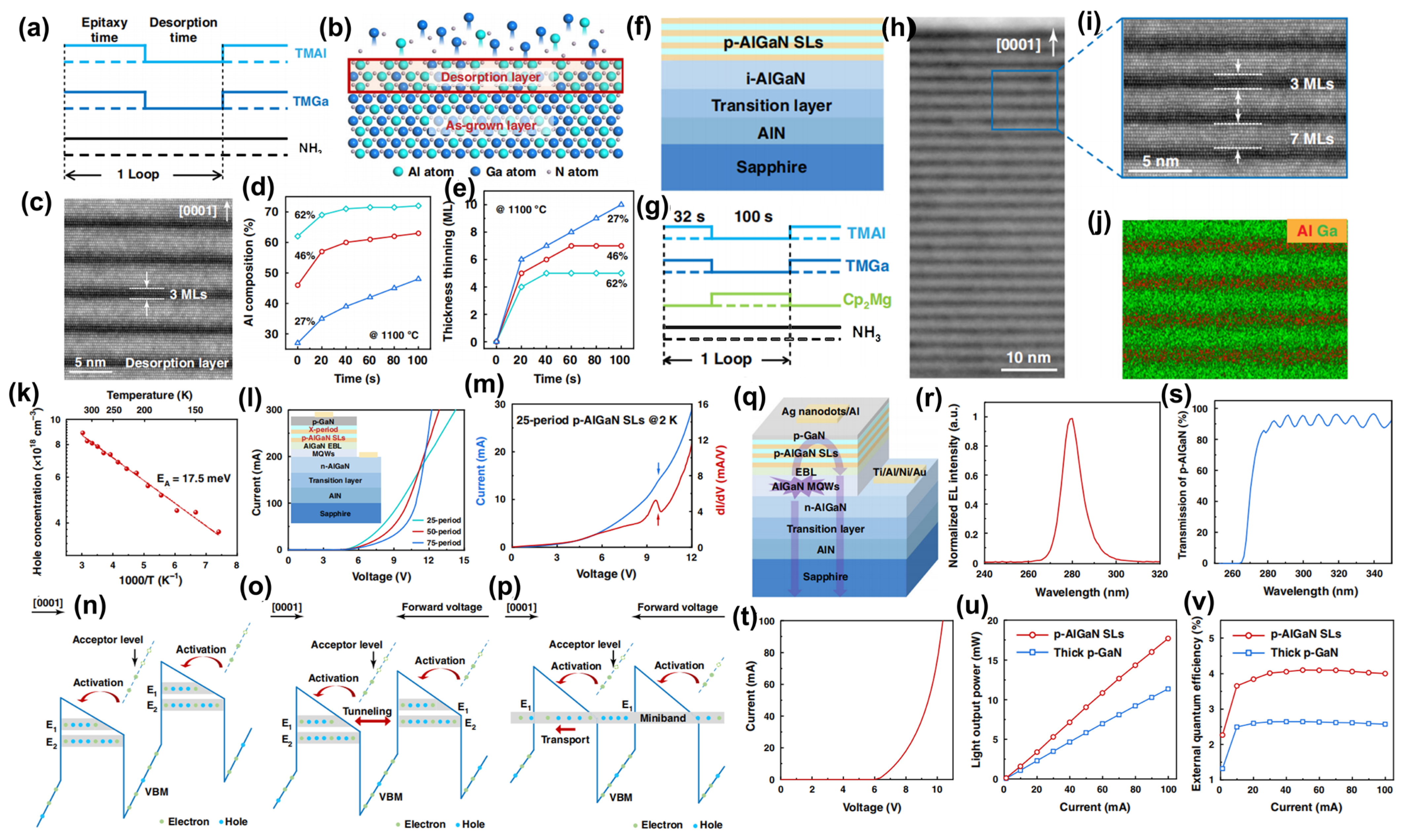






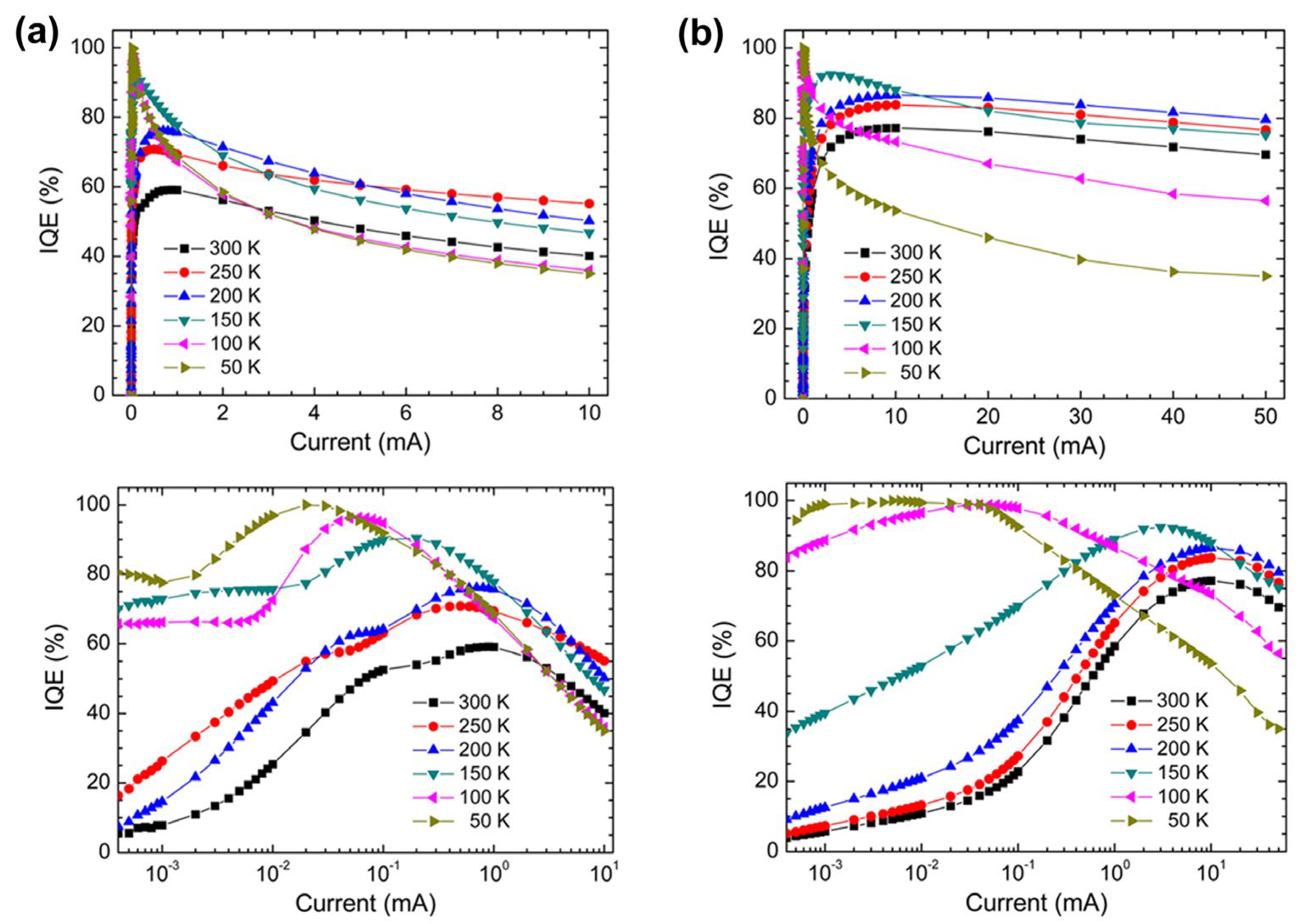
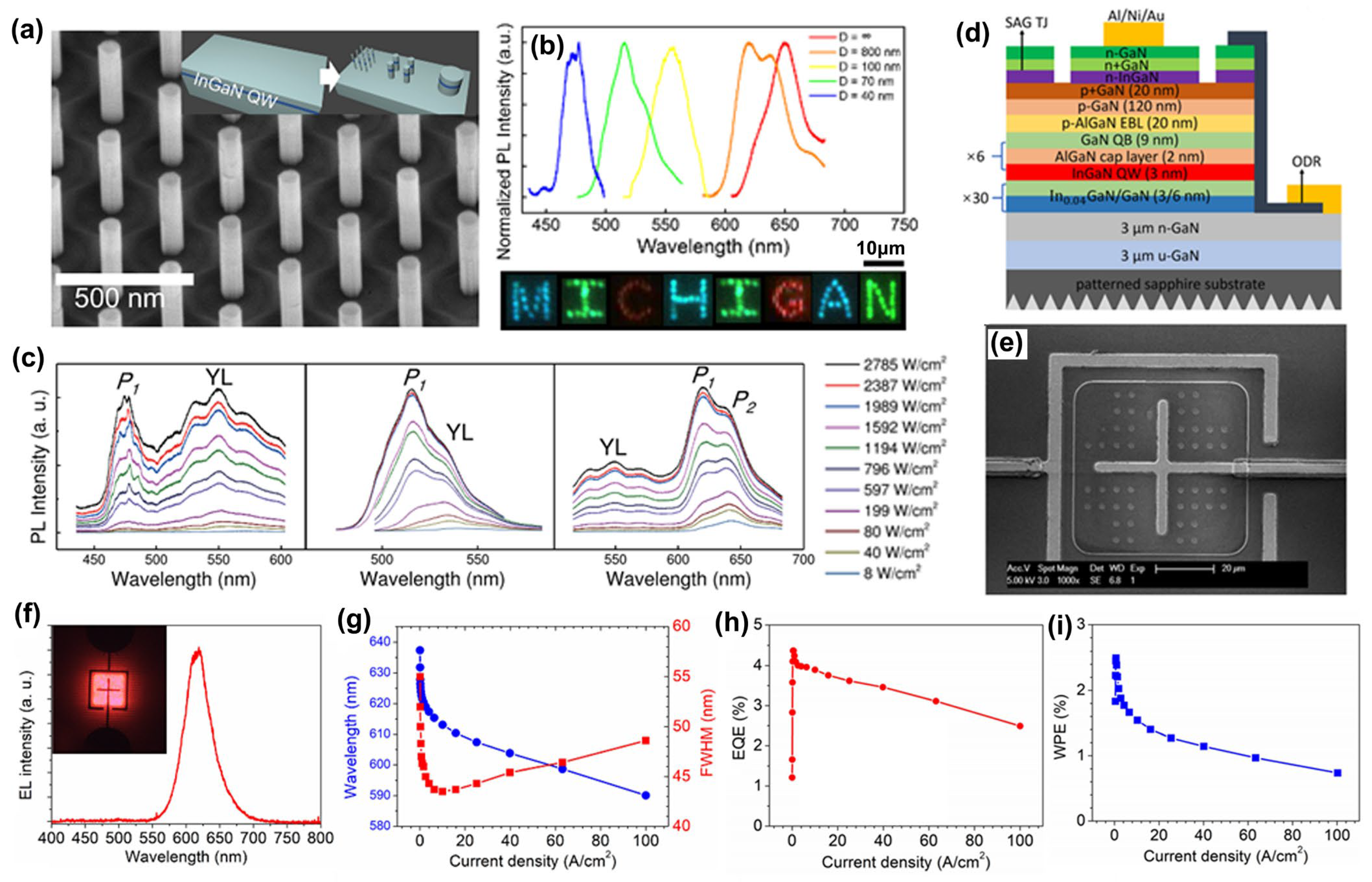

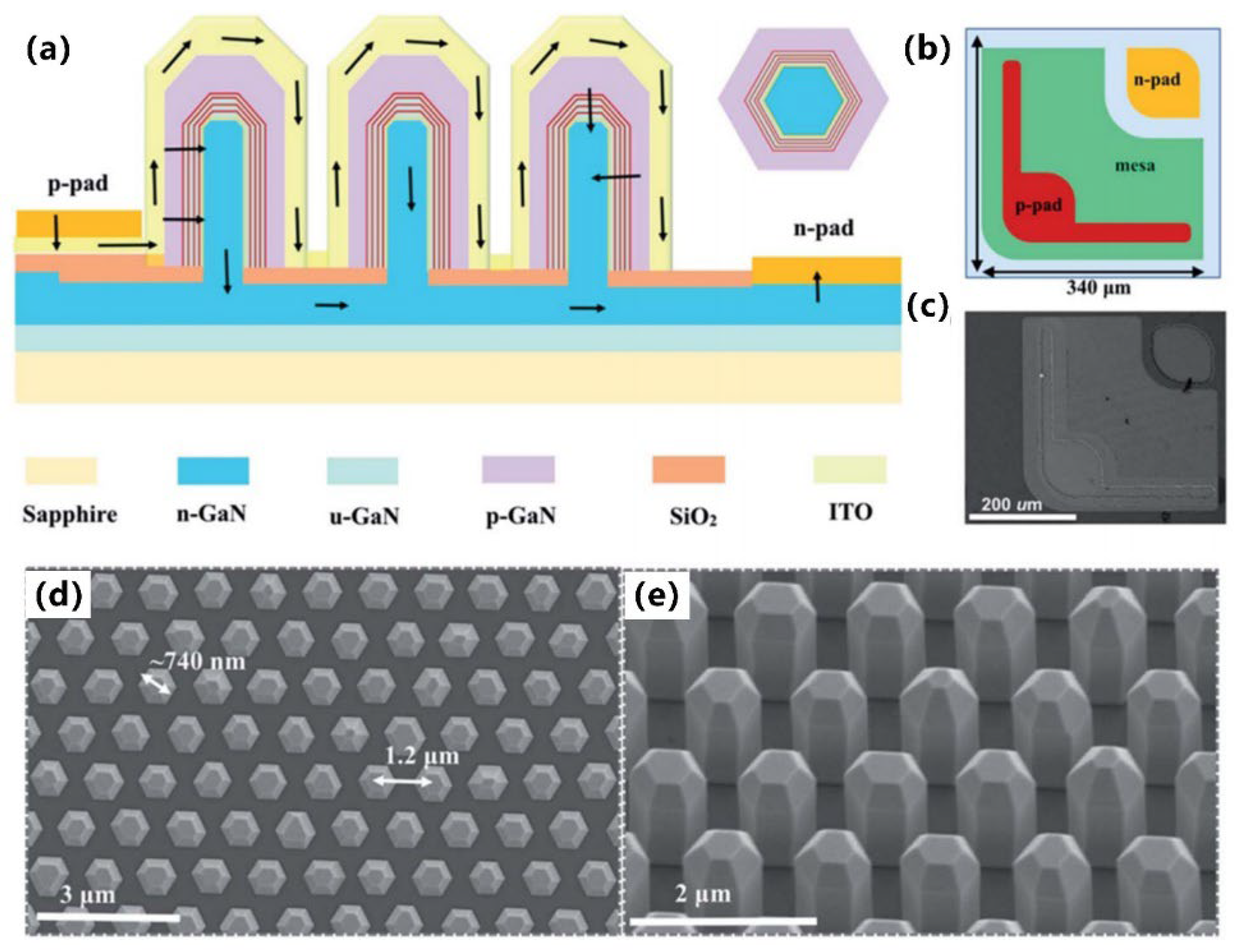
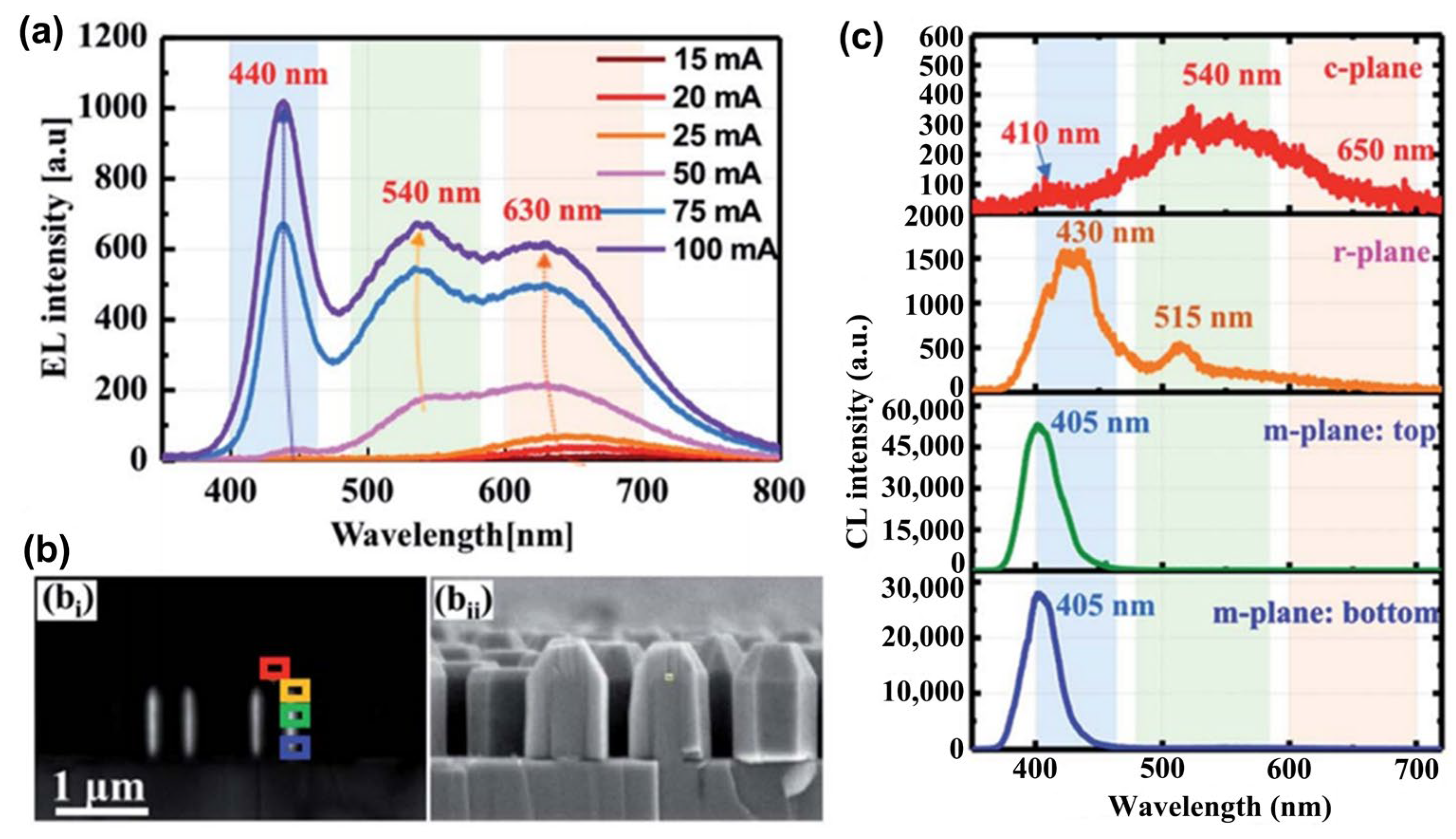
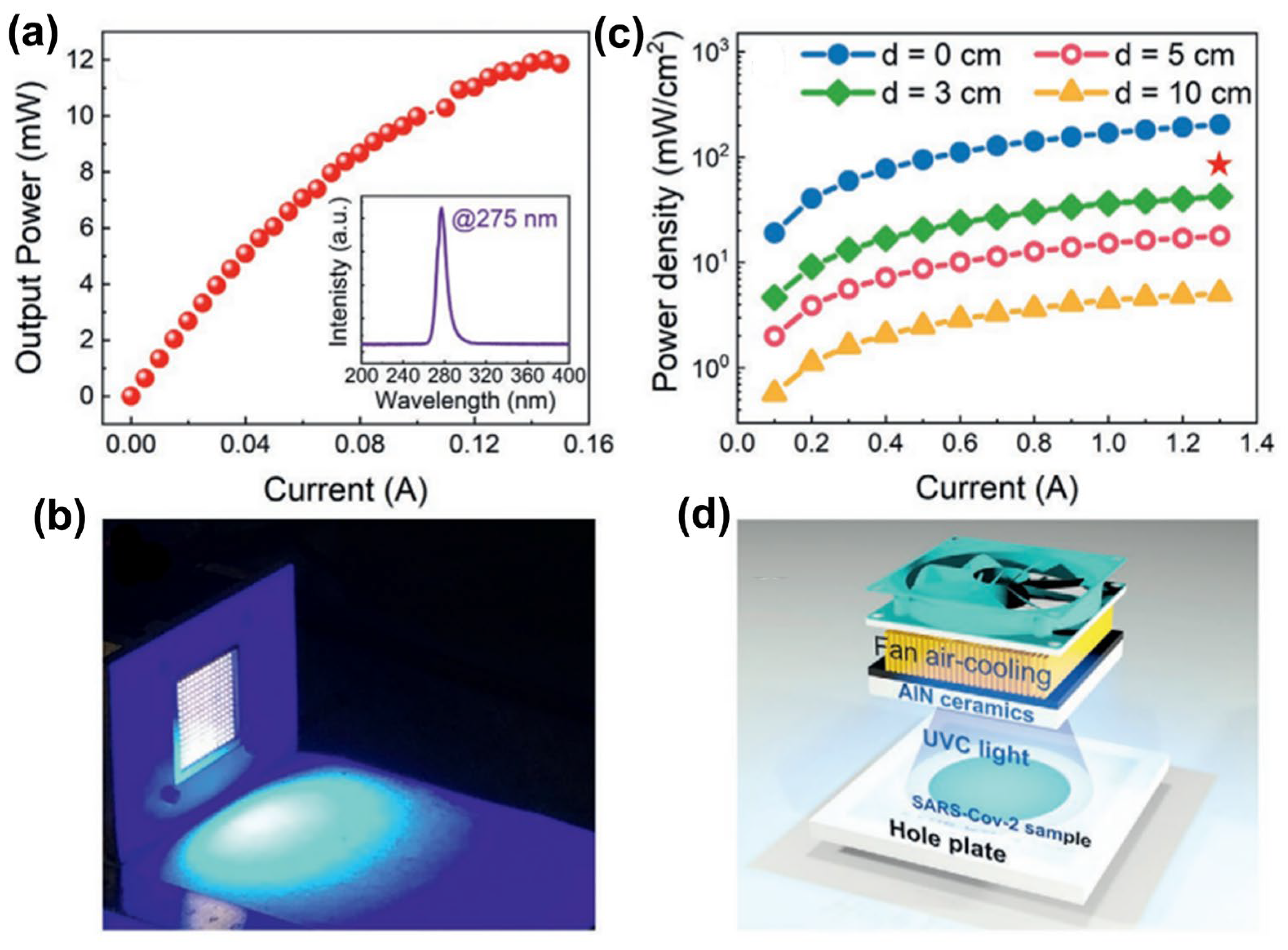

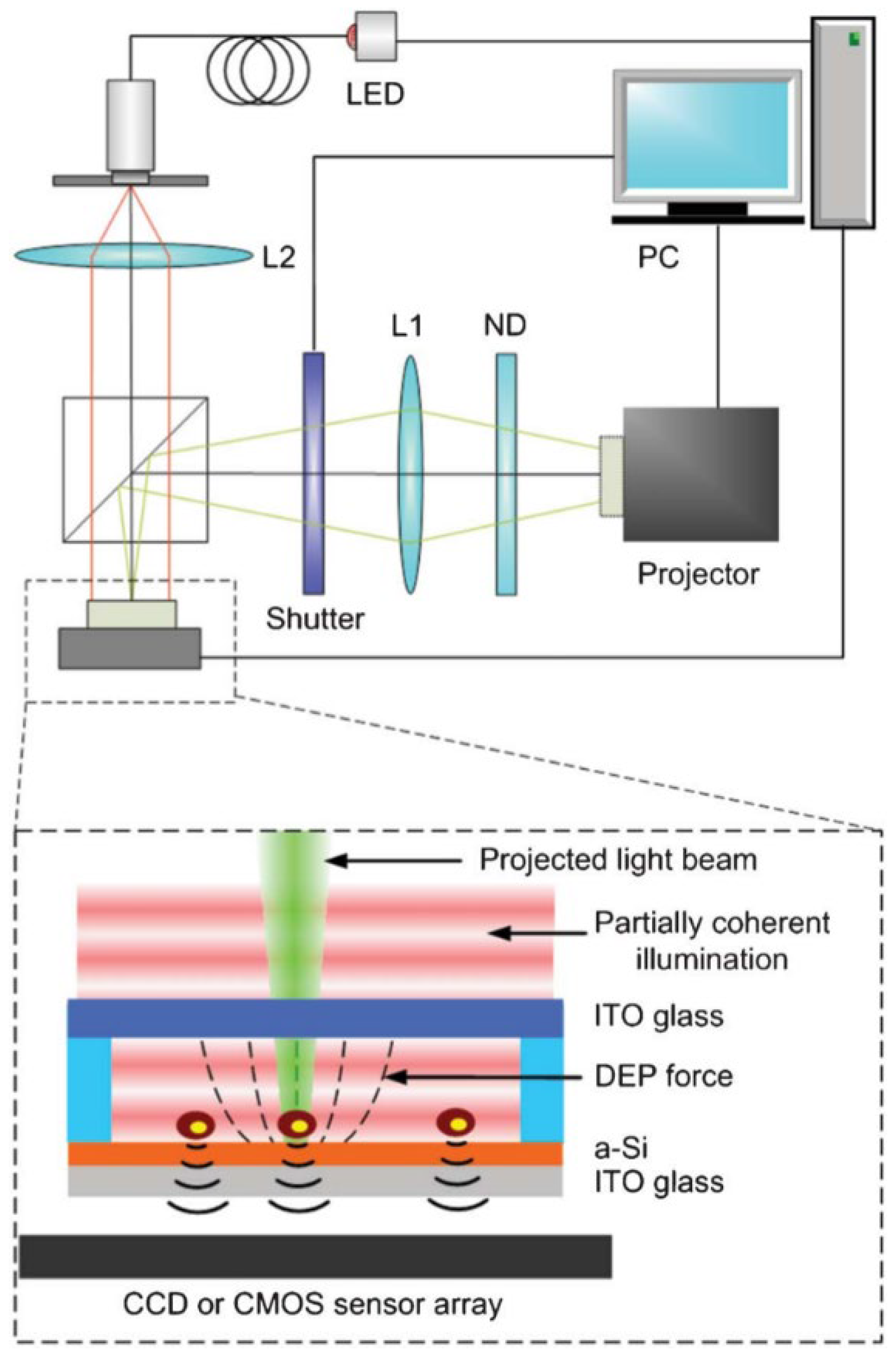
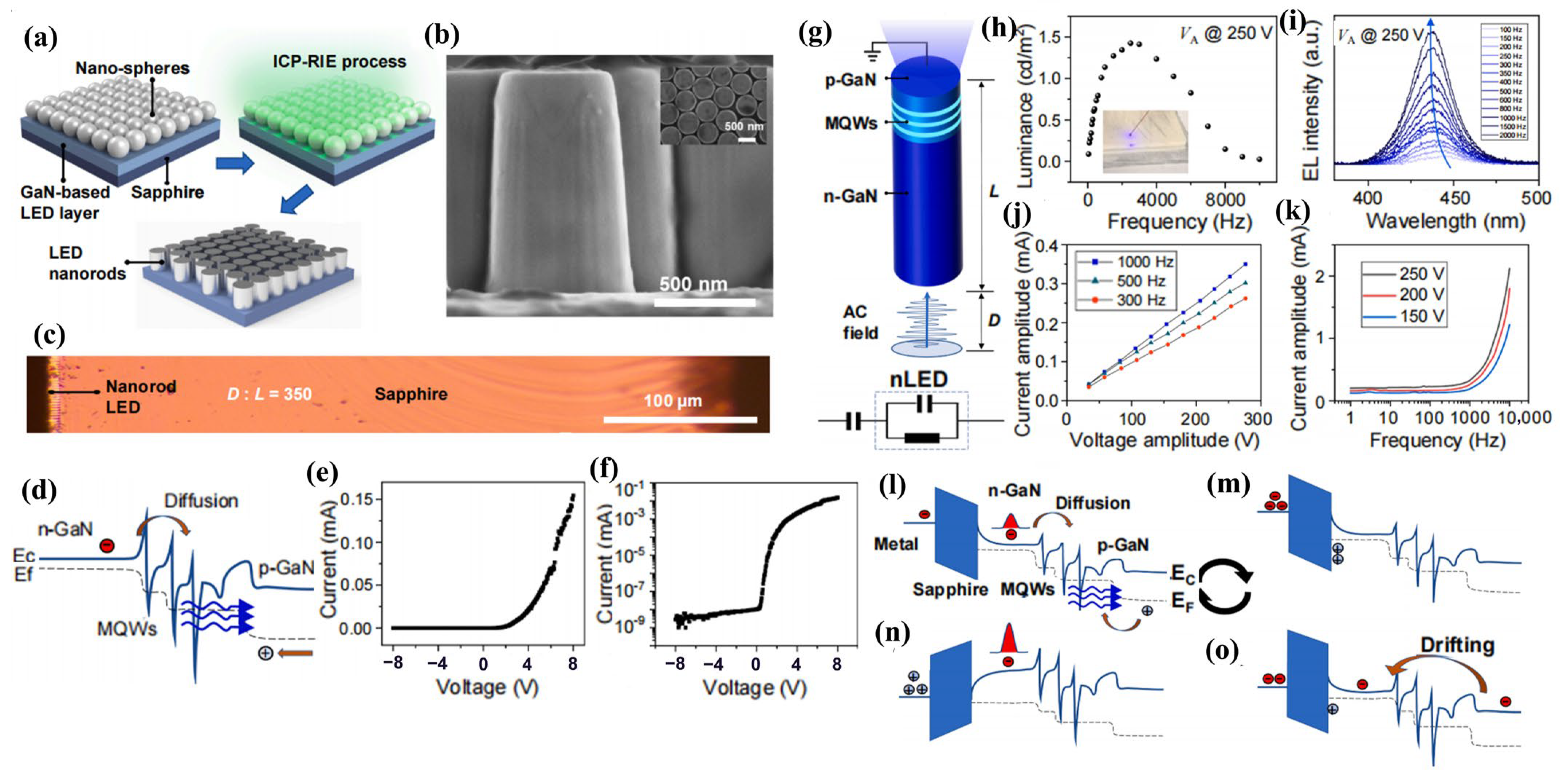

| Material | Substrate/Buffer Layer | Growth Method | Full Width at Half Maximum (FWHM) [arcsec] | FWHM [arcsec] | Others | Ref. |
|---|---|---|---|---|---|---|
| GaN | Sapphire/GaN | MOCVD and HVPE | 507 | 463 | --- | [34] |
| GaN | Sapphire/GaN | MOCVD and HVPE | 256 | 286 | Treatment by laser decomposition technique | [34] |
| GaN | Sapphire/--- | HVPE | 300 | 600 | Beveled substrate | [35] |
| GaN | Si/AlN and AlGaN | MOCVD and HVPE | 62 | --- | Threading dislocation density: 106/cm2. | [36] |
| GaN | 6H-SiC/GaN | HVPE | 261 | 272 | --- | [37] |
| GaN | Sapphire/AlN | MOCVD | 410 | --- | N-polar GaN | [38] |
| GaN | Sapphire/AlN and AlGaN | MOCVD | 35 | 220 | Patterned sapphire substrate | [39] |
| GaN | Si/AlN and AlGaN | MOCVD | 298 | 324 | --- | [40] |
| GaN | 4H-SiC/AlN and GaN | MOCVD | 144 | 306 | AlN interlayer | [41] |
| GaN | Sapphire/Graphene | MBE | 720 | 792 | Non-polar substrate/N-polar GaN | [42] |
| GaN | Si/GaN | MBE | 450 | --- | GaN nanowire buffer layer | [43] |
| GaN | 4H-SiC/--- | Plasma-assisted MBE | 159 | 848 | --- | [44] |
| AlN | Sapphire/--- | HVPE | 70 | 395 | --- | [45] |
| AlN | Sapphire/--- | HVPE | 102 | 219 | Patterned sapphire substrate | [45] |
| AlN | Si/--- | HVPE | 1292 | --- | Semi-polar AlN | [46] |
| AlN | 6H-SiC/--- | HVPE | 228 | 766 | --- | [47] |
| AlN | Sapphire/--- | MOCVD | 9 | 334 | Face-to-face annealed sputtered AlN | [48] |
| AlN | Sapphire/--- | MOCVD | 13 | 123 | Face-to-face annealed sputtered AlN/Beveled sapphire substrate | [49] |
| AlN | Si/--- | MOCVD | 409 | 677 | --- | [50] |
| AlN | 6H-SiC/--- | MOCVD | 17 | 246 | Face-to-face annealed sputtered AlN | [51] |
| AlN | 4H-SiC/--- | MOCVD | 355 | 840 | --- | [52] |
| AlN | Sapphire/--- | MBE | 103.6 | 353.1 | Face-to-face annealed sputtered AlN | [53] |
| AlN | Sapphire/AlN | MBE | 14 | 380 | N-polar AlN | [54] |
| AlN | Si/GaN | MBE | 972 | --- | GaN nanowire buffer layer/N-polar AlN | [35] |
| Al0.17Ga0.83N | Sapphire and GaN/--- | HVPE | --- | 600 | Beveled substrate | [49] |
| Al0.67Ga0.33N | Sapphire and AlN/AlGaN | HVPE | --- | 300 | Beveled substrate | [49] |
| Al0.68Ga0.32N | Sapphire and AlN/AlGaN | HVPE | --- | 300 | Patterned sapphire substrate | [49] |
| Al0.21Ga0.79N | Sapphire and AlN/GaN | MOCVD | 167.3 | 240.4 | Patterned sapphire substrate | [55] |
| Al0.74Ga0.26N | Sapphire and AlN/--- | MOCVD | 50 | 210–230 | Face-to-face annealed sputtered AlN/Beveled sapphire substrate | [56] |
| Al0.53Ga0.43N | Si and AlN/--- | MOCVD | 149 | --- | Pulsed co-doping | [57] |
| Al0.50Ga0.50N | 6H-SiC and AlN/AlGaN | MOCVD | 280 | 1028 | --- | [58] |
| Al0.50Ga0.50N | 6H-SiC and AlN/AlGaN | MOCVD | 235–240 | 766 | SiNX interlayer | [58] |
| Al0.23Ga0.77N | Sapphire and AlN/Graded AlXGa1−XN | MBE | 1569 | --- | Non-polar a-plane Al0.23Ga0.77N | [59] |
| Al0.6Ga0.4N | Sapphire and AlN/--- | MBE | 432 | --- | --- | [60] |
| Shape | Size [µm] | Depth/Height [µm] | Slanted Angle [°] | Density [cm−2] | FWHM [arcsec] | FWHM [arcsec] | Output Power [mW] | Quantum Efficiency [%] | Ref. |
|---|---|---|---|---|---|---|---|---|---|
| --- | --- | --- | --- | --- | --- | --- | 8.6 | 11.6 (External) | [64] |
| Round hole | 3 | 1.5 | 90 | --- | --- | --- | 10.4 | 14.1 (External) | [64] |
| Pyramid | --- | 1.2 | 57.4 | 4.31 × 107 | 269.3 | 410.3 | 15.2 | 56.5 (Internal) | [65] |
| Pyramid | --- | 1.2 | 45.3 | 1.11 × 107 | 264.1 | 356.6 | 17.2 | 60.7 (Internal) | [65] |
| Pyramid | --- | 1.2 | 38.3 | 0.87 × 107 | 251.1 | 312.6 | 18.5 | 61.6 (Internal) | [65] |
| Pyramid | --- | 1.2 | 36.1 | 0.52 × 107 | 243.4 | 301.2 | 20.8 | 66.1 (Internal) | [65] |
| --- | --- | --- | --- | --- | --- | 338 | 5.4 | --- | [66] |
| Cone | 3 | 1.5 | 45 | --- | --- | 225 | 7.3 | --- | [66] |
| --- | --- | --- | --- | --- | 410 | 560 | 7.93 | 12.59 (External) | [67] |
| --- | 3 | 1.5 | --- | 1 × 108 | 300 | 305 | 9.27 | 14.97 (External) | [67] |
| --- | 2 | 1.5 | --- | 1 × 108 | 300 | 305 | 9.53 | 15.28 (External) | [67] |
| --- | 0.45 | 0.15 | --- | 3.5 × 108 | 330 | 380 | 10.27 | 16.39 (External) | [67] |
| AlN Sample | Substrate | AlN Template Layer Structure Thickness [nm] | FWHM [arcsec] | FWHM [arcsec] | Root Means Square (RMS) [nm] | Ref. | |||
|---|---|---|---|---|---|---|---|---|---|
| Low-Temperature Nucleation Layer | High-Temperature Growth Layer | Intermediate Epitaxial Layer | High-Temperature Growth Layer | ||||||
| Two-step growth method | Conventional sapphire substrate | 35 (950 °C) | 1010 (1280 °C) | --- | --- | 109 | 751 | 0.463 | [72] |
| Three-step growth method | Conventional sapphire substrate | 35 (950 °C) | 20 (1280 °C) | 60 (1050 °C) | 750 (1280 °C) | 100 | 738 | 0.121 | [72] |
| Two-step growth method | Patterned sapphire substrate | 3 (870 °C) | 700 (1110 °C) | --- | --- | 795 | 2160 | 0.3 | [73] |
| Two-step growth method | Patterned sapphire substrate | 3 (870 °C) | 700 (1250 °C) | 65 | 1150 | 1.2 | [73] | ||
| Three-step growth method | Patterned sapphire substrate | 3 | --- | 150 (1250 °C) | 3200 (1110 °C) | 50 | 250 | 0.5 | [73] |
| Three-step growth method | Conventional sapphire substrate | 3 | --- | 150 (1250 °C) | 3200 (1110 °C) | 400 | 800 | 0.2 | [73] |
| Doped Material | Doping Method | Hole Concentration [1017/cm3] | Hole Mobility [cm2/V·s] | Others | Year | Ref. |
|---|---|---|---|---|---|---|
| GaN | Thermal annealing | 3 | 10 | --- | 1992 | [279] |
| Al0.4Ga0.6N | Thermal annealing | 3.26 | -- | --- | 2015 | [294] |
| Al0.4Ga0.6N | Delta doping | 15.9 | --- | --- | 2015 | [294] |
| Al0.4Ga0.6N | Delta doping | 47.5 | --- | Indium-surfactant-assisted | 2015 | [294] |
| Al0.42Ga0.58N | Delta doping | 49.7 | 1.35 | Indium-surfactant-assisted | 2020 | [295] |
| Al0.42Ga0.58N | Delta doping | 4.61 | 2.52 | Indium-surfactant-assisted/Pulsed TMAl flow | 2020 | [295] |
| Al0.42Ga0.58N | Delta doping | 83 | 1.47 | Indium-surfactant-assisted/Pulsed TMGa flow | 2020 | [295] |
| Al0.46Ga0.54N/Al0.63Ga0.37N | Superlattice doping | 81 | --- | Desorption-tailoring strategy | 2022 | [287] |
| B0.14Al0.86N/Al0.5Ga0.5N | Strain-compensated B0.14Al0.86N/Al0.5Ga0.5N polarization-induced superlattice doping | 80.7 | --- | Simulated result | 2022 | [302] |
| Al0.6Ga0.4N | Delta doping with the Al0.6Ga0.4N/GaN superlattice modulation doping | 5.1 | 4.7 | Indium-surfactant-assisted | 2019 | [296] |
| Al0.75Ga0.25N/AlN | Superlattice doping | 34 | -- | -- | 2018 | [286] |
| AlN/GaN | Polarization-induced doping | 5 × 10−4 | 25 | Dopant free | 2019 | [300] |
| AlxGa1−xN (x:0 to 0.3) | Polarization-induced doping | 19 | --- | --- | 2022 | [301] |
| Al0.3Ga0.7N/Al0.15Ga0.85N | Nanowire doping | 130 | --- | --- | 2018 | [304] |
| Peak Wavelength [nm] | Active Region | EQE [%] | WPE [%] | Single Pixel Size [μm] | Ligh Output Power [mW] | Power Density [W/cm2] | Ref. |
|---|---|---|---|---|---|---|---|
| 228 | Al0.82Ga0.18N/Al0.94Ga0.06N MQW | --- | --- | 400 | 1.4 (at 150 mA) | Around 0.88 | [411] |
| 232 | --- | 0.57 | --- | --- | 4.2 (at 200 mA) | --- | [412] |
| 254 | Al0.64Ga0.36N/Al0.78Ga0.22N MQW | 1.2 | --- | 350 | 3.2 (at 75 mA) | Around 2.61 | [413] |
| 258 | Al0.6Ga0.4N/Al0.74Ga0.26N MQW | 2.2 | --- | 350 | 7 (at 75 mA) | Around 5.71 | [414] |
| 265 | Al0.6Ga0.4N/AlxGa1−xN (x > 0.6) MQW | 11 | 7.6 | --- | --- | --- | [354] |
| 275 | Al0.4Ga0.6N/Al0.55Ga0.45N MQW | 20.3 | --- | --- | 18.3 (at 20 mA) | --- | [353] |
| 275 | Al0.4Ga0.6N/Al0.55Ga0.45N MQW | --- | --- | --- | 44.2 (at 50 mA) | --- | [353] |
| 275 | Al0.45Ga0.55N/Al0.6Ga0.4N MQW | 1.2 | --- | 20 | Around 0.15 (at around 6 mA) | 86 | [414] |
| 278 | Al0.39Ga0.61N/Al0.6Ga0.4N MQW | --- | --- | --- | 8 (at around 100 mA) | 8.2 | [415] |
Disclaimer/Publisher’s Note: The statements, opinions and data contained in all publications are solely those of the individual author(s) and contributor(s) and not of MDPI and/or the editor(s). MDPI and/or the editor(s) disclaim responsibility for any injury to people or property resulting from any ideas, methods, instructions or products referred to in the content. |
© 2024 by the authors. Licensee MDPI, Basel, Switzerland. This article is an open access article distributed under the terms and conditions of the Creative Commons Attribution (CC BY) license (https://creativecommons.org/licenses/by/4.0/).
Share and Cite
Fan, X.; Shi, J.; Chen, Y.; Miao, G.; Jiang, H.; Song, H. A Comprehensive Review of Group-III Nitride Light-Emitting Diodes: From Millimeter to Micro-Nanometer Scales. Micromachines 2024, 15, 1188. https://doi.org/10.3390/mi15101188
Fan X, Shi J, Chen Y, Miao G, Jiang H, Song H. A Comprehensive Review of Group-III Nitride Light-Emitting Diodes: From Millimeter to Micro-Nanometer Scales. Micromachines. 2024; 15(10):1188. https://doi.org/10.3390/mi15101188
Chicago/Turabian StyleFan, Xinye, Jiawang Shi, Yiren Chen, Guoqing Miao, Hong Jiang, and Hang Song. 2024. "A Comprehensive Review of Group-III Nitride Light-Emitting Diodes: From Millimeter to Micro-Nanometer Scales" Micromachines 15, no. 10: 1188. https://doi.org/10.3390/mi15101188







